John Lennon, a name synonymous with musical innovation and cultural impact, wielded guitars that became as legendary as his songs. From his humble beginnings in Liverpool to global stardom with The Beatles and a celebrated solo career, Lennon’s guitar choices played a crucial role in shaping his distinctive sound and songwriting. This article delves into the fascinating world of John Lennon Guitars, exploring the instruments that accompanied him on his unparalleled musical journey.
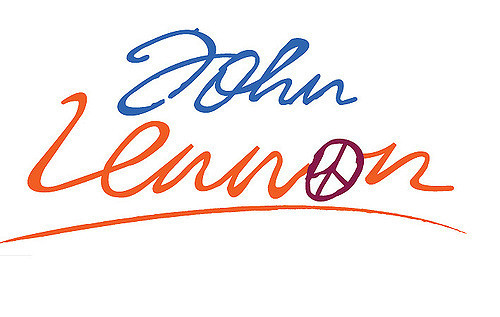 john-logo
john-logo
Lennon’s guitar story began with simple acoustics and evolved to embrace a range of electric models, each contributing to different phases of his career. His instruments weren’t just tools; they were partners in creativity, bearing witness to the birth of countless timeless melodies and groundbreaking sounds that defined generations.
 imageslike.com-large-music-the-quarrymen-plus-their-instruments
imageslike.com-large-music-the-quarrymen-plus-their-instruments
Early Days and Humble Beginnings
Gallotone Champion: The First Strummings
The Gallotone Champion holds a special place in the John Lennon guitar story as his very first guitar. Purchased through a mail-order advertisement in Reveille magazine for approximately £10, this South African-made acoustic guitar was advertised as “Guaranteed Not to Split,” a testament to its no-frills construction. Legend has it that to avoid his Aunt Mimi’s disapproval, the delivery was made to his supportive mother, Julia Lennon.
 gally1
gally1
Julia, who played the banjo, taught young John a few chords, which he adapted to the guitar, initially leaving the sixth string slack. This Gallotone became the instrument with which Lennon formed his first band, The Black Jacks, later evolving into the Quarrymen. It was on this very guitar that Lennon played at the St. Peter’s Parish Fete in 1957, the pivotal event where he met Paul McCartney, marking the genesis of The Beatles. Conflicting accounts exist regarding the guitar’s purchase, with some suggesting it was Jim Gretty from Hessy’s Music who sold it to Aunt Mimi for John. Regardless, the Gallotone Champion served as the foundation for Lennon’s musical journey.
The whereabouts of this historically significant guitar remained a mystery for years. Reportedly, Lennon left it with Aunt Mimi for safekeeping when The Beatles achieved fame. Mimi later donated it, and it eventually surfaced at auction. A brass plaque, added by Mimi, bore her famous words to a young Lennon: “Remember, you’ll never earn your living by it,” a poignant reminder of his humble beginnings.
 john-lennon-j-160e-gibson-acoustic-guitar-auction-761.jpg
john-lennon-j-160e-gibson-acoustic-guitar-auction-761.jpg
 gallotone-student-4__93024.1377473152.1280.1280
gallotone-student-4__93024.1377473152.1280.1280
In 1999, the Gallotone Champion was auctioned at Sotheby’s London, fetching £155,000. A portion of the proceeds was donated to the Olive Mount Learning Disabilities Directorate in Liverpool, adding a charitable dimension to the guitar’s legacy. For a time, it was displayed at Boston’s Museum of Fine Arts, allowing fans to glimpse this foundational piece of Beatles history.
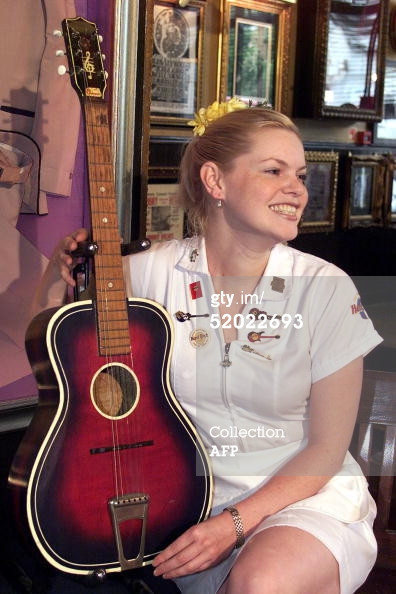 Gallotone
Gallotone
Dallas Tuxedo: The Manchester Mystery Guitar
The Dallas Tuxedo, a tobacco-sunburst solid-body electric guitar, remains shrouded in mystery and rumor. The story goes that in November 1958, during Johnny and the Moondogs’ trip to Manchester for a talent show, Lennon acquired this guitar under questionable circumstances. Both Paul McCartney and George Harrison hinted that Lennon may have stolen it from another act, a claim Paul reiterated in the Beatles Anthology.
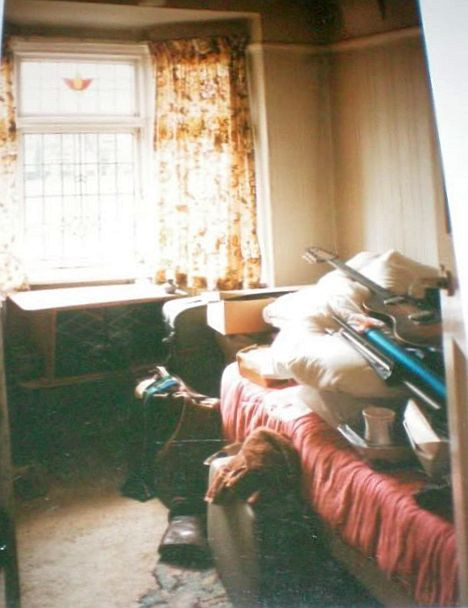 tuxedo06
tuxedo06
 tuxedo2
tuxedo2
This British-made electric guitar, one of the earliest from the UK, became known as the “Manchester Mystery Guitar.” Lennon reportedly hid it in the loft of his home, Mendips, and was never photographed with it. It remained unseen until 1996 when workmen discovered it in the loft, along with banjo magazines. Ernie Burkey, the homeowner, later gifted it to Beatles enthusiasts Johnny “Guitar” Byrne and Larry Wassgren, who believed it to be the legendary “stolen” guitar.
While no definitive proof links this Dallas Tuxedo to the Manchester incident, it remains a strong candidate. However, Beatles archivist Mark Lewisohn suggests a different version, citing a witness who described Lennon’s acquired guitar that night as “a complete piece of rubbish.” The true identity of the “Manchester Mystery Guitar” and its fate remain uncertain, adding an intriguing chapter to the John Lennon guitar narrative.
The Rise to Fame: Hofner and Rickenbacker Era
Hofner Senator: A Hamburg Enigma
The Hofner Senator remains an obscure chapter in John Lennon’s guitar history. Despite being purchased during The Beatles’ Hamburg days, no photographic evidence exists of Lennon playing this guitar, and he never publicly mentioned owning one. Adding to the confusion, an “authenticating” photo provided to a buyer actually depicted Lennon with his Epiphone Casino, a completely different guitar.
 snip20171225_2.png
snip20171225_2.png
Ken Brown, a former Quarrymen member who owned a Senator himself, couldn’t recall Lennon owning one during their time together, though he acknowledged Lennon might have acquired it later. George Harrison’s verification of the guitar’s provenance in a letter to Lily Evans lends some credibility to its Lennon connection. Harrison’s guitar expertise and memory for detail were highly regarded by those around him.
The Hofner Senator surfaced at a Christie’s auction in 2009, fetching $337,226. It is currently part of the AEI Music collection in Seattle, Washington, and has been loaned to the Rock and Roll Hall of Fame, offering glimpses into a lesser-known instrument in Lennon’s arsenal.
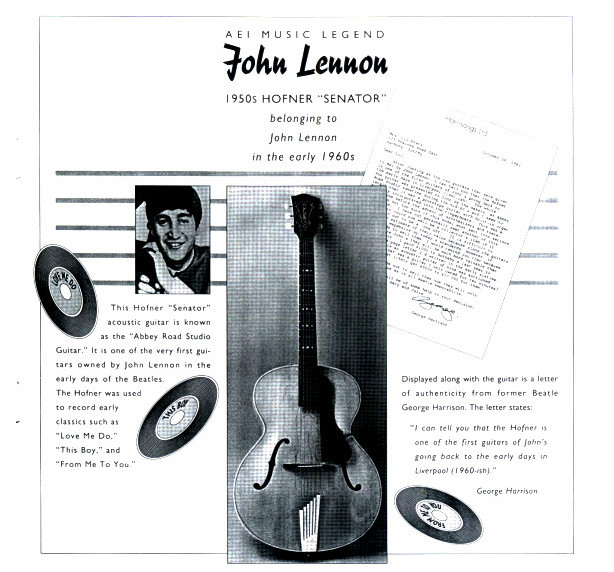 snip20170330_1.png
snip20170330_1.png
Hofner Club 40: The Casbah Days Companion
The Hofner Club 40 marks a more documented phase in Lennon’s early guitar journey. Purchased just before The Beatles’ first performance at the Casbah Coffee Club, a hire-purchase receipt dated August 28, 1959, confirms the acquisition. The receipt from Hessy’s Music shop details a “Club 40 Hofner guitar” sold to John Lennon, described as a “student,” with his Aunt Mimi as the guarantor and a £17 deposit.
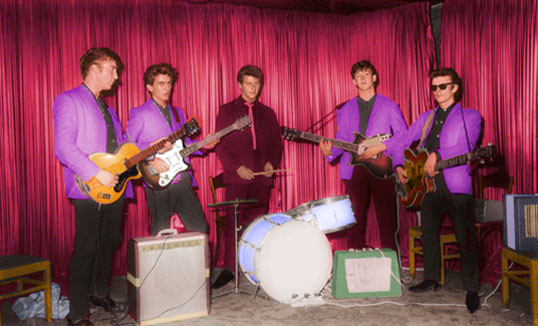 indracolour
indracolour
This purchase receipt dispels the myth that Mimi bought Lennon his “first guitar” for £17, instead highlighting her support in enabling him to acquire a better instrument. The Hofner Club 40 became Lennon’s primary guitar during The Beatles’ formative performances at the Casbah Coffee Club.
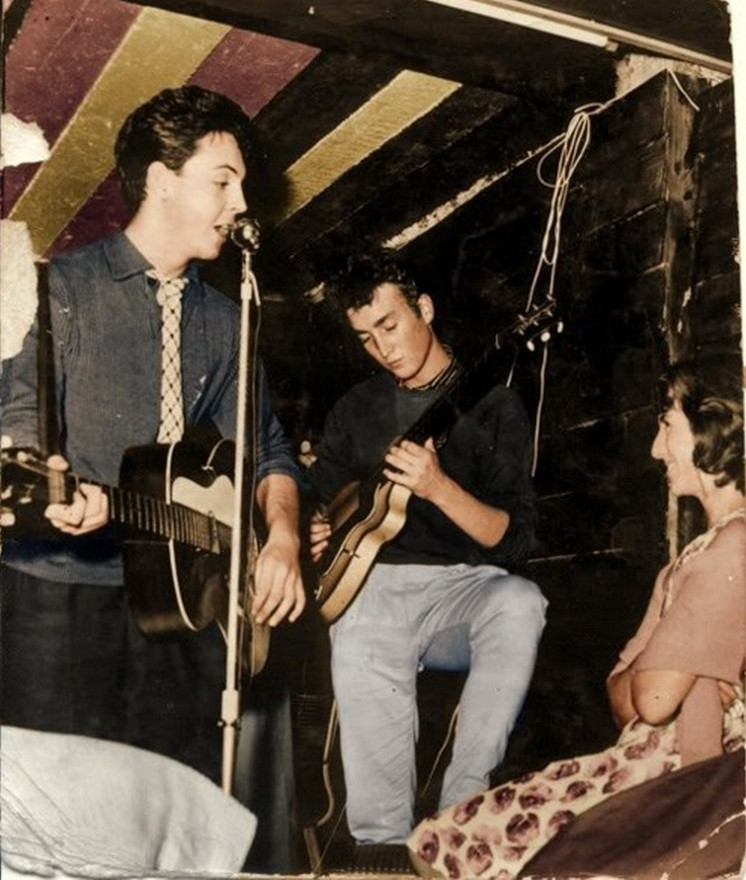 SilverBeatles
SilverBeatles
To commemorate Hofner’s 120th anniversary in 2007, they released a limited edition “John Lennon” Club 40 guitar, with only 120 produced worldwide, underscoring the historical significance of this model in Lennon’s early career.
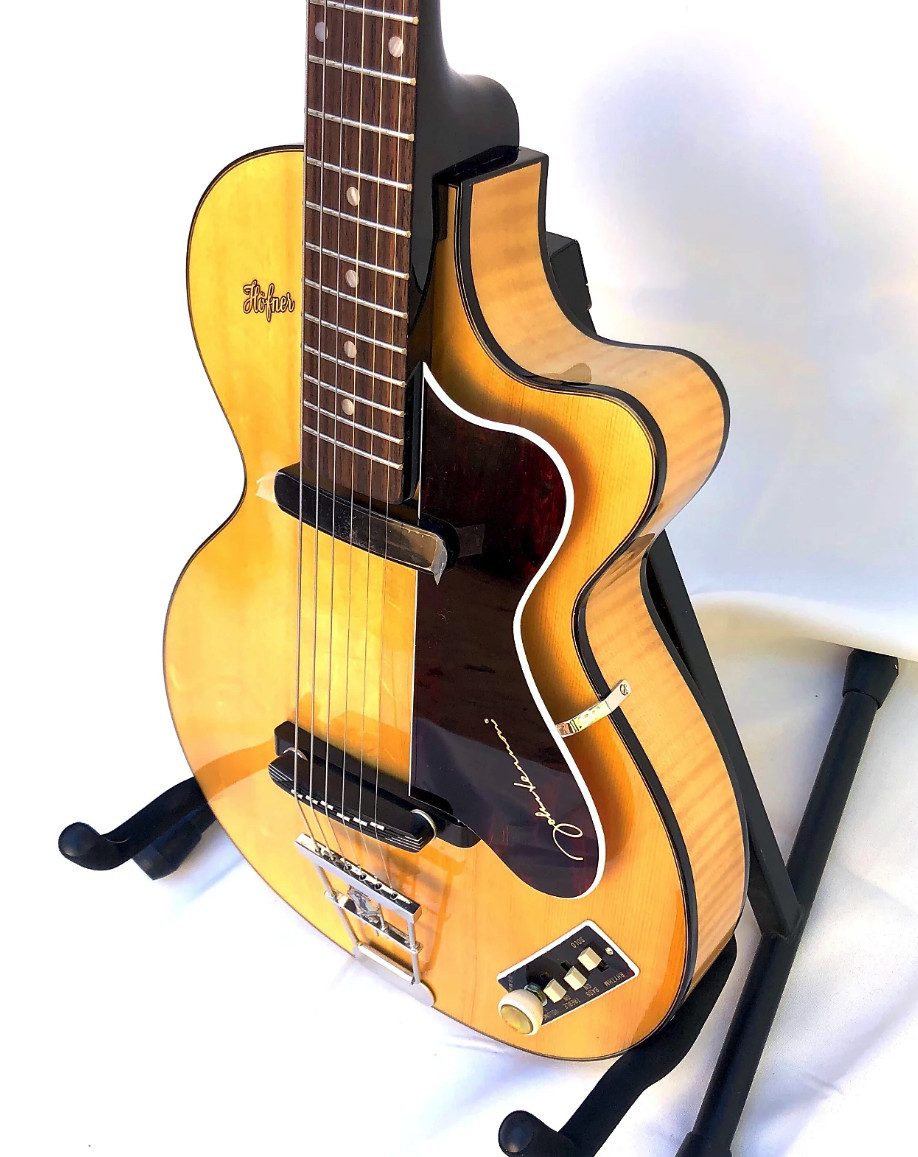 snip20190216_10.png
snip20190216_10.png
A full view of the Hofner “John Lennon” Club 40 Limited Edition guitar, showcasing its vintage-inspired design and commemorative features.
Rickenbacker Capri 325: The “Holy Grail”
The 1958 Rickenbacker Capri 325, serial number V81, stands as arguably the most iconic John Lennon guitar and a “Holy Grail” for Beatles aficionados. This guitar became synonymous with The Beatles’ early success and the “British Invasion.”
 The Holy Grail 1960 325 Capri
The Holy Grail 1960 325 Capri
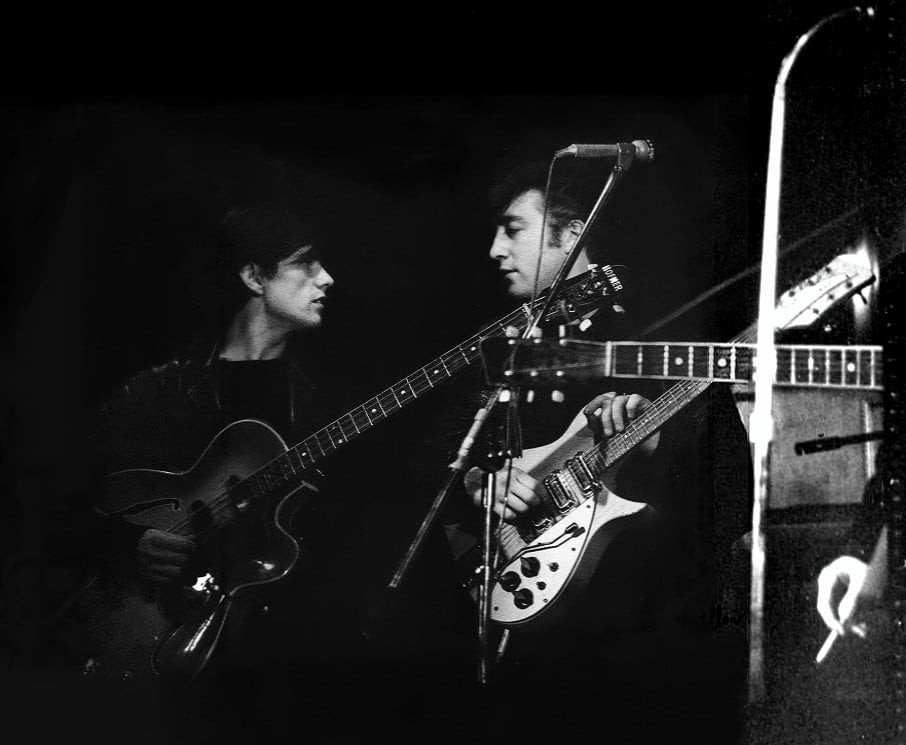 126213599_3413629892083409_3578830943514906415_n.jpg
126213599_3413629892083409_3578830943514906415_n.jpg
George Harrison recounted Lennon’s purchase in Hamburg in 1960, influenced by Jean “Toots” Thielemans, who played a similar Rickenbacker. Harrison described how American guitars were highly coveted by the Liverpool band at the time. Pete Best also recalled Lennon’s fascination with the Rickenbacker’s short scale neck, making it easier for him to play.
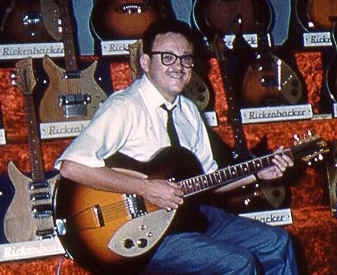 toots
toots
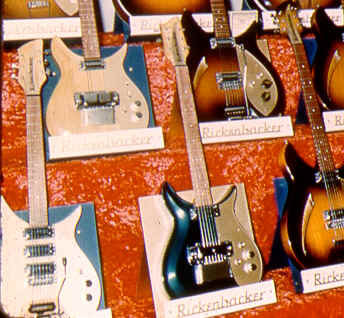 new-2
new-2
Lennon’s 325 was one of only 28 produced in 1958, and one of eight with a natural “mapleglo” finish. It was unique for its lack of a sound hole, unusual for hollow-body Rickenbackers, and its four controls, suggesting it was retrofitted by Rickenbacker with an extra volume and tone knob. Records indicate that four 325s were shipped to Hamburg, and Lennon’s was likely among three maple-finished models sent to Framus Werke in Germany.
 20914463_1829656520381992_7442899893336556145_n.jpg
20914463_1829656520381992_7442899893336556145_n.jpg
The serial number “V81” places it as the second Capri produced in 1958. Its unusual features and low production numbers contribute to its legendary status and immense value. Some believe it may have been a prototype, showcased at a trade show before finding its way to Lennon in Hamburg.
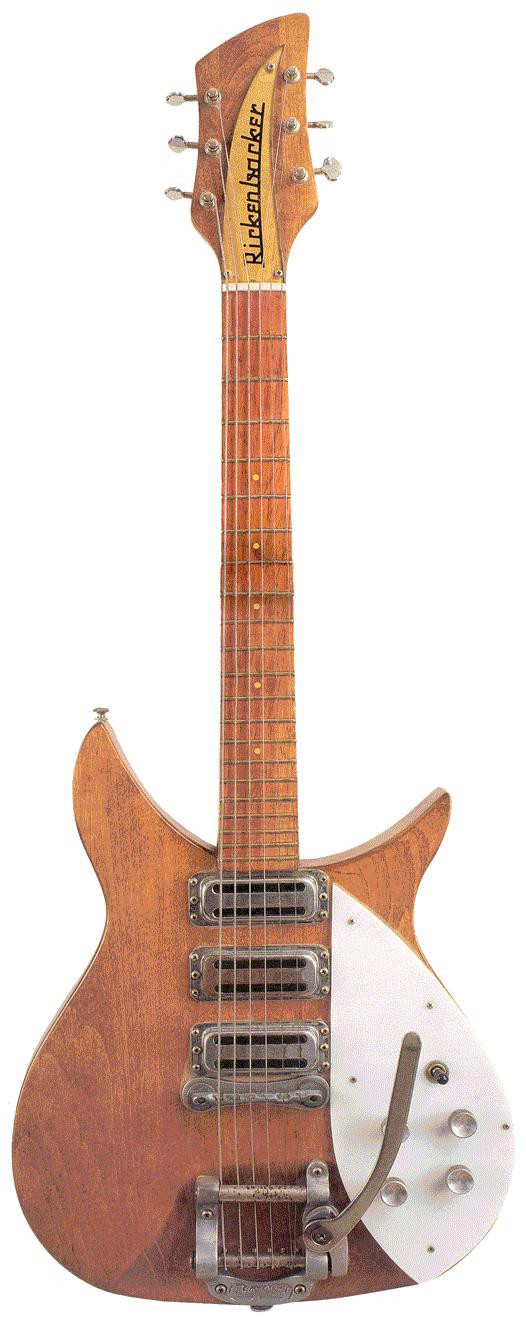 v81.png
v81.png
Alongside Lennon’s V81, two other 1958 Rickenbacker Capri 325 guitars with serial numbers V82 and V93 are also documented, further highlighting the rarity of this model.
 V82
V82
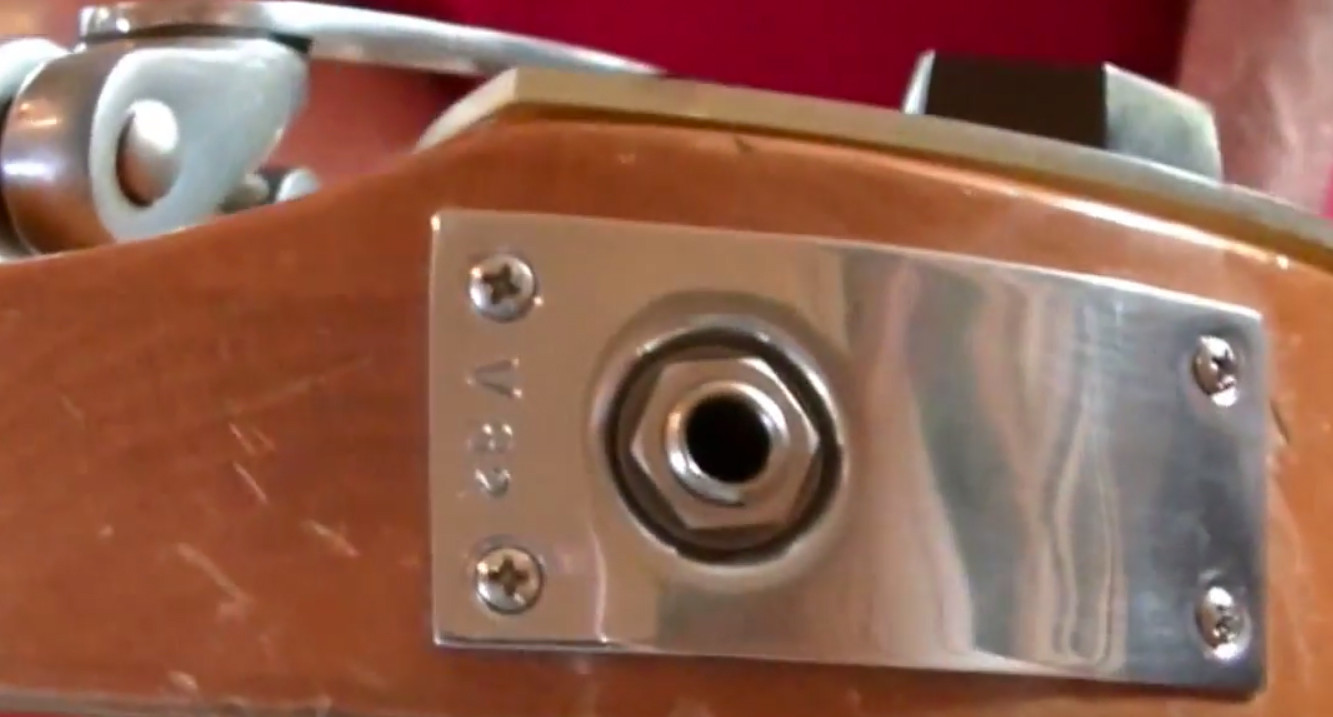 V82b
V82b
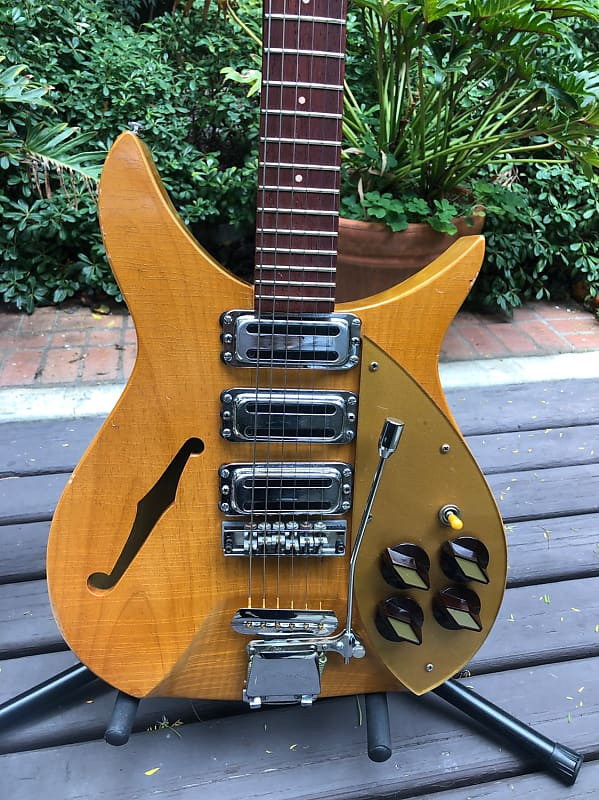 v93.jpg
v93.jpg
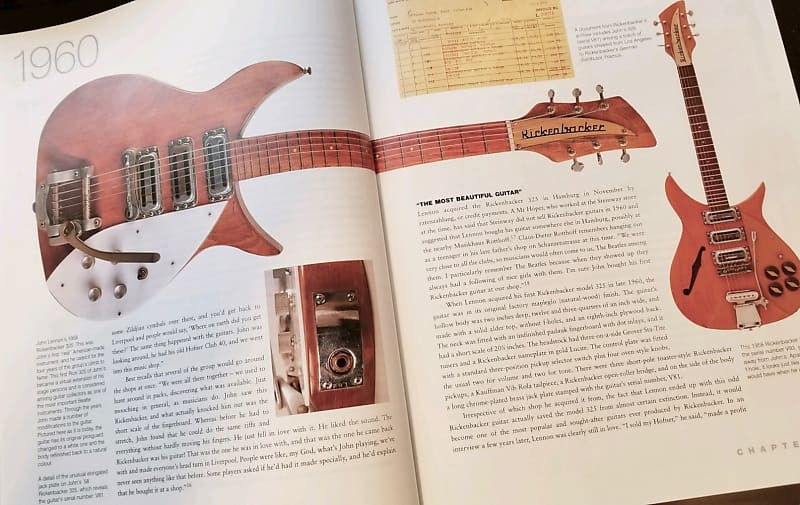 v933.jpg
v933.jpg
Lennon famously painted his 1958 Rickenbacker Capri 325 black in 1962. Chris Wharton, a friend of The Beatles, recounted that his father’s coach painter, Charlie Bantam, applied multiple coats of black Tecaloid enamel. The control panel retained its gold finish, though possibly repainted.
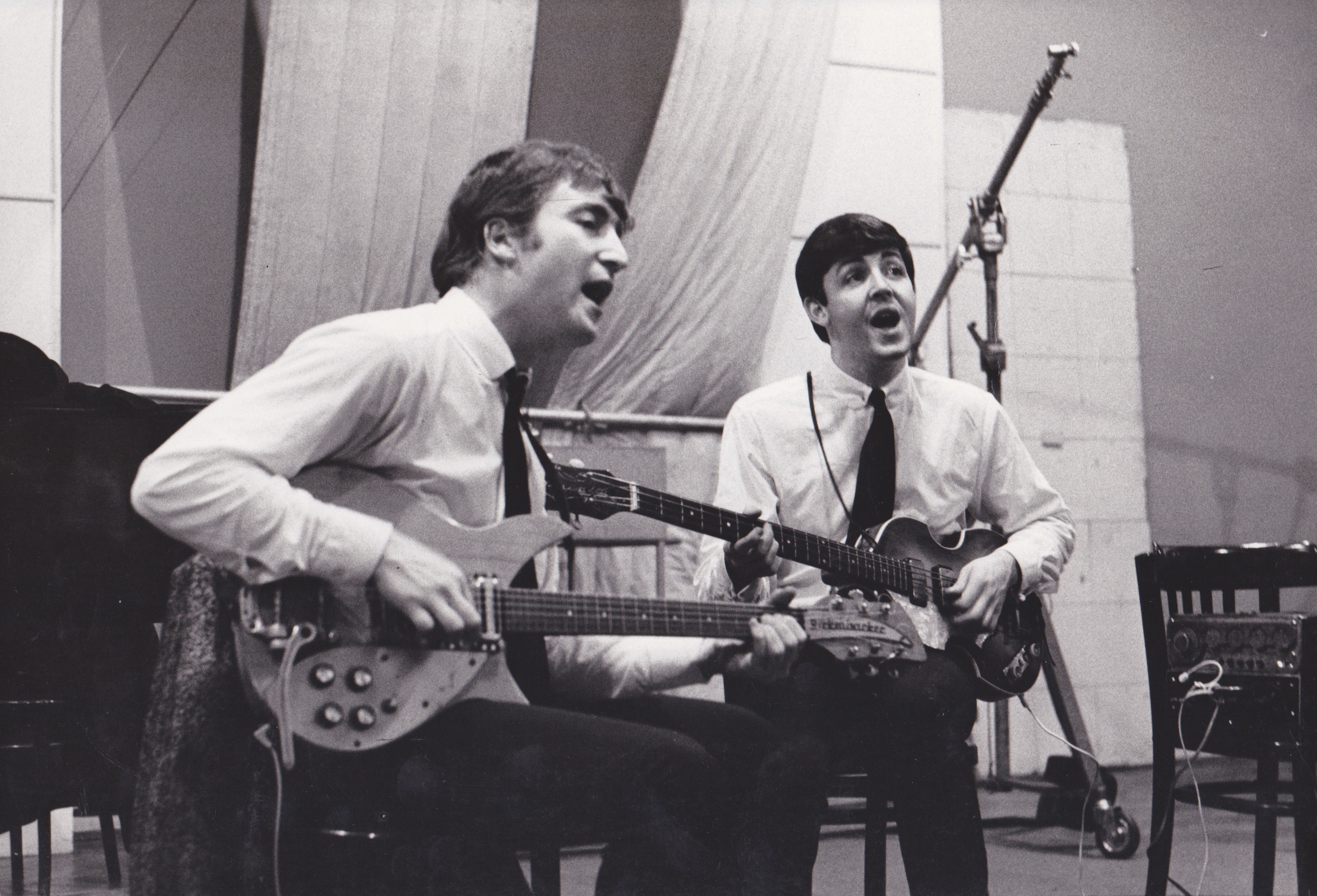 scan-4861.jpeg
scan-4861.jpeg
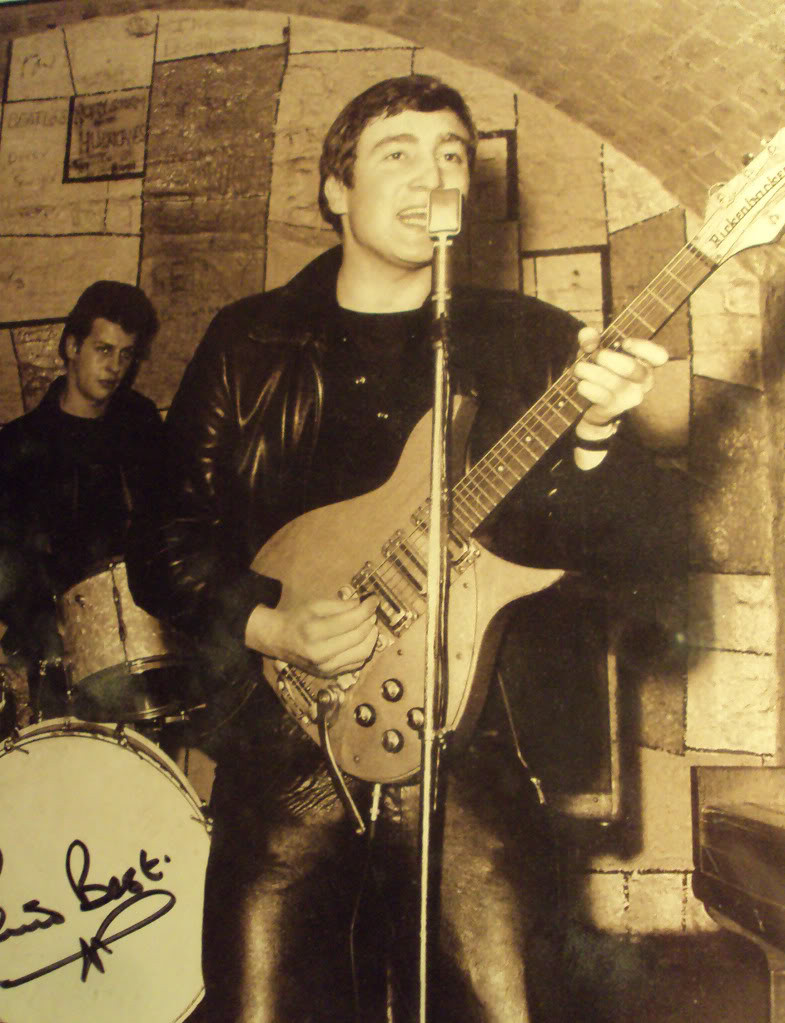 DSC06023
DSC06023
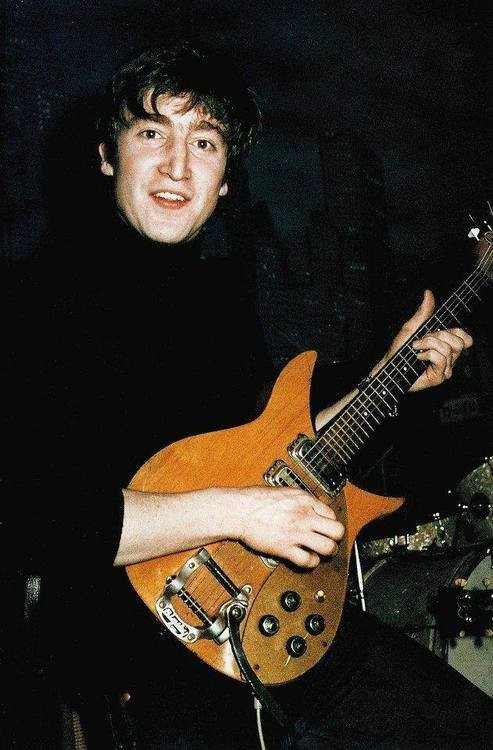 37794306_10155414348707077_4812385029806096384_n.jpg
37794306_10155414348707077_4812385029806096384_n.jpg
 Sullivan Rehearsals
Sullivan Rehearsals
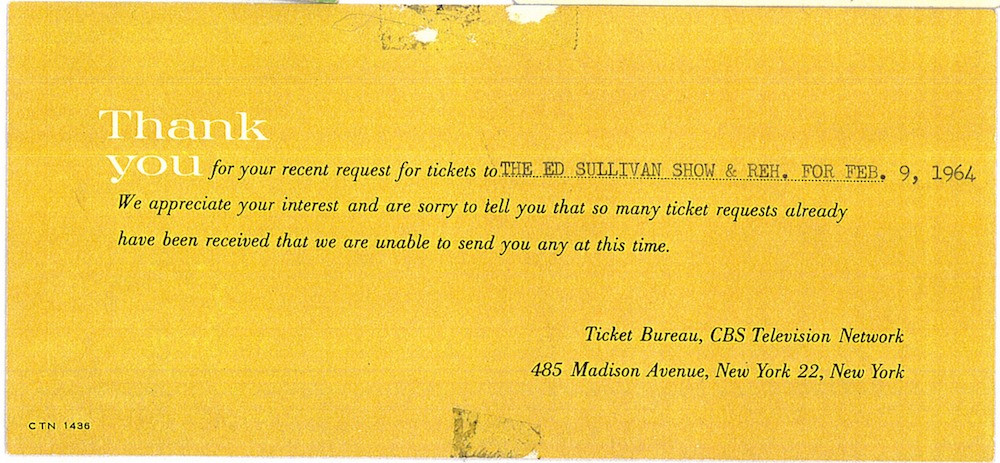 edsullivan.jpg
edsullivan.jpg
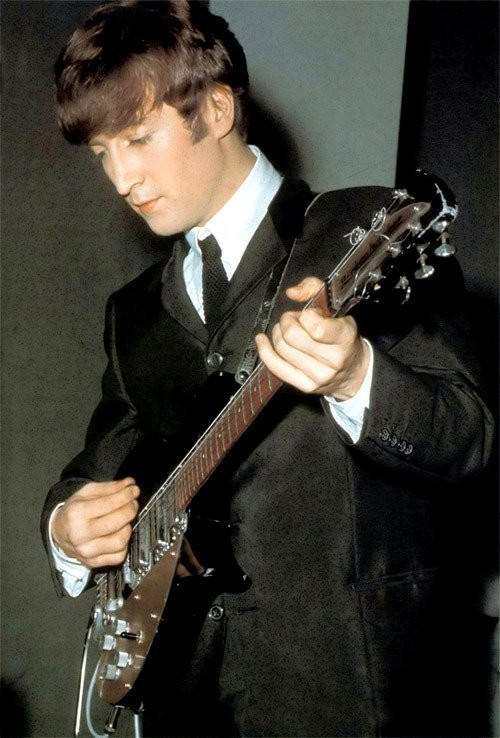 Jo0hn-Lennon-the-beatles-7095228-500-738
Jo0hn-Lennon-the-beatles-7095228-500-738
By the early 1970s, the Capri 325 suffered from electronic issues, partly due to Lennon’s hands-on tinkering and less-than-gentle treatment of his instruments. Ron DeMarino, a New York luthier, restored and repaired the guitar in 1972. Lennon reportedly admitted to disconnecting the middle pickup to avoid “clicking” during recordings.
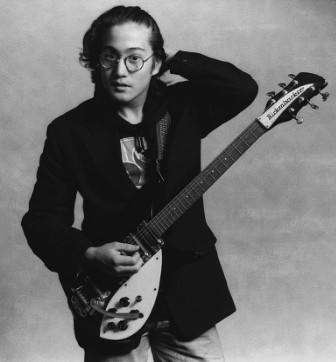 snip20161106_4
snip20161106_4
Lennon’s last public performance with the ’58 Rickenbacker 325 was at Carnegie Hall in 1964. Original parts, including the Grover machine heads and gold pickguard, were later auctioned by Ron DeMarino, who received them from Lennon in 1972.
 V81
V81
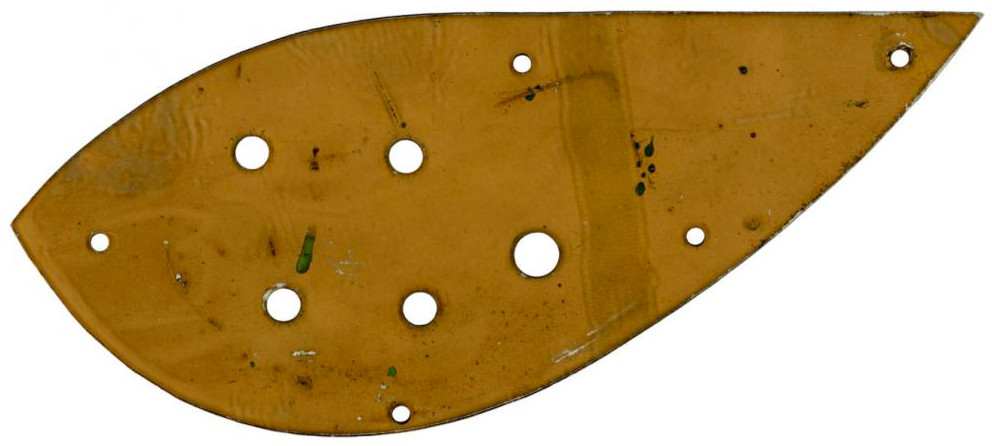 Pickguard
Pickguard
 Grovers
Grovers
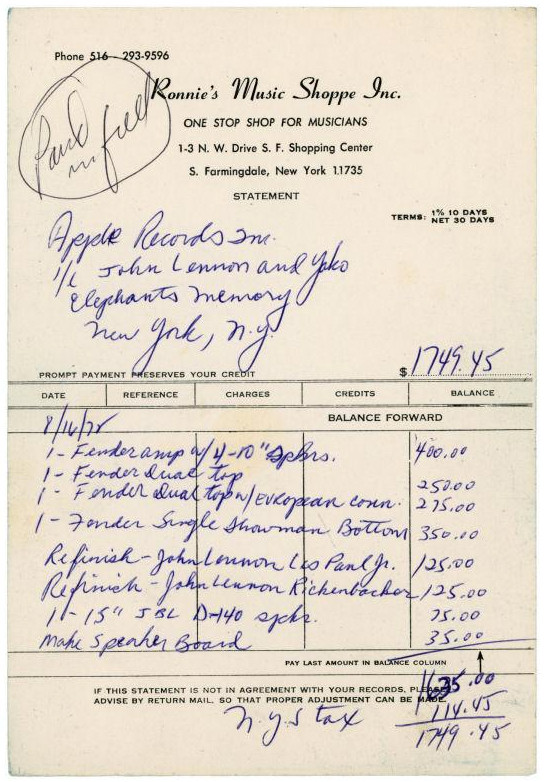 Receipt2
Receipt2
Rickenbacker 325 c64 “Miami”: A New Generation
In February 1964, during The Beatles’ first trip to America, Rickenbacker gifted Lennon a brand-new 325, the 1964 Rickenbacker 325 c64 “Miami” (serial number DB-122). This guitar replaced his beloved but worn ’58 Capri 325 as his primary Rickenbacker.
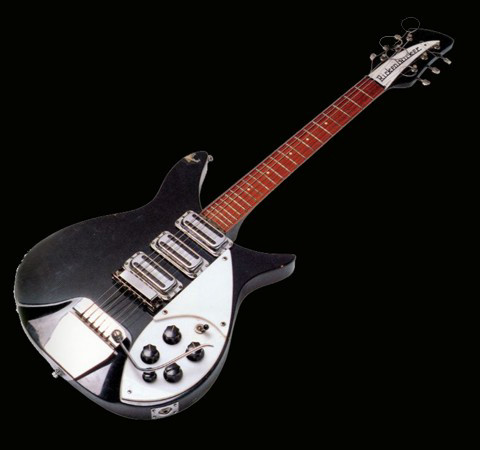 1964 Rickenbacker 325
1964 Rickenbacker 325
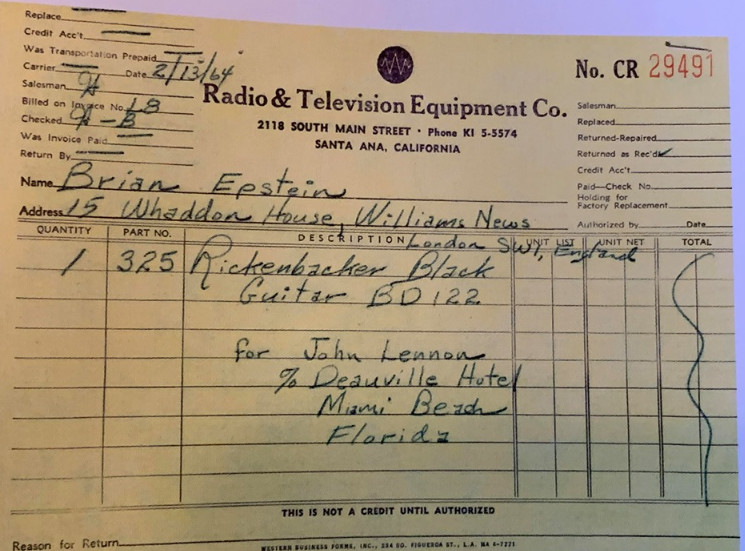 gengh.png
gengh.png
The new black 325 was delivered directly to The Beatles at the Deauville Hotel in Miami Beach. Lennon debuted it during rehearsals for their second Ed Sullivan Show appearance.
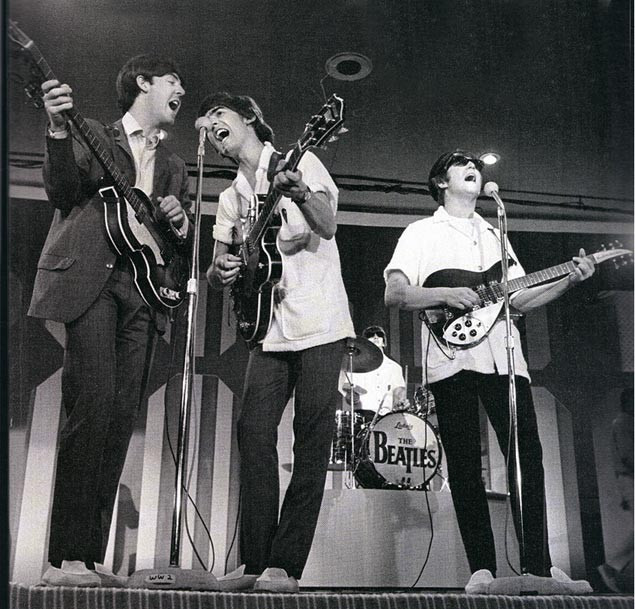 V64MiamiSullivan
V64MiamiSullivan
 5.jpg
5.jpg
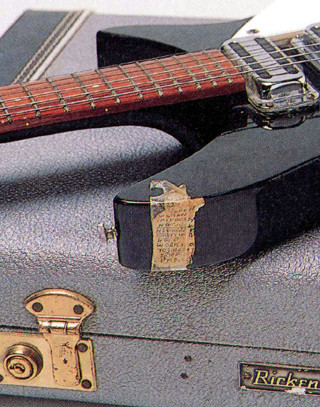 325miamilist
325miamilist
 Setlist
Setlist
During the 1964 Hammersmith Christmas show, Lennon accidentally dropped the “Miami” Rickenbacker, cracking the headstock.
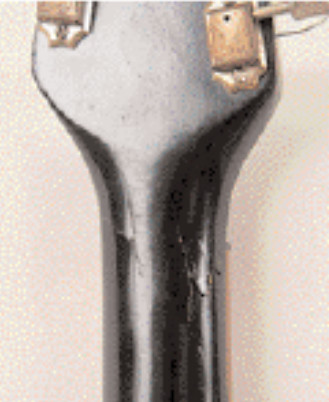 neck.png
neck.png
 130274527_946124949250098_8713538084047149300_n.jpg
130274527_946124949250098_8713538084047149300_n.jpg
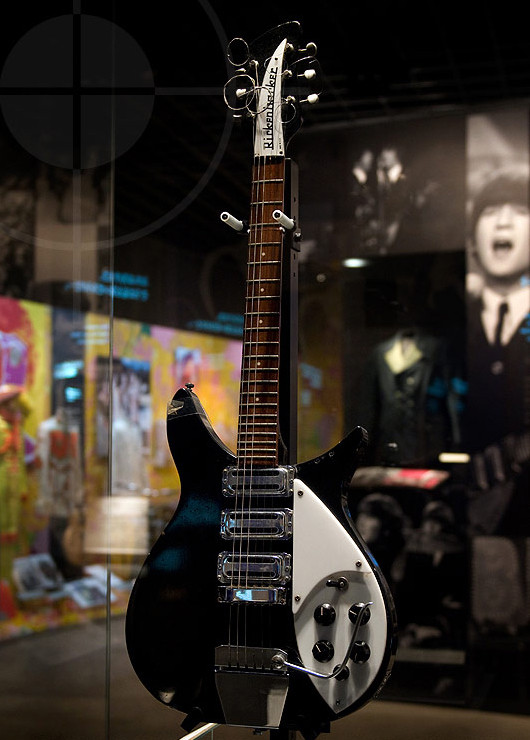 Rickenbacker325JetGlo
Rickenbacker325JetGlo
A heartwarming story connects Dorothy “Dotty” Tandle, a Rickenbacker employee, to this iconic guitar. Her son, Mark Raymond, shared that Dotty personally assembled and finished Lennon’s 1964 325 c64 “Miami.” She sanded the body, worked on the neck and fretboard, and assembled the guitar, even hand-cutting the pickguard. Dotty’s meticulous work was recognized within Rickenbacker, and she contributed to several “first” guitars for the company, including guitars for George Harrison and Paul McCartney.
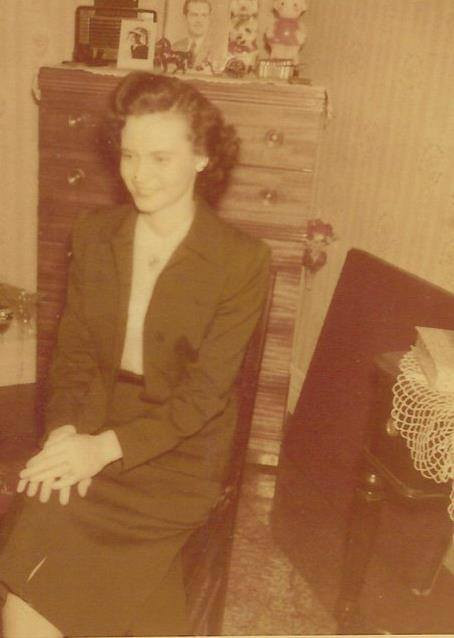 dotty.jpg
dotty.jpg
Rickenbacker 325-12 String: The Twelve-String Rarity
Rickenbacker also created a 12-string version for Lennon, the 1964 Rickenbacker 325-12 String. While primarily a studio instrument, Lennon used it sparingly in live performances.
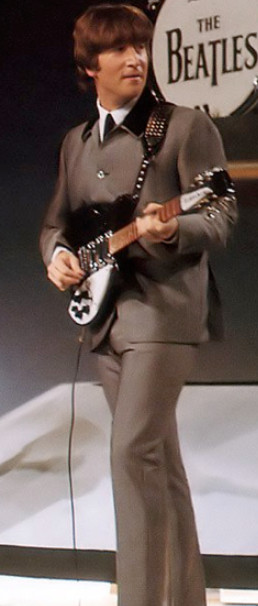 12string.png
12string.png
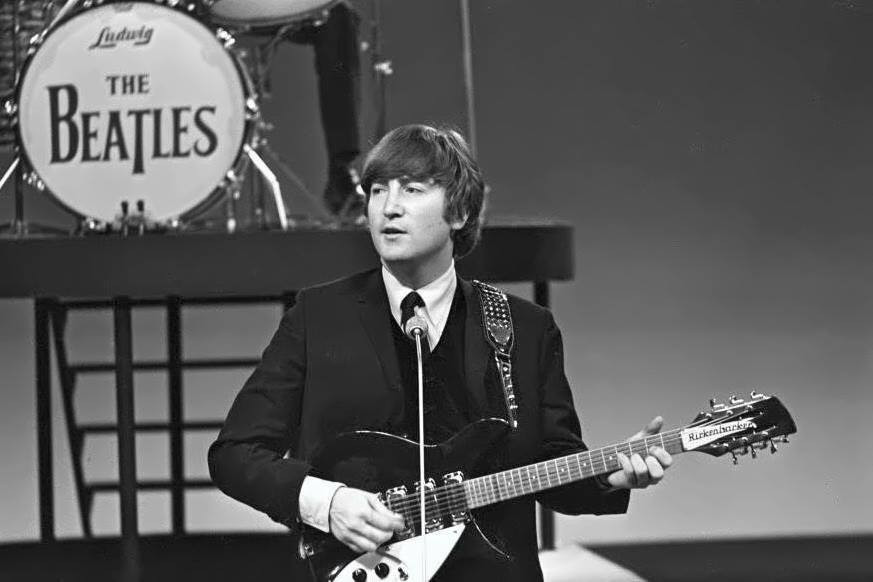 16807147_1465639210115512_5401335774528253570_n.jpg
16807147_1465639210115512_5401335774528253570_n.jpg
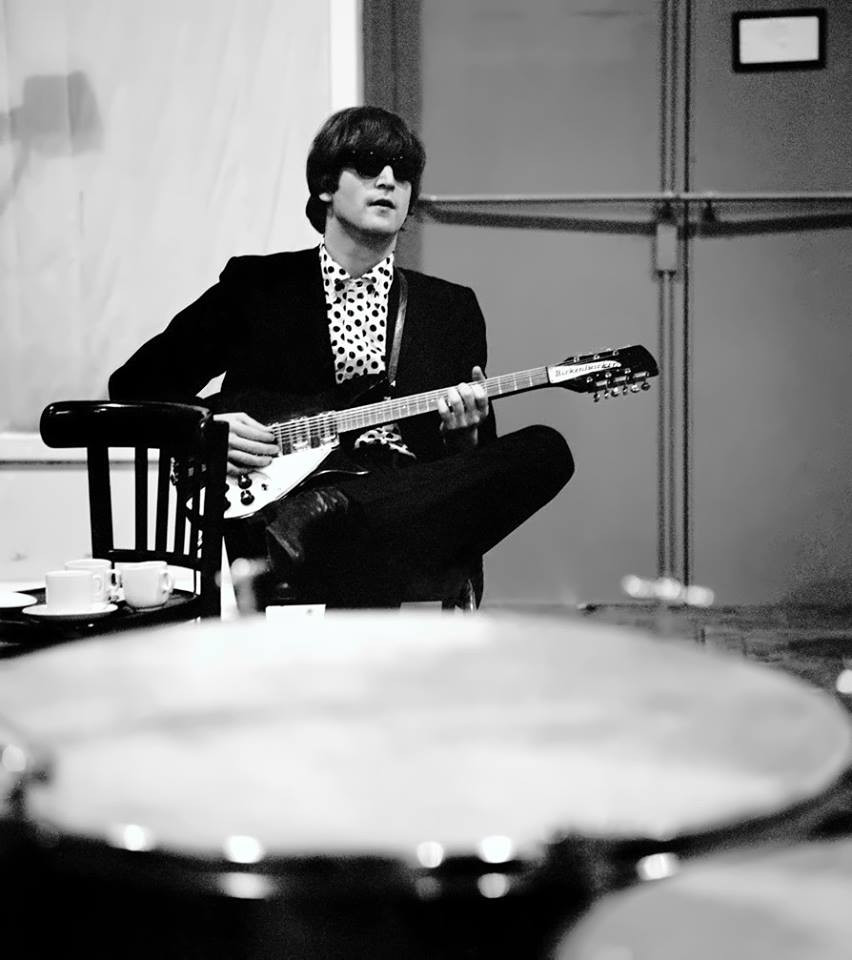 16649561_1465638866782213_4913637083481582339_n.jpg
16649561_1465638866782213_4913637083481582339_n.jpg
Lennon was pictured using it in concert only once, at the Boston Gardens in 1964. He also played it on a Dutch TV show in 1964, though it was a lip-synced performance.
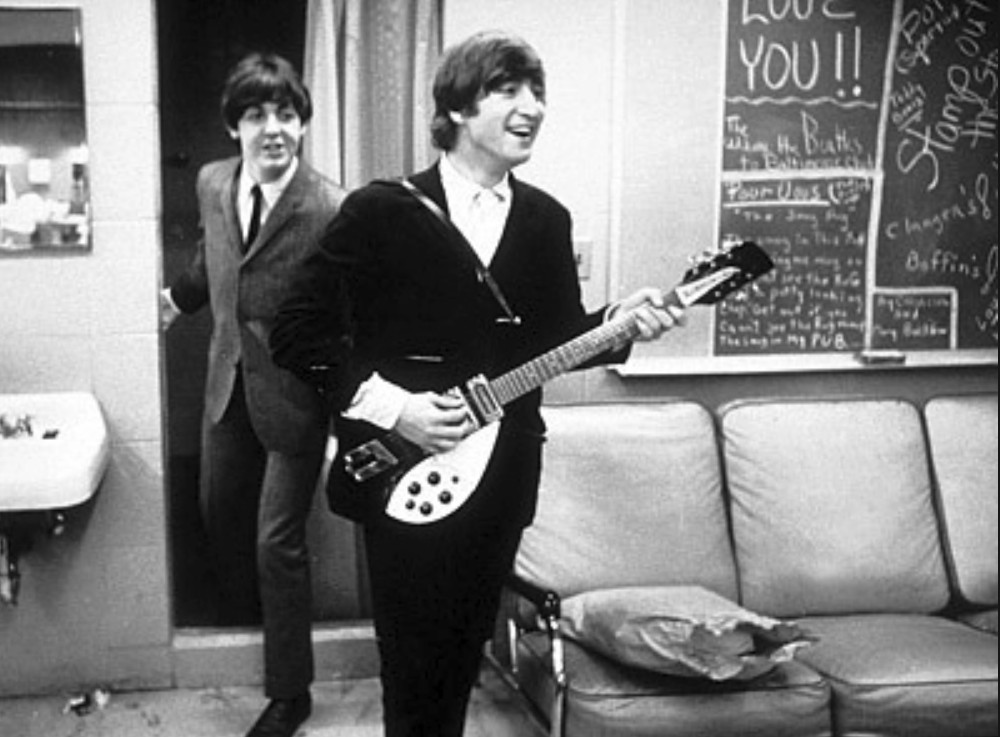 12stringmaybe.png
12stringmaybe.png
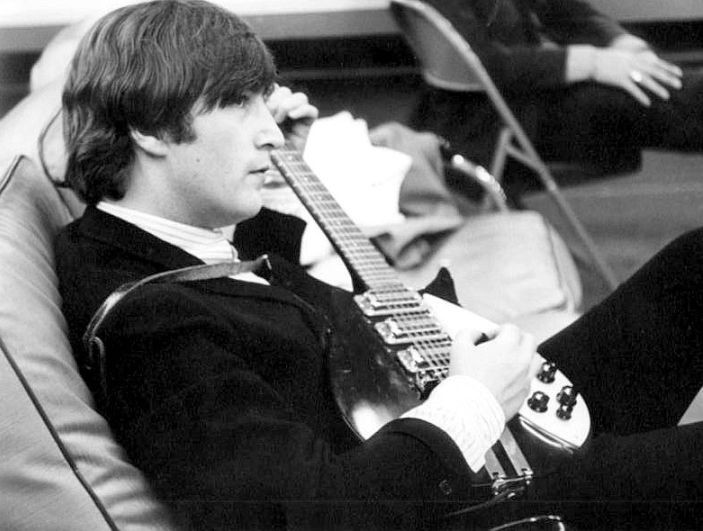 jlric122
jlric122
 john12
john12
 12string
12string
A detailed image of the headstock of a Rickenbacker 12-string guitar, highlighting the tuning pegs for twelve strings.
 jimmy.png
jimmy.png
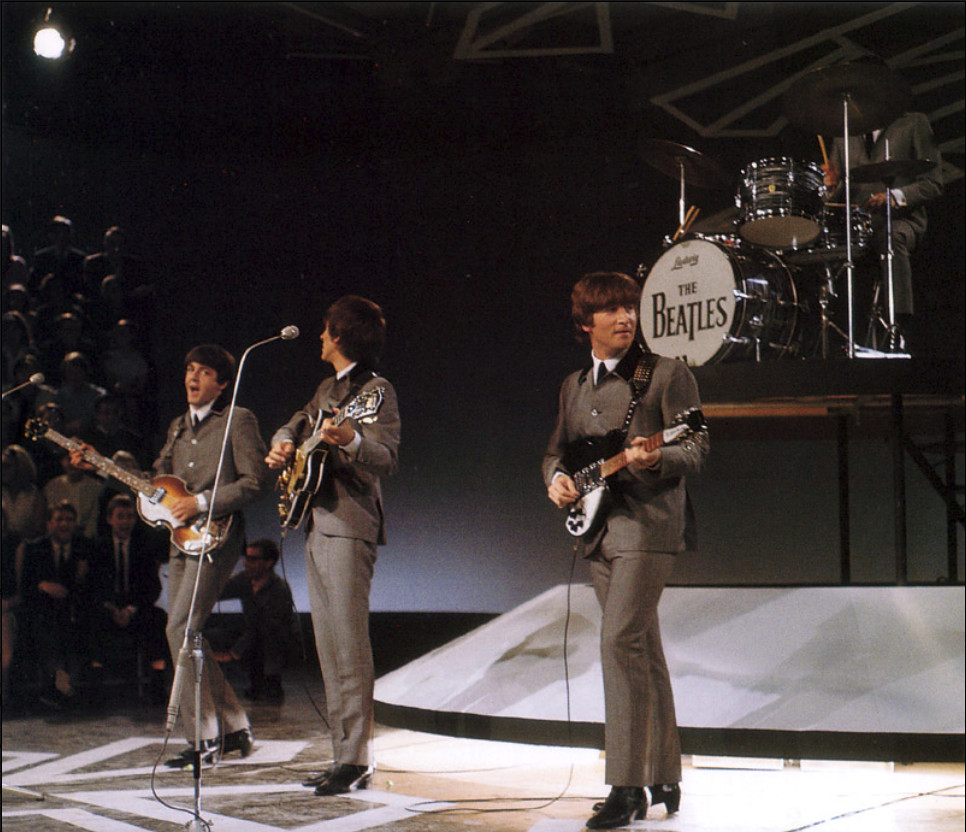 john12stringclear.png
john12stringclear.png
Rickenbacker 325 Model 1996 “Beatle Backer”: The Export Version
After damaging his 1964 Rickenbacker 325 Jet-glo, Lennon received a replacement, the 1964 Rickenbacker 325 Rose-Morris Model 1996, an export version. He used this guitar primarily in his home studio and later gifted it to Ringo Starr.
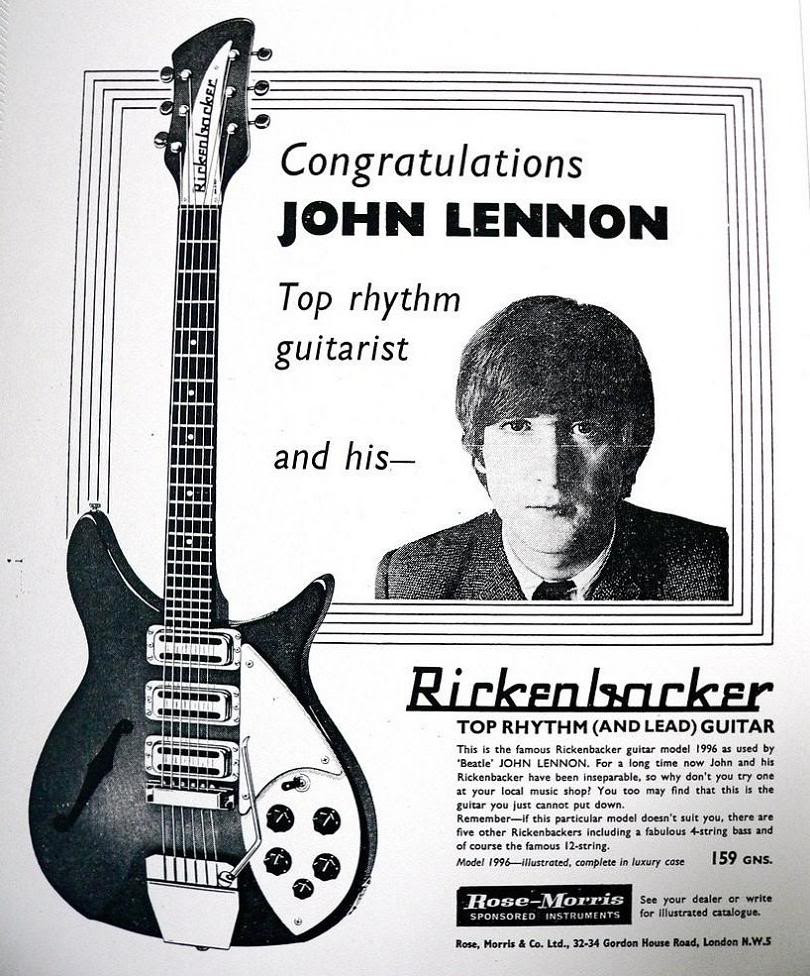 John-Lennon-Rickenbacker
John-Lennon-Rickenbacker
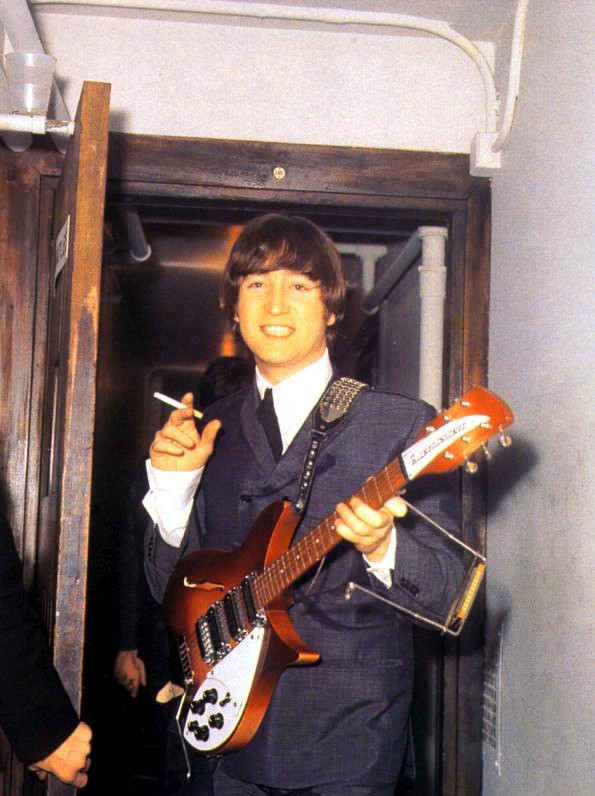 Snip20151113_10
Snip20151113_10
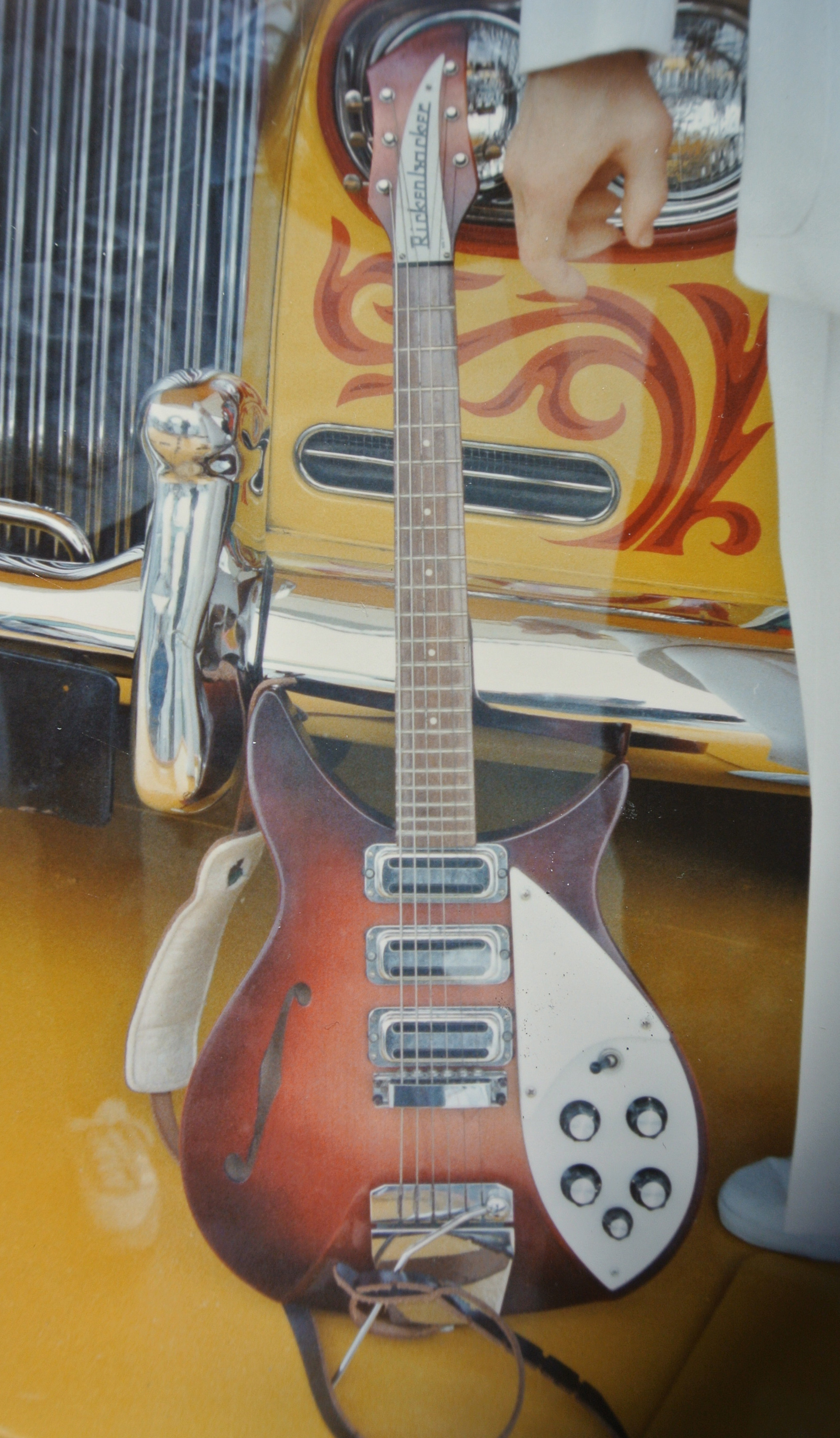 Johns1964_1966
Johns1964_1966
Ringo Starr eventually auctioned this guitar, along with George Harrison’s 1962 Gretsch Tennessean, in 2015. The 1964 Rickenbacker 325 Rose-Morris Model 1996 sold for an impressive $910,000 at Julien’s Auctions.
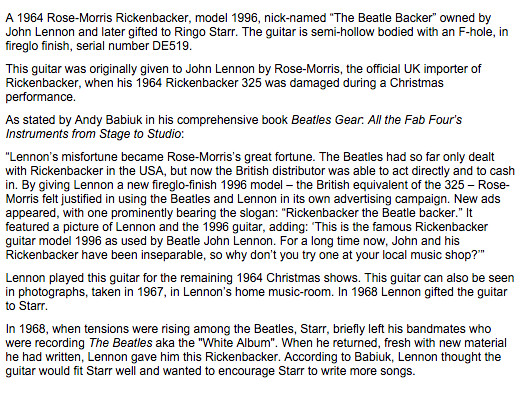 Snip20151113_11
Snip20151113_11
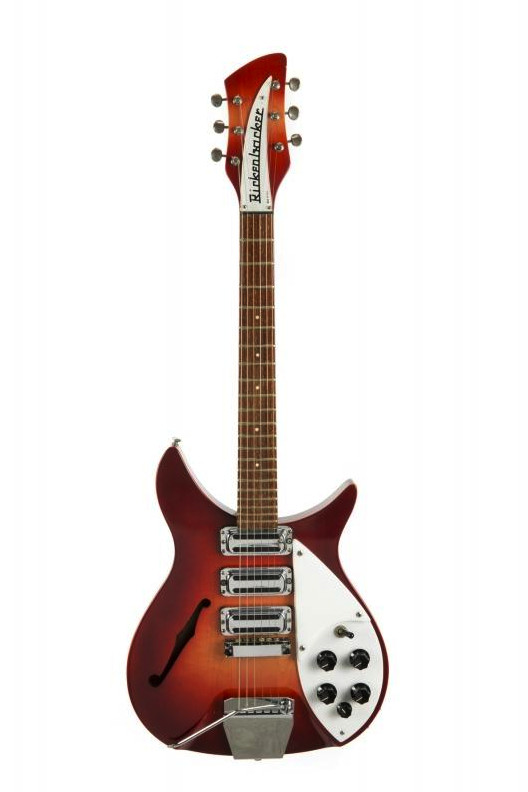 Snip20151113_12
Snip20151113_12
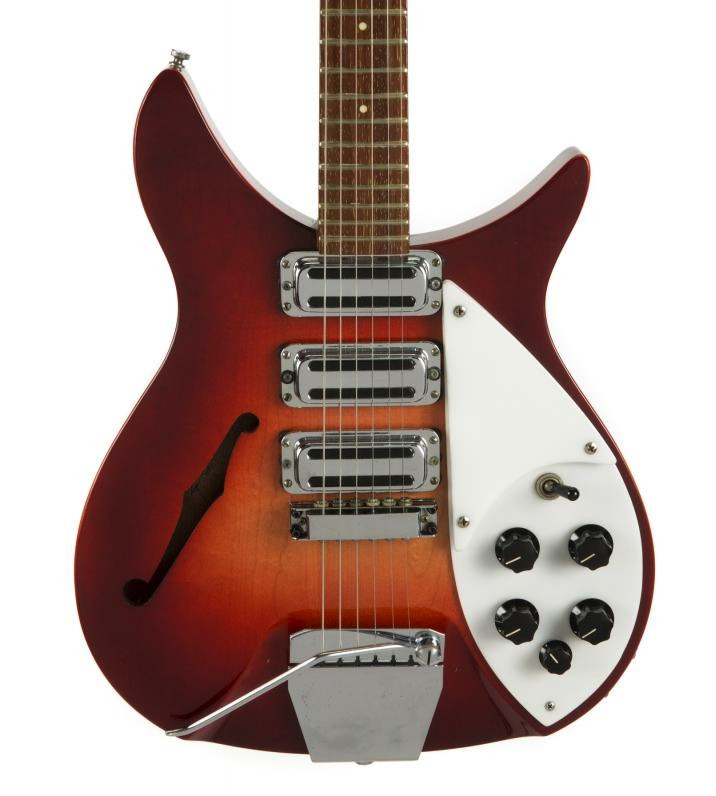 Snip20151113_9
Snip20151113_9
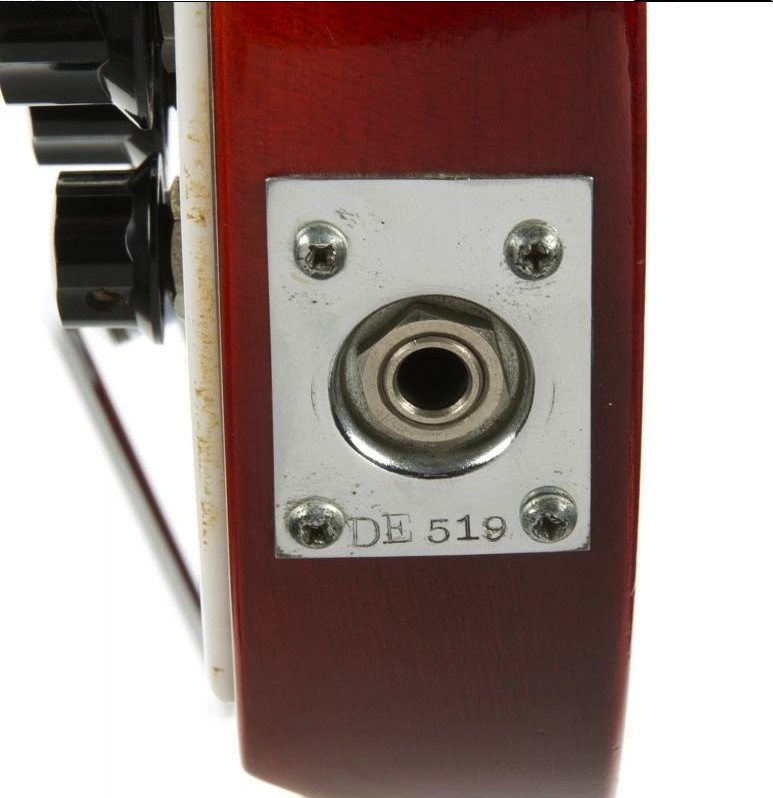 Snip20151113_13
Snip20151113_13
Jim Irsay, a prominent collector of Beatles memorabilia, acquired this guitar, along with other significant Beatles instruments at the same auction, further cementing the historical importance of John Lennon guitars.
 beatles.jpg
beatles.jpg
Acoustic Interludes: Gibson J-160E and More
Gibson J-160E: The Acoustic Workhorse
The Gibson J-160E acoustic-electric guitar became a signature instrument for both John Lennon and George Harrison. In 1962, they famously ordered a pair from Rushworth’s Music House in Liverpool, simply requesting “Gibson electric jumbos,” leading the store to order the J-160E model from the Gibson catalog.
 04.jpg
04.jpg
 06.jpg
06.jpg
Despite not being exactly what they initially envisioned, the J-160Es became integral to The Beatles’ sound, notably used on “Love Me Do.” While some consider it a technically “crappy guitar,” its unique tone became a signature element of their early recordings.
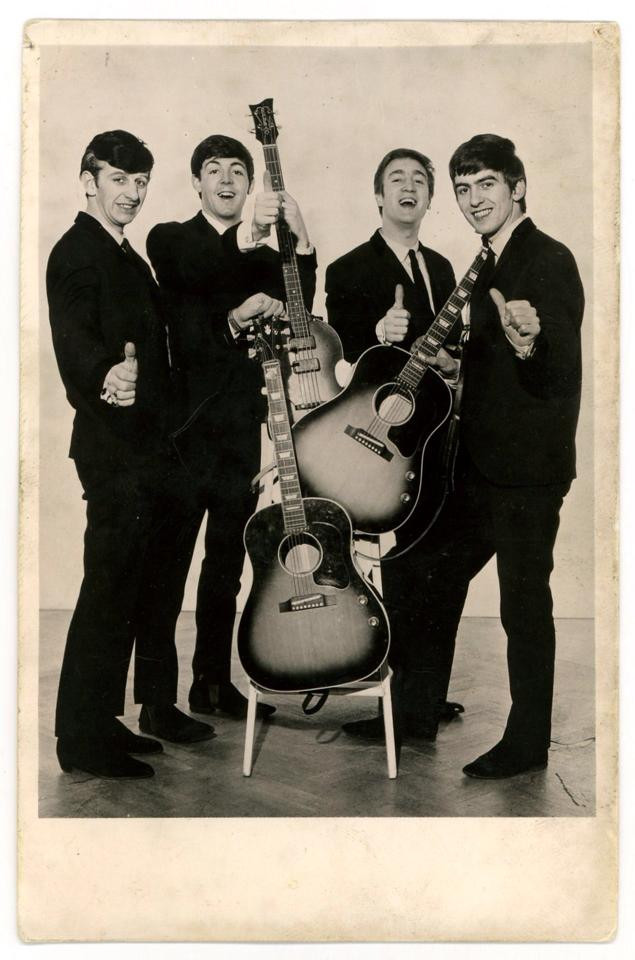 11000531_1149475838400067_2064192949726669588_n.jpg
11000531_1149475838400067_2064192949726669588_n.jpg
 LostOne
LostOne
 ISawHer
ISawHer
Due to their identical nature, Lennon and Harrison’s J-160Es were eventually mixed up. Harrison’s was stolen at the 1963 Finsbury Park Christmas show, though initially, Lennon mistakenly believed his was the stolen one.
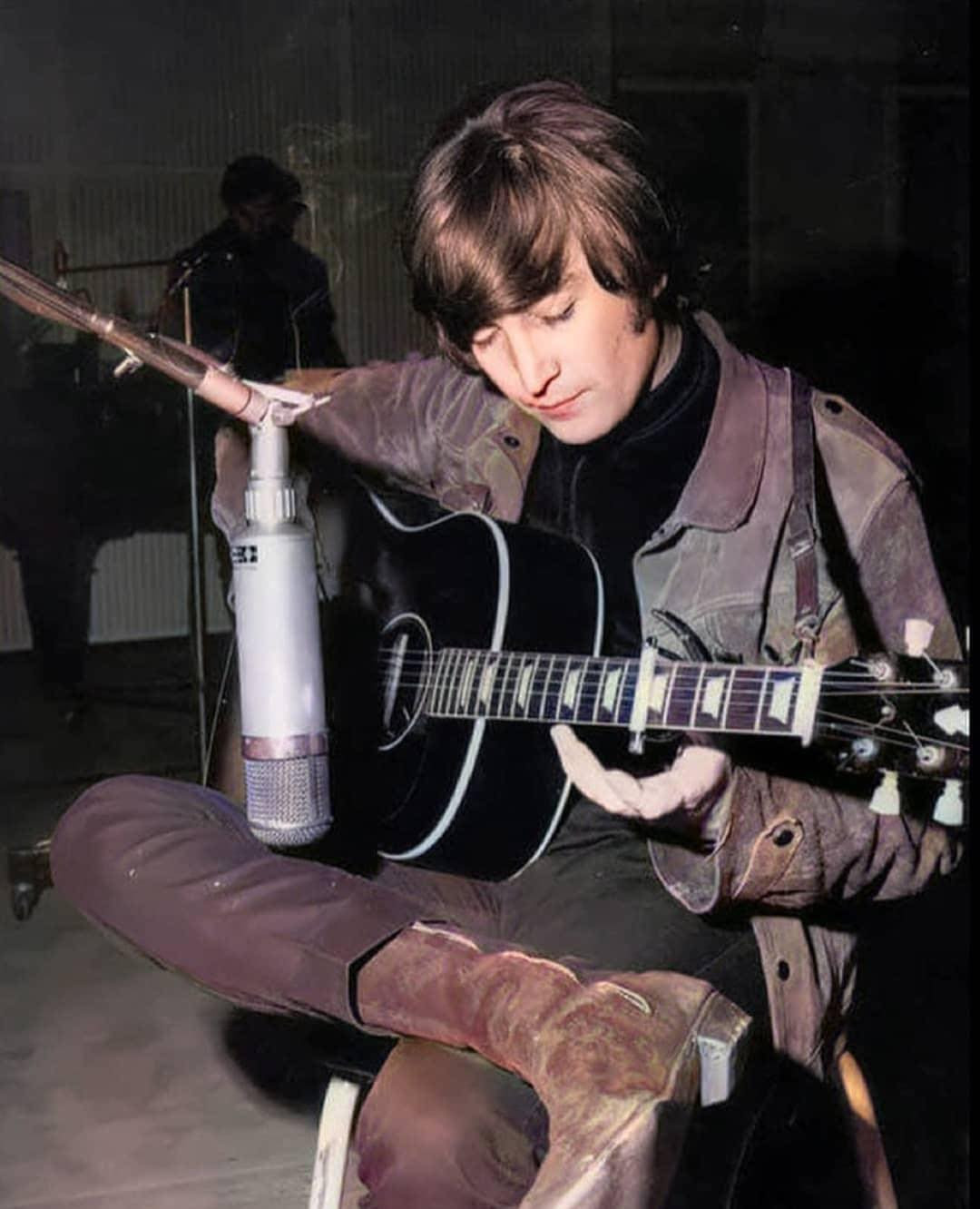 2020/09/119236092_327793861637256_7176821798924720261_n.jpg
2020/09/119236092_327793861637256_7176821798924720261_n.jpg
In 1964, Lennon acquired a replacement J-160E, distinguishable by double white rings around the soundhole. This became his main acoustic, accompanying him on The Beatles’ historic 1964 visit to America, marking the start of the “British Invasion.”
 155
155
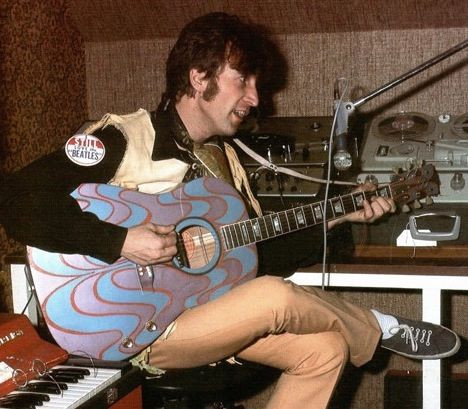 Fool
Fool
In 1967, “The Fool” collective gave this J-160E a psychedelic paint job. However, by 1968, Lennon sanded it back to its natural finish, using it extensively throughout his career until his death in 1980. Traces of the blue paint remained inside the soundhole. He famously carved figures of himself and Yoko Ono into the top, commemorating their “Bed-Ins” for peace in 1969.
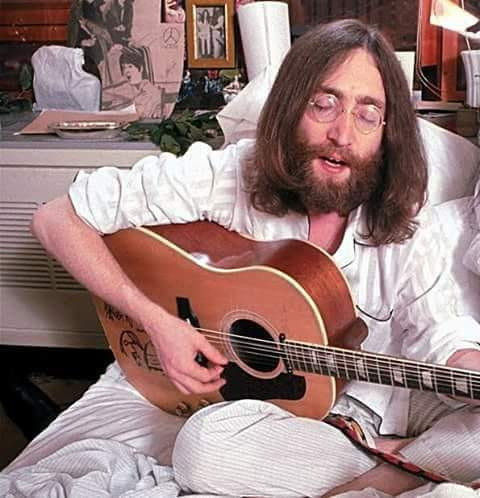 44707066_2213089112294876_7298669132772278272_n.jpg
44707066_2213089112294876_7298669132772278272_n.jpg
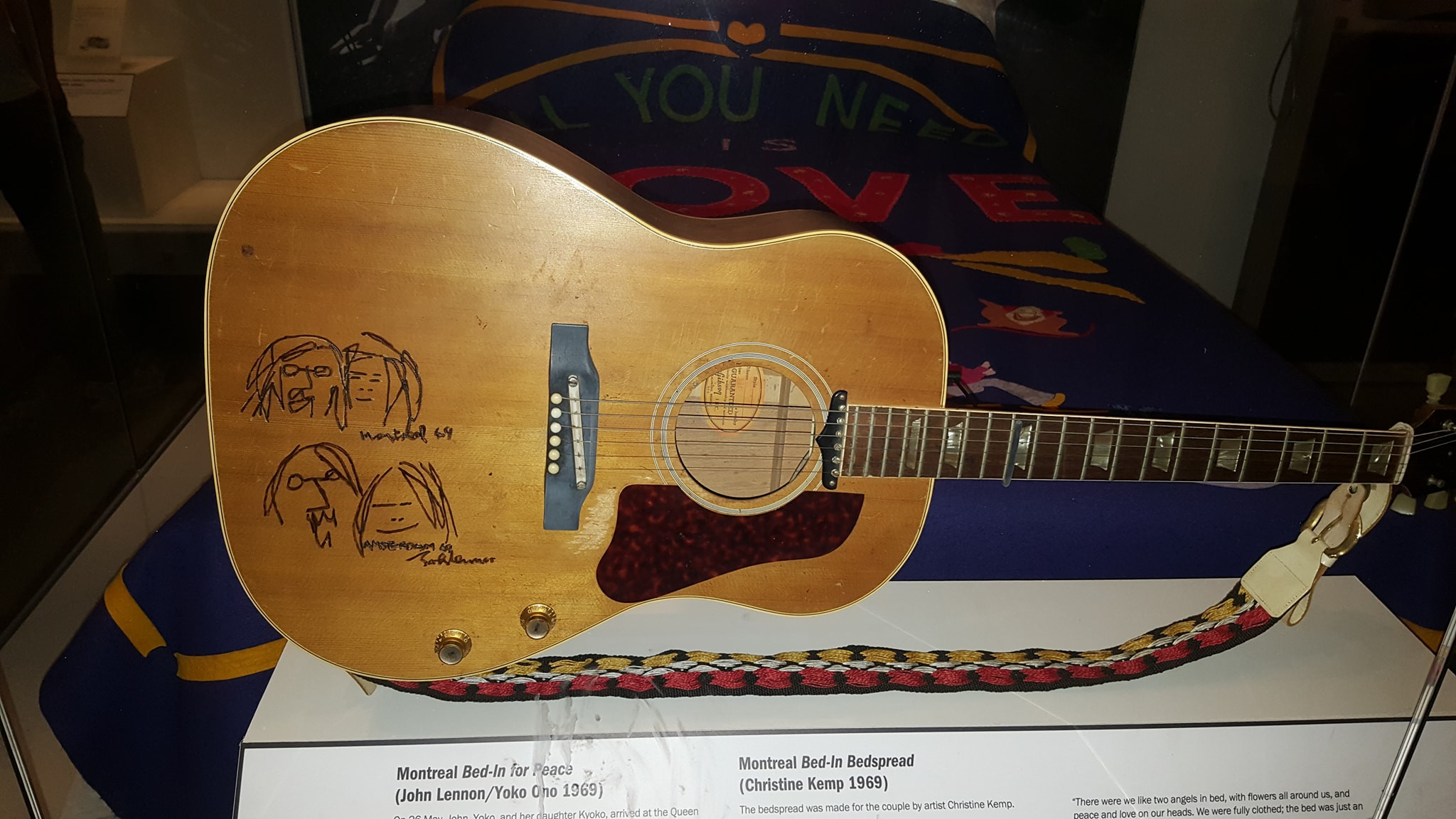 40021492_10216882193344681_6908614548140326912_o.jpg
40021492_10216882193344681_6908614548140326912_o.jpg
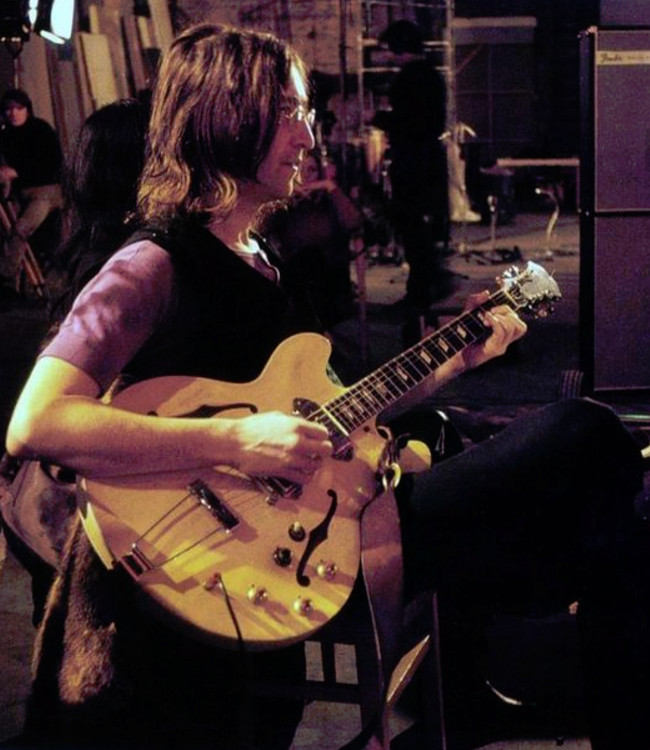 John
John
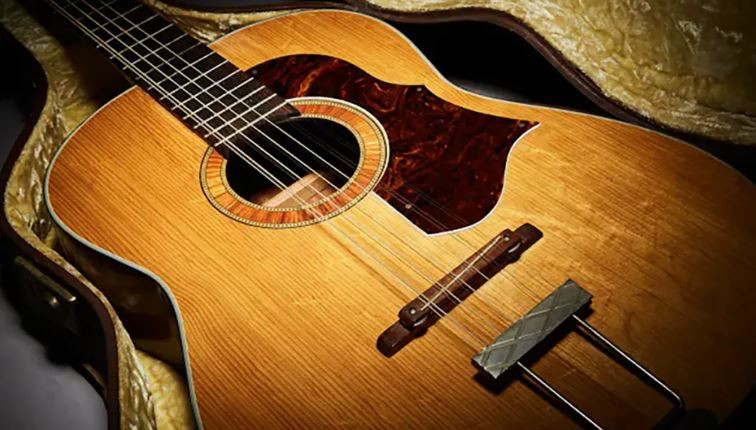 John4
John4
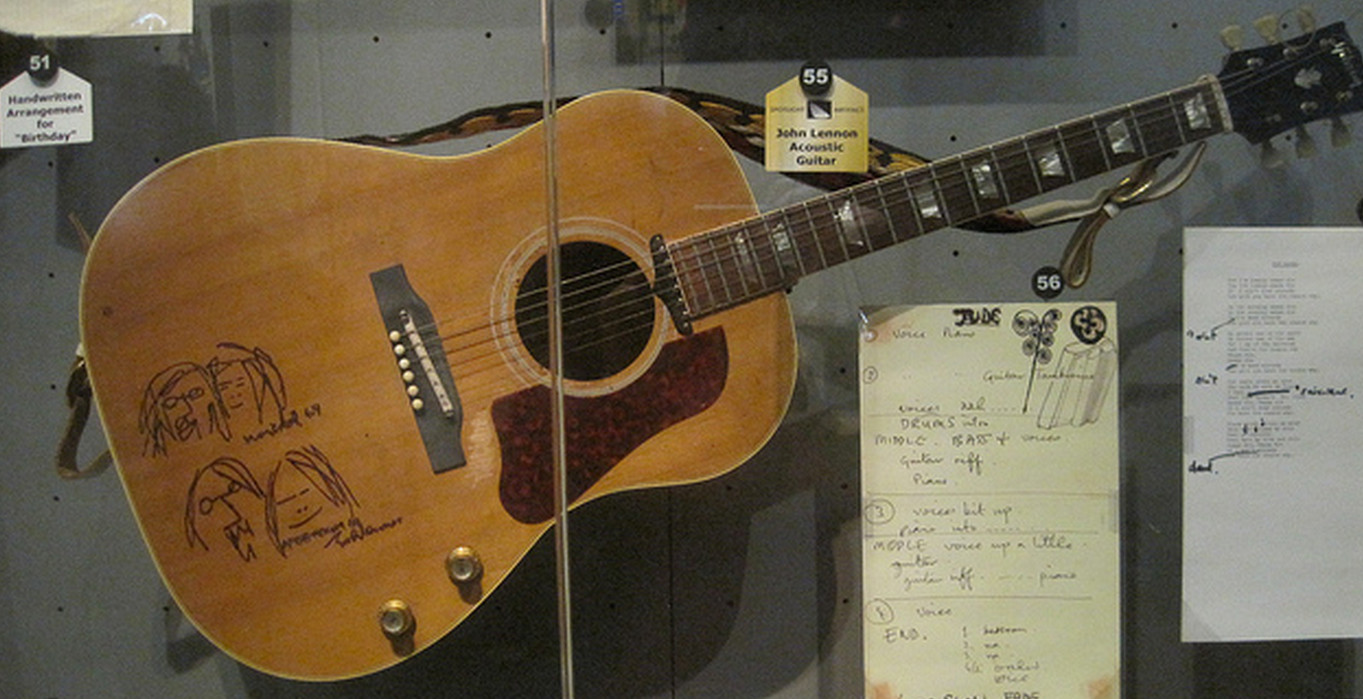 John
John
Another Gibson J-160E, a 1966 sunburst model, was gifted by Lennon to Bob Dylan around Christmas 1968. Dylan later gave it to his guitar tech Cesar Diaz, who eventually sold it. It is now displayed at the Hard Rock Cafe in NYC.
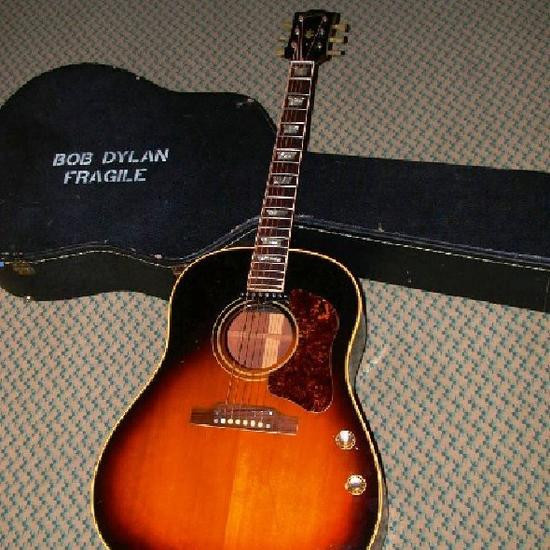 sdut-this-guitar-given-by-john-lenn-20160823.jpg
sdut-this-guitar-given-by-john-lenn-20160823.jpg
In a remarkable turn of events, Harrison’s stolen 1962 J-160E resurfaced after 50 years. It was purchased unknowingly by John McCaw in a US second-hand shop and later authenticated as Lennon’s (actually Harrison’s due to the mix-up). This “lost” guitar was auctioned for $2.4 million in 2015, becoming one of the most expensive guitars ever sold. Half of the proceeds were donated to the Spirit Foundation, founded by Lennon and Yoko Ono.
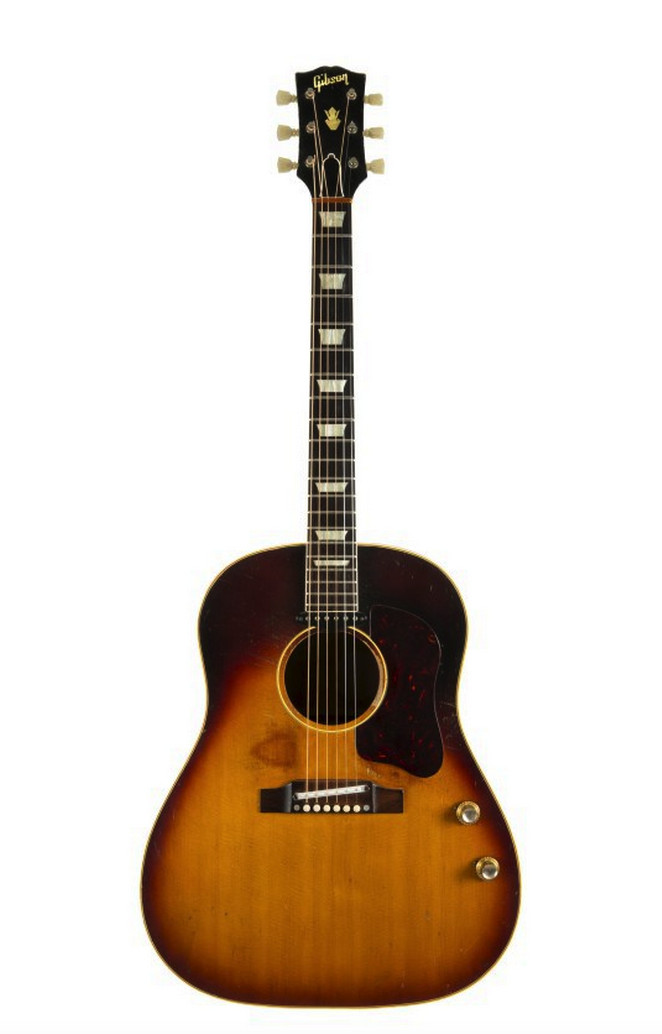 Snip20150604_5.png
Snip20150604_5.png
 208909_0.jpg
208909_0.jpg
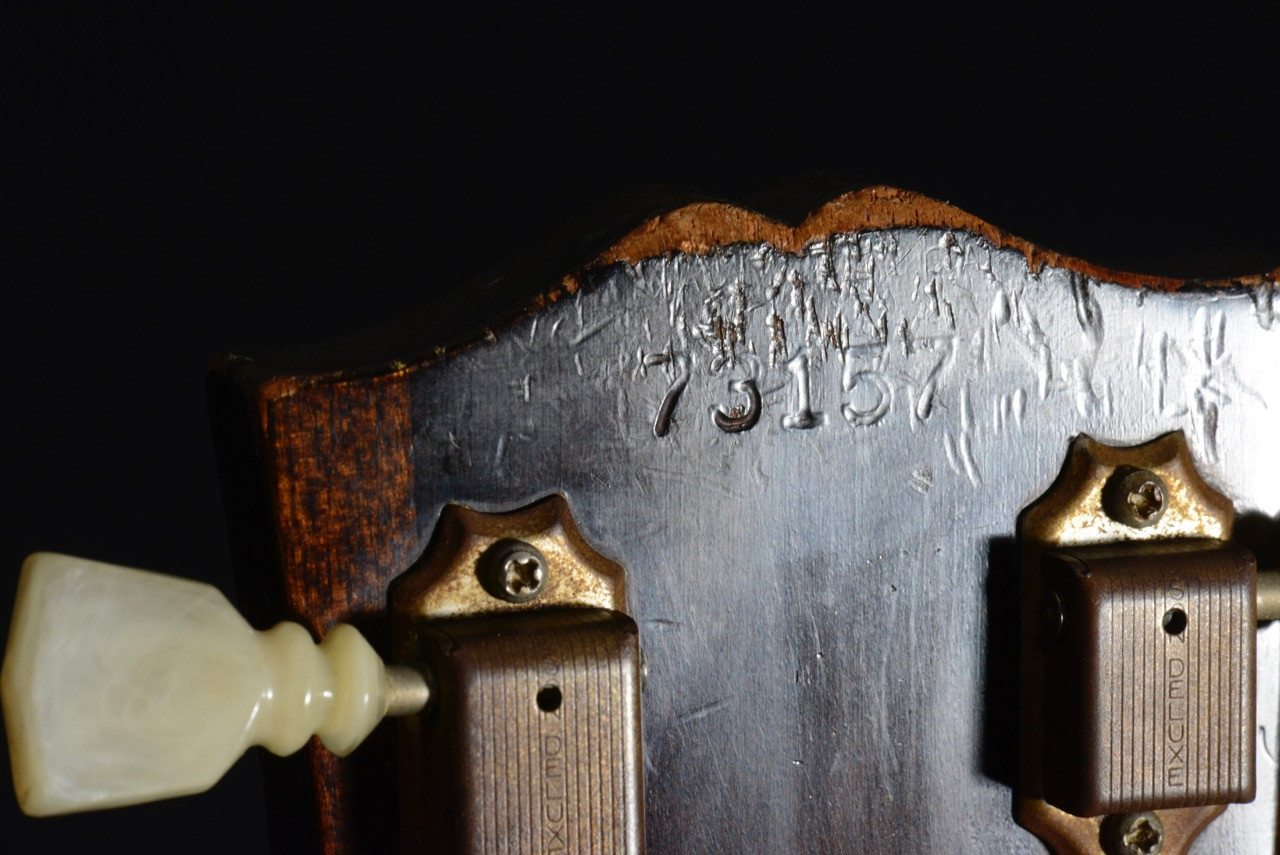 73157
73157
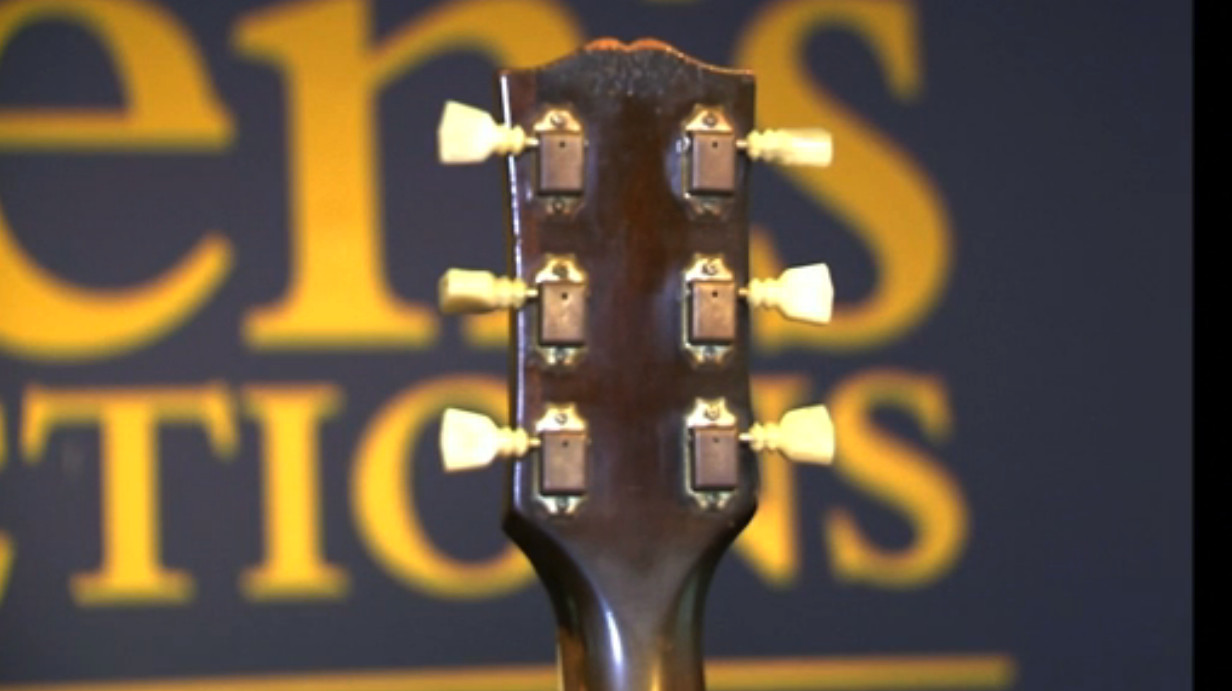 Snip20150604_1.png
Snip20150604_1.png
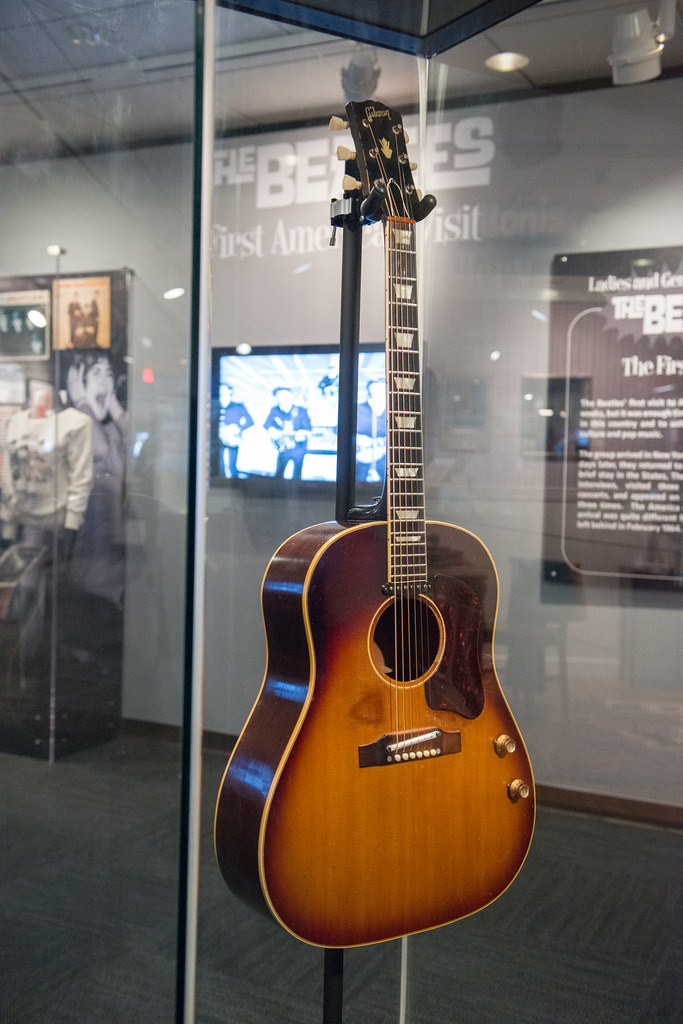 imageslike.com-large-music-dig13762-007.jpg
imageslike.com-large-music-dig13762-007.jpg
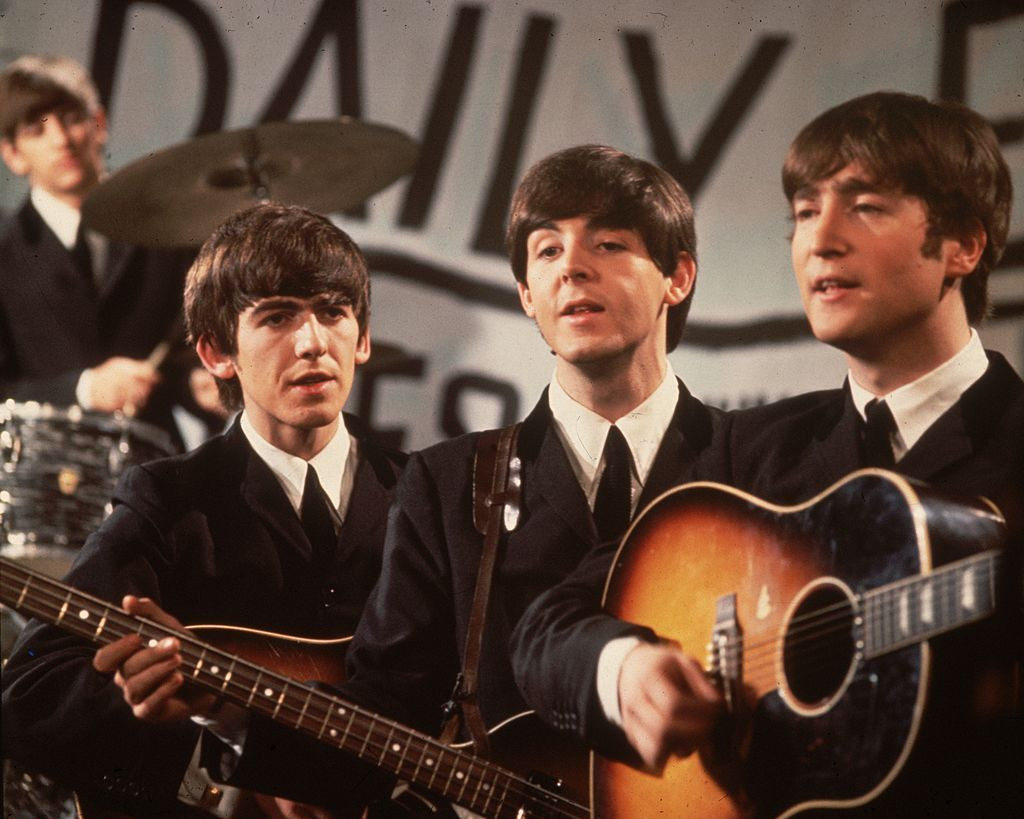 gettyimages-3167282.jpg
gettyimages-3167282.jpg
Ramirez A-1 Classical Guitar “Segovia Model”
Around 1964, Lennon acquired a Ramirez A-1 Classical Guitar, possibly a “Segovia Model,” around the same time George Harrison bought his Ramirez Studio model classical guitar.
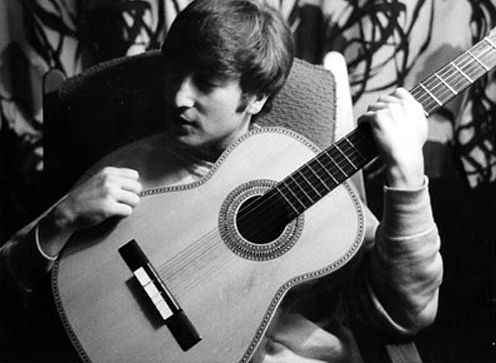 jlramirez
jlramirez
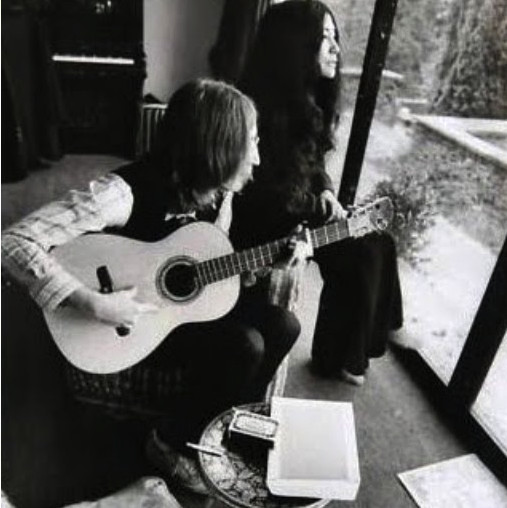 snip20161107_2.png
snip20161107_2.png
Lennon was photographed with this and other classical guitars at his home in the 1960s, indicating his exploration of different guitar styles beyond electric and acoustic-electric models.
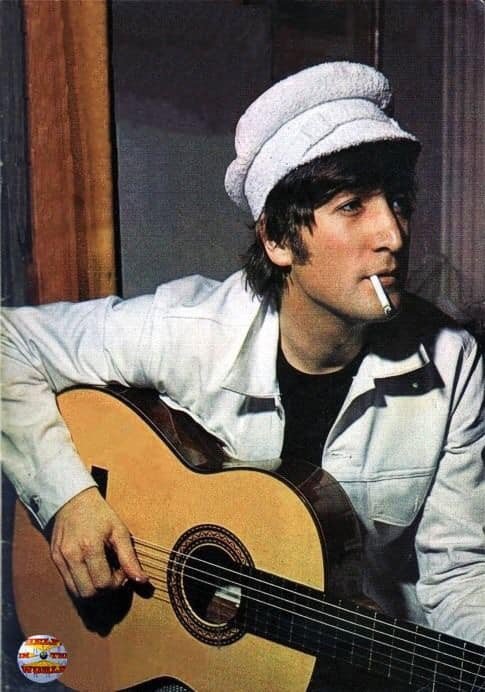 50775280_10215965584486541_6611407587260760064_n.jpg
50775280_10215965584486541_6611407587260760064_n.jpg
Framus Hootenanny 12 String: The “Help!” Guitar
The 1964 Framus 5/024/12 Hootenanny 12 String acoustic guitar, purchased in 1965, is famously associated with The Beatles’ “Help!” era. Lennon played it in the “Help!” movie and on recordings for songs like “Help!”, “You’ve Got To Hide Your Love Away,” and “It’s Only Love.”
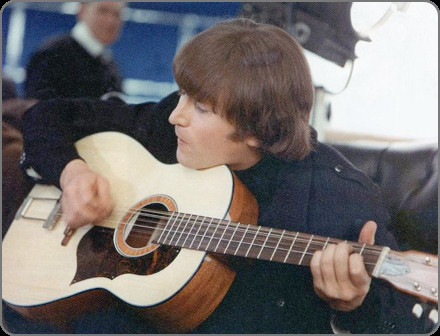 Hootananny
Hootananny
 lennon framus hootenanny
lennon framus hootenanny
This guitar, used by both Lennon and George Harrison, was long thought lost for almost 60 years until its recent rediscovery. It was auctioned at Julien’s Auctions in May 2024, expected to fetch a record price, potentially becoming the most expensive Beatles guitar ever sold.
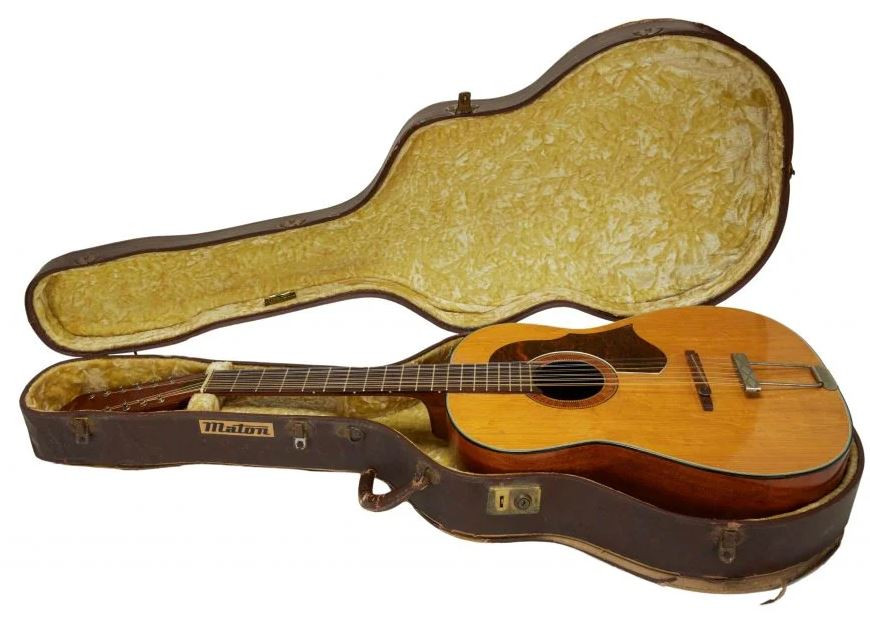 john1.jpg
john1.jpg
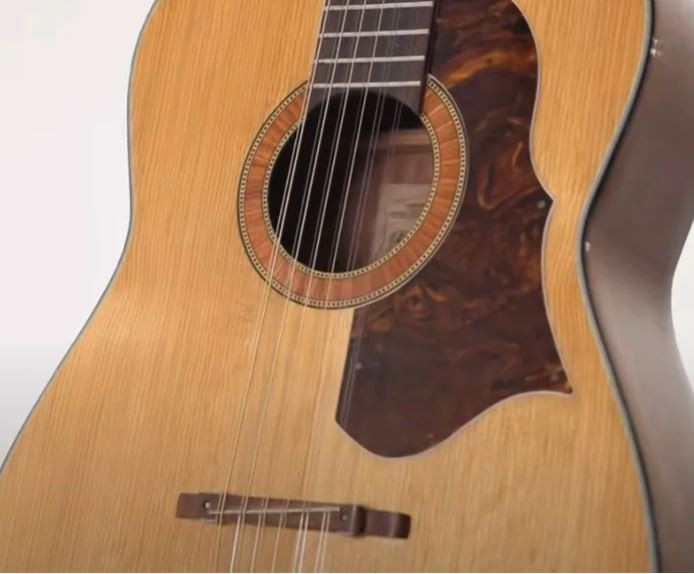 john2.jpg
john2.jpg
 john4.jpg
john4.jpg
Electric Innovations: Stratocasters, Casinos, and More
“Mysterious Black Stratocaster”: A Rehearsal Enigma
A black Fender Stratocaster with a matching black headstock remains one of the most intriguing mysteries in John Lennon’s guitar history. Photographed during a 1965 rehearsal at the Donmar Warehouse, this unique Stratocaster raised questions about its origin and current location.
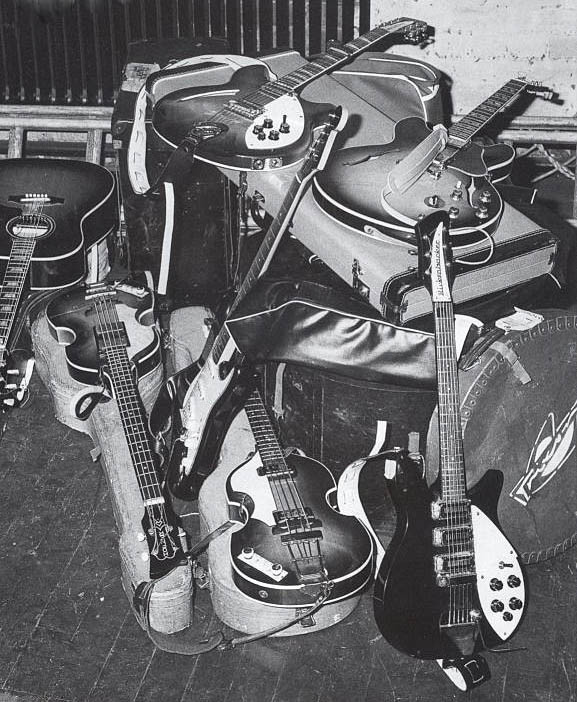 fabgear65
fabgear65
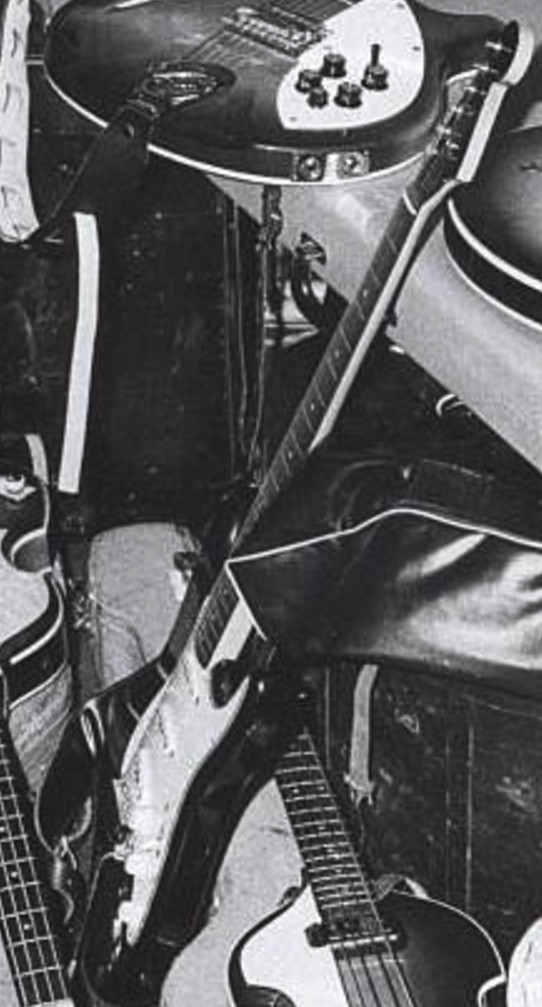 snip20170308_3.png
snip20170308_3.png
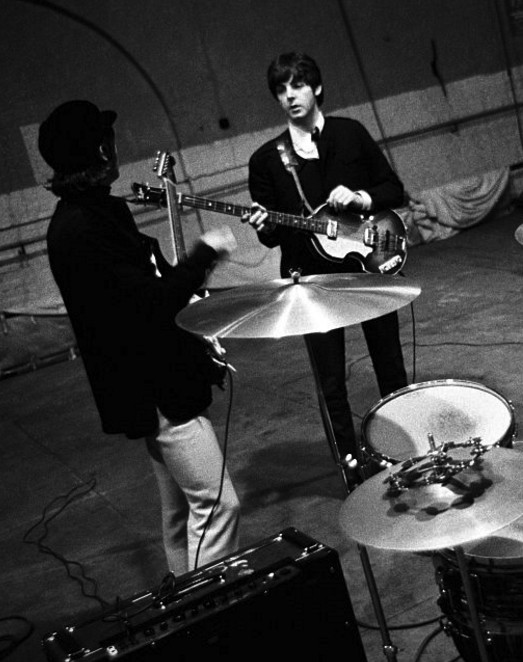 snip20170503_3.png
snip20170503_3.png
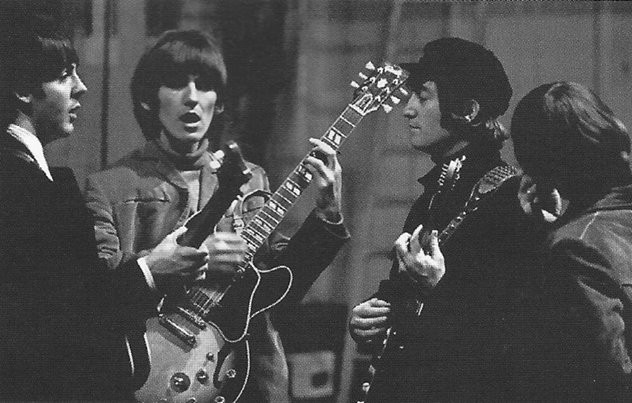 Black Stratocaster
Black Stratocaster
 Black Stratocaster2
Black Stratocaster2
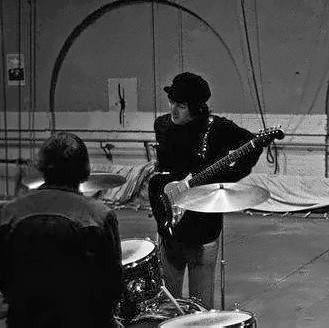 15380287_1395739327105501_2416401292959664444_n.jpg
15380287_1395739327105501_2416401292959664444_n.jpg
Fender claimed they didn’t produce black Strats with black headstocks in 1964 or 1965. Speculation suggests Ivor Arbiter, the UK Fender distributor, might have custom-painted it for Lennon, knowing his preference for black guitars. The guitar’s current whereabouts remain unknown, adding to its mystique.
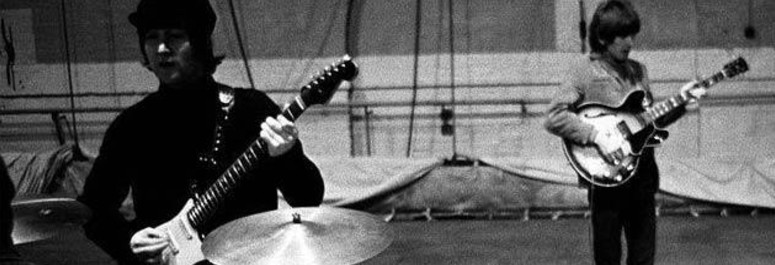 blackstrat.png
blackstrat.png
 snip20160207_4.png
snip20160207_4.png
 reissue.png
reissue.png
The Donmar Warehouse rehearsal hall, the location where John Lennon was photographed with the mysterious black Fender Stratocaster.
Fender’s attempts to endorse The Beatles in the mid-1960s ultimately led to instrument gifts rather than a formal endorsement deal, as Lennon and McCartney were initially reluctant to switch from their preferred guitars.
Epiphone Casino: The Stripped-Down Sound
The 1965 Epiphone E230TD Casino became another crucial guitar in John Lennon’s arsenal from 1966 onwards. He purchased it in London and used it extensively during The Beatles’ final tour in 1966 and on classic albums like “Revolver” and “Sgt. Pepper’s Lonely Hearts Club Band.” He famously stripped down the finish on his Casino to its natural wood, using it for the “Revolution” version on the “White Album,” “Abbey Road,” the Let It Be rooftop concert, and his early solo work.
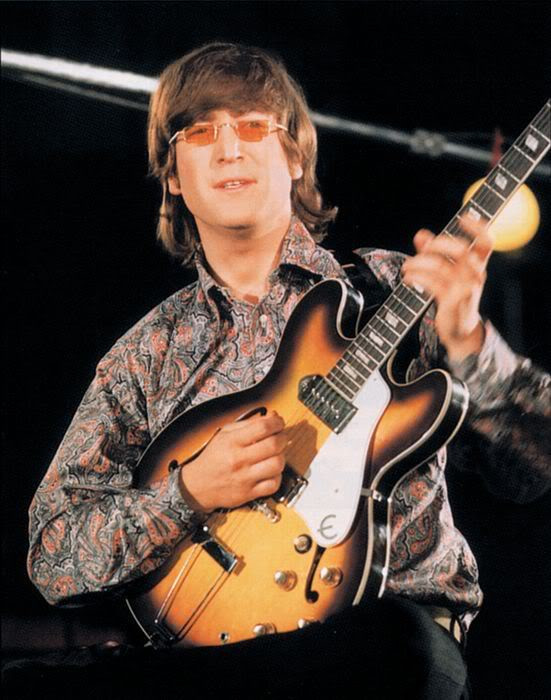 CasinoLennon
CasinoLennon
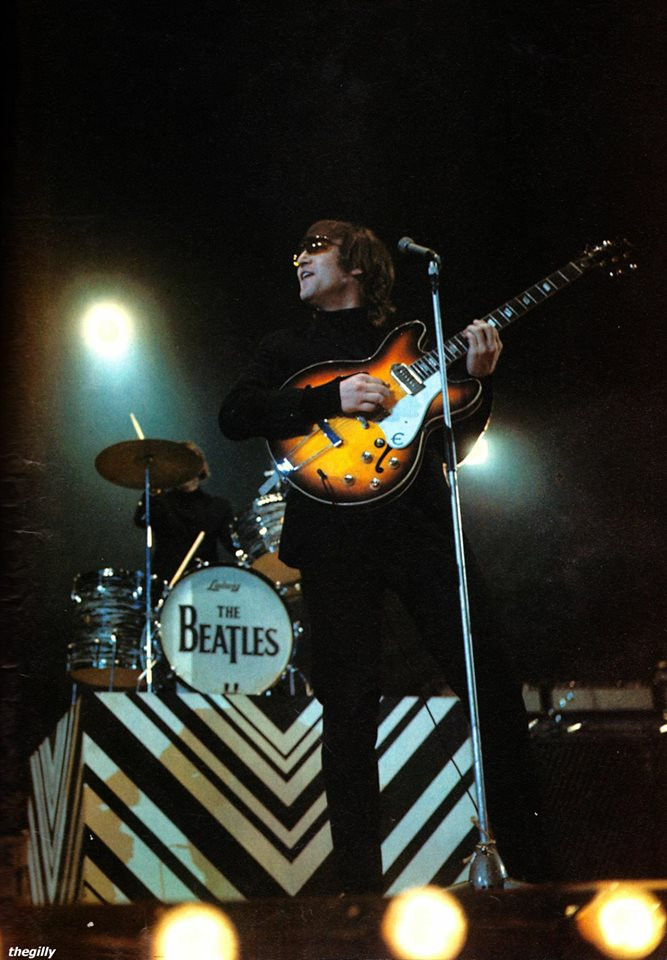 32308846_223138168419021_5175215959937384448_n.jpg
32308846_223138168419021_5175215959937384448_n.jpg
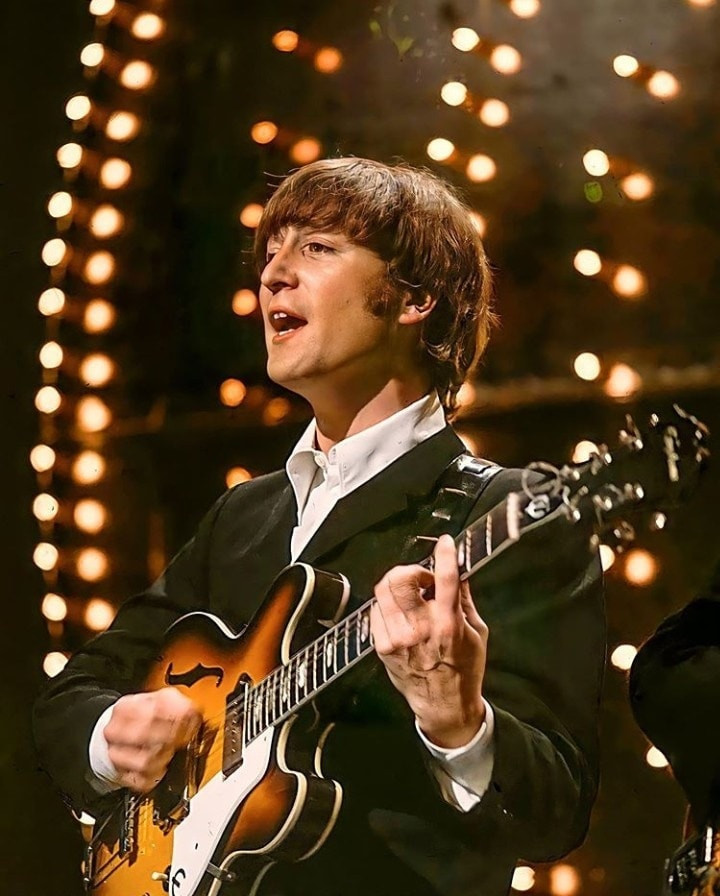 122506036_4479620315444753_5289116188602482708_n.jpg
122506036_4479620315444753_5289116188602482708_n.jpg
The Casino’s lightweight construction and versatile sound made it a favorite for both recording and live performance. George Harrison also acquired a Casino, reflecting their shared preference for matching guitars.
 john.png
john.png
 f0f95e4c676609ab.jpg
f0f95e4c676609ab.jpg
Gretsch G6120DC (Nashville): “Paperback Writer” Sound
The 1964 Gretsch G6120DC (Nashville) is primarily known for its use on The Beatles’ “Paperback Writer” recording session. Photographs from the session in April 1966 document Lennon using this orange-finished, double-cutaway hollow-body guitar with gold-plated hardware.
 John_Lennon
John_Lennon
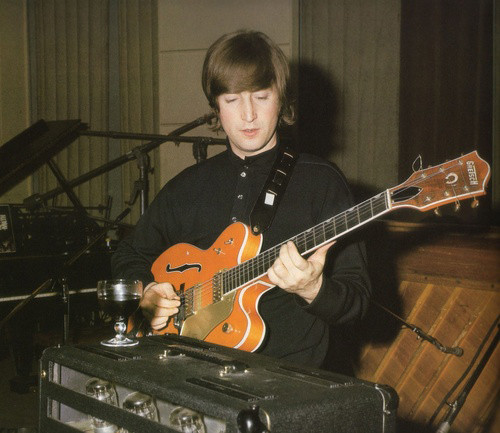 JohnLennongretsch
JohnLennongretsch
After the “Paperback Writer” session, the Gretsch seemingly remained at Lennon’s home. In 1967, he gifted it to his cousin, David Birch, who later loaned it to The Beatles Story museum in Liverpool.
Guild Starfire XII: A 12-String Gift
Guild Guitars gifted Lennon a 1966 Guild Starfire XII electric 12-string guitar in August 1966. While it likely didn’t see studio use, it was probably used in his home studio.
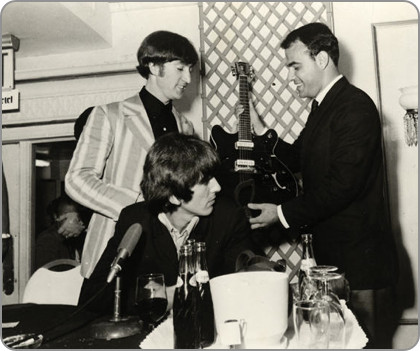 lennon-guild
lennon-guild
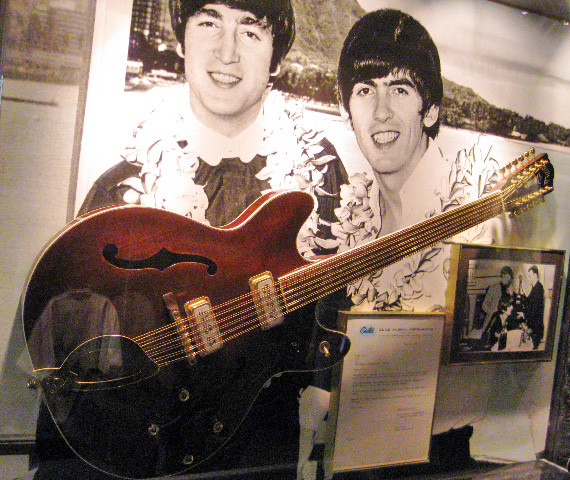 Lennon12string
Lennon12string
 The_Beatles
The_Beatles
The guitar, a one-off in flame maple with gold-plated hardware, was presented to Lennon by Mark Dronge of Guild Guitars. It eventually ended up with Yoko Ono’s first husband, Tony Cox, and is currently displayed at the Hard Rock Cafe in Honolulu, Hawaii.
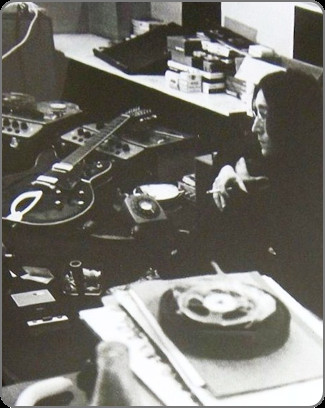 shapeimage_2.png
shapeimage_2.png
Martin D-28: Acoustic Simplicity
John Lennon owned several Martin D-28 acoustic guitars. In December 1969, he gifted a 1965 Martin D-28 to rockabilly artist Ronnie Hawkins. However, the guitar Hawkins currently possesses is a 1972 D-28, suggesting a possible mix-up or exchange over time.
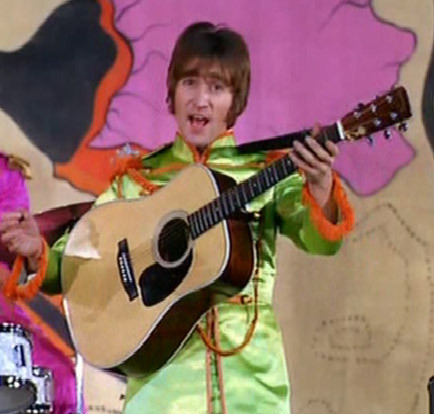 jlmartin02
jlmartin02
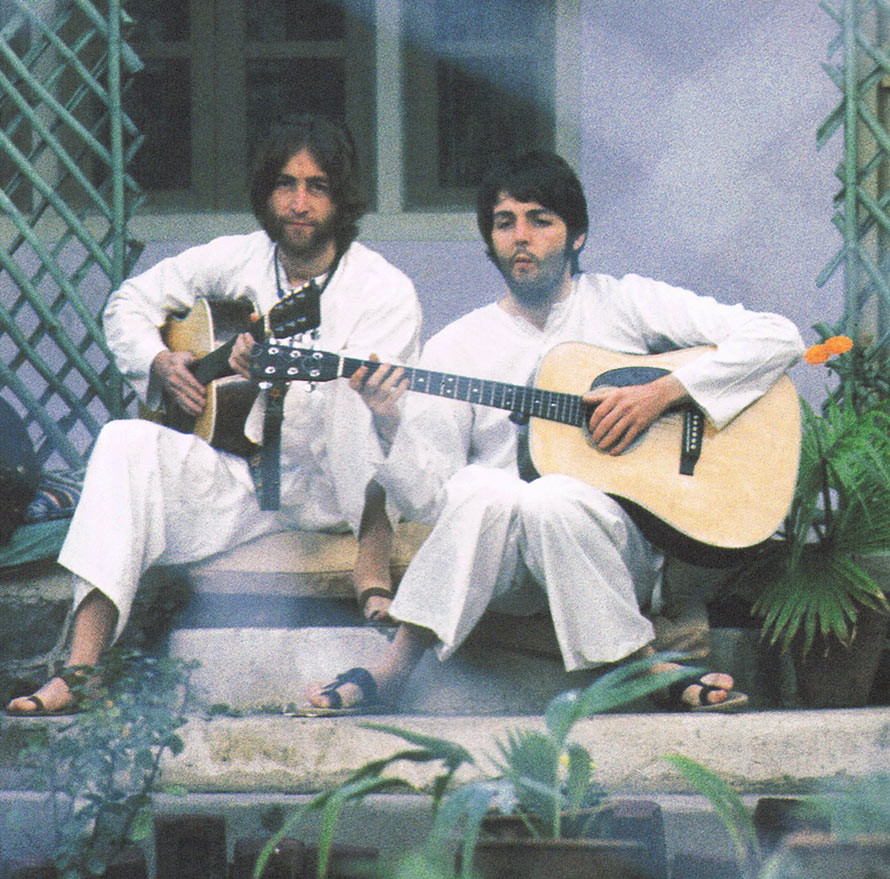 Reshekesh
Reshekesh
Lennon also owned a 1962 C.F. Martin D-28, a workhorse acoustic that he used extensively.
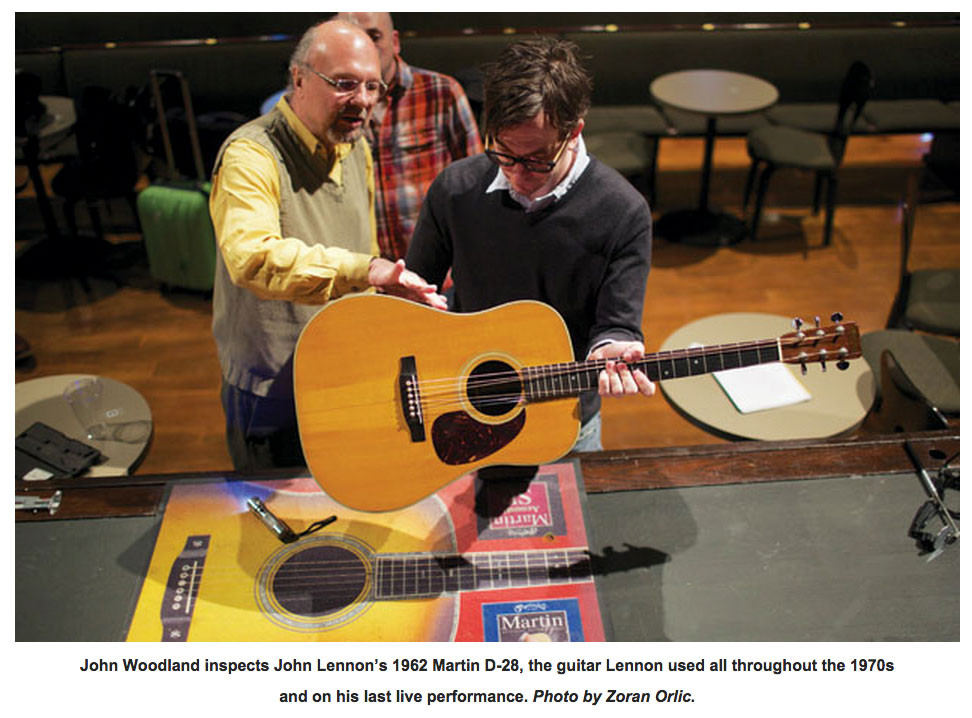 1962Martin
1962Martin
 Johns Martin3
Johns Martin3
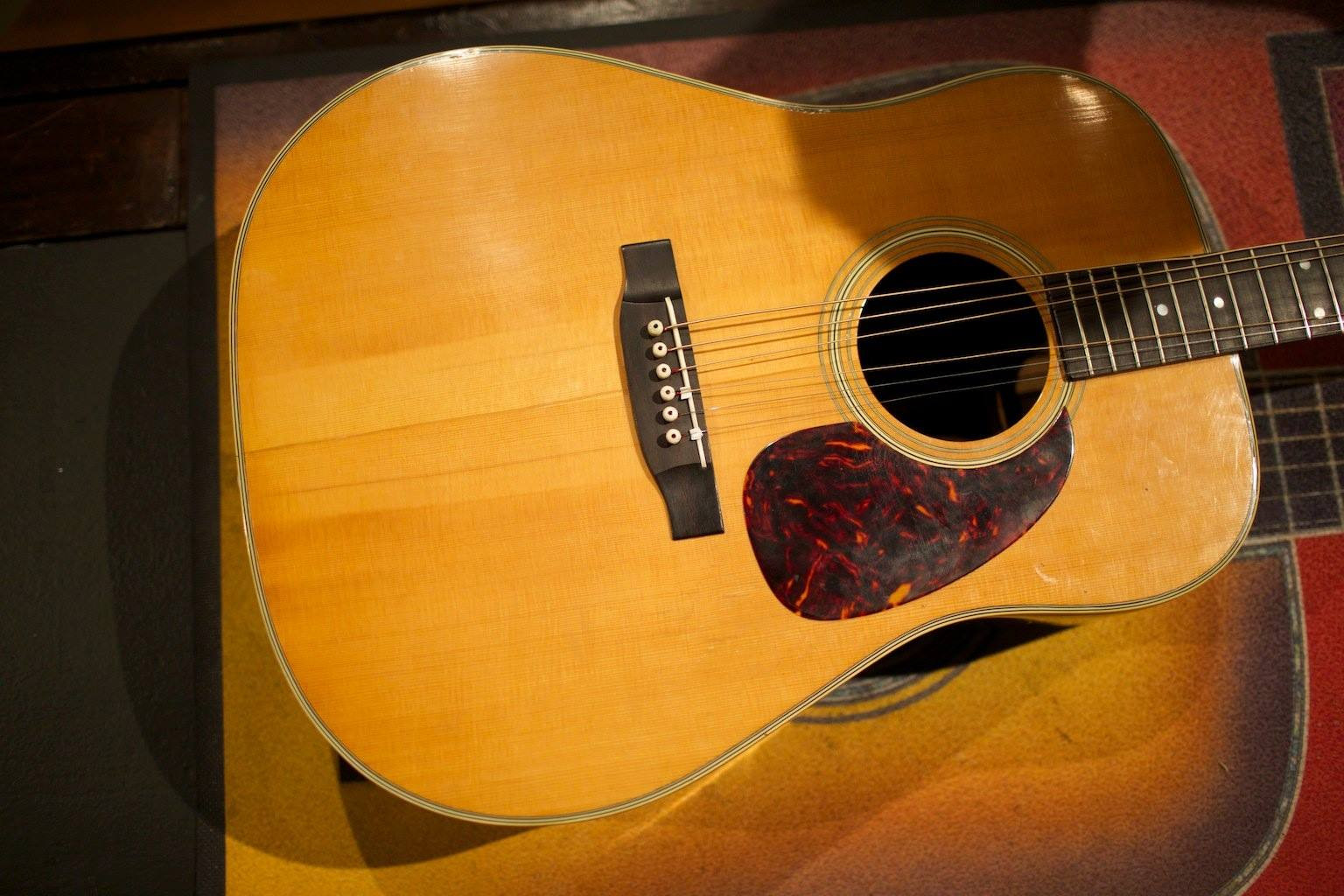 Johns martin1
Johns martin1
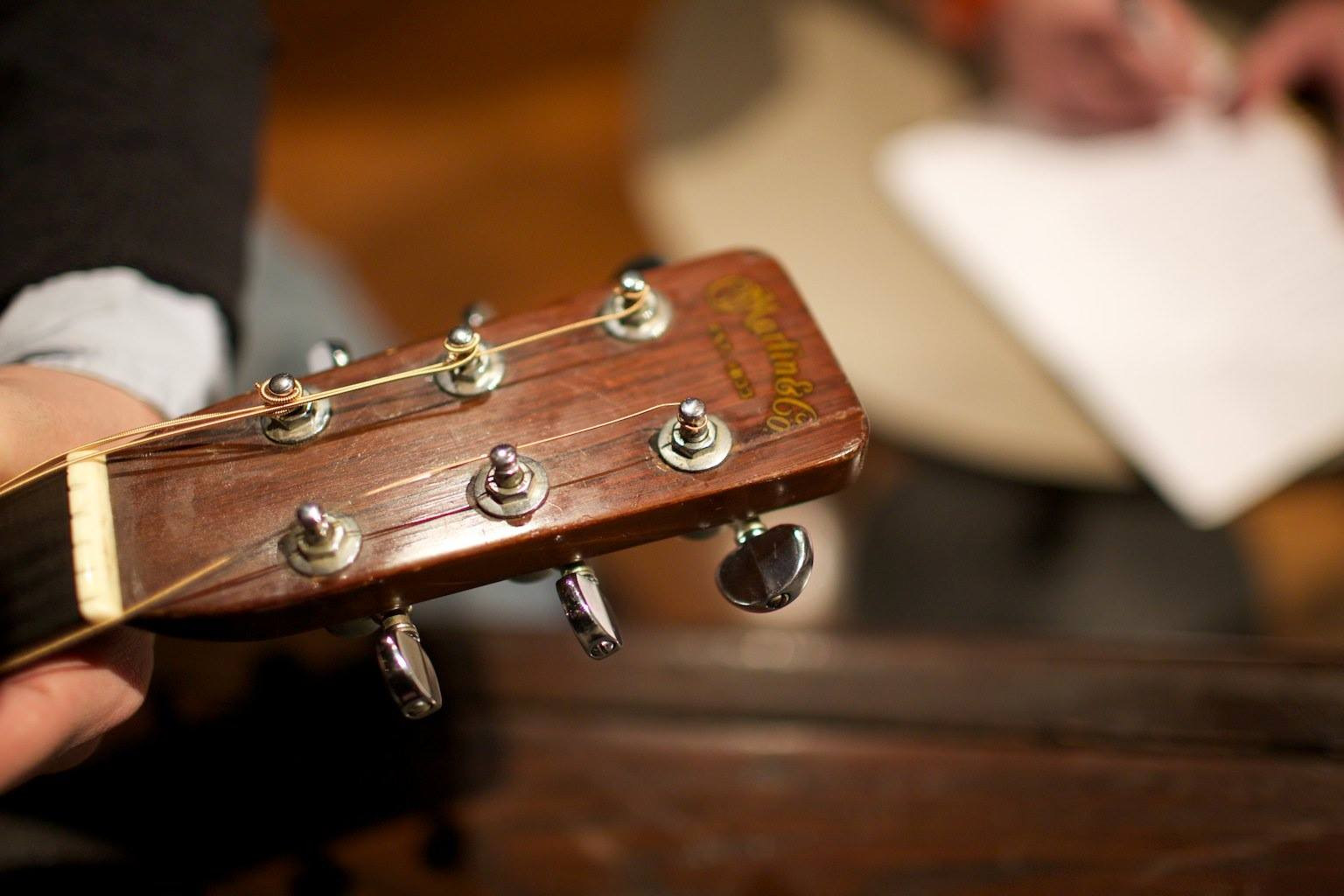 Johns Martin 4
Johns Martin 4
 Johns Martin2
Johns Martin2
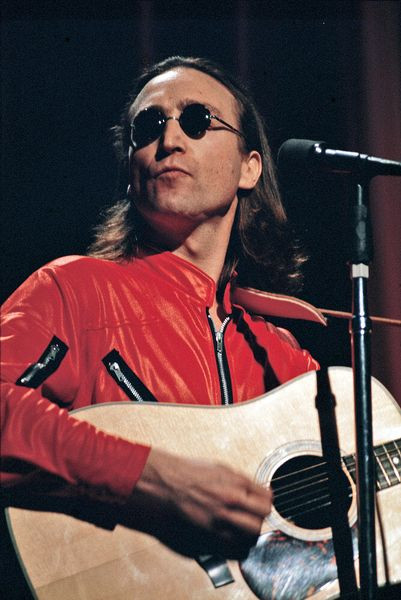 04-john_lennon_guitar_1975.jpg
04-john_lennon_guitar_1975.jpg
Sonic Blue Fender Stratocaster: Pepper Era Sounds
A 1961 Sonic Blue Fender Stratocaster became a prominent guitar for Lennon from 1965 to 1968, coinciding with The Beatles’ psychedelic “Pepper” era.
 Strat
Strat
 48c27ae22e23689a58057979ffc8dbe4.jpg
48c27ae22e23689a58057979ffc8dbe4.jpg
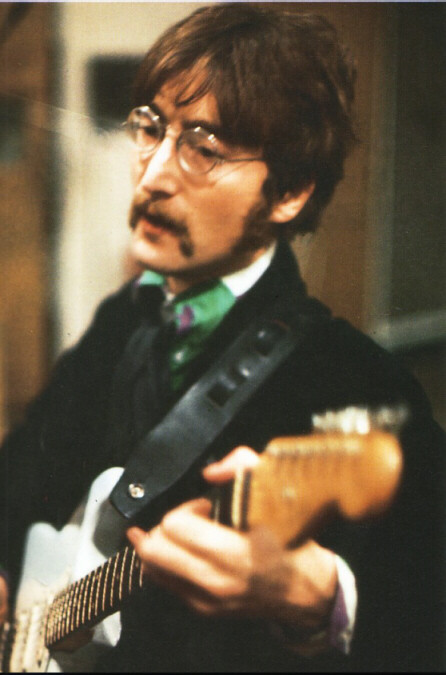 johnstrat67
johnstrat67
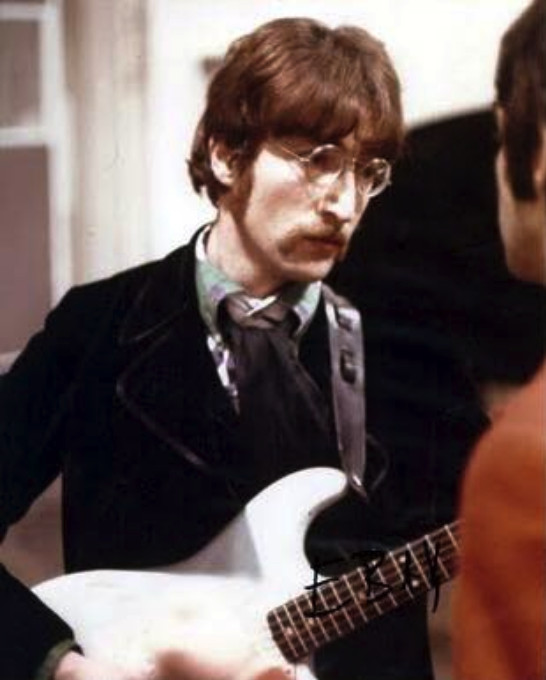 snip20181014_1.png
snip20181014_1.png
In 1965, roadie Mal Evans purchased two used Sonic Blue Stratocasters for Lennon and George Harrison. Harrison’s “Rocky” Stratocaster is well-documented, while details about Lennon’s Sonic Blue Strat are less clear, with some confusion about its exact year of manufacture.
 2Strats
2Strats
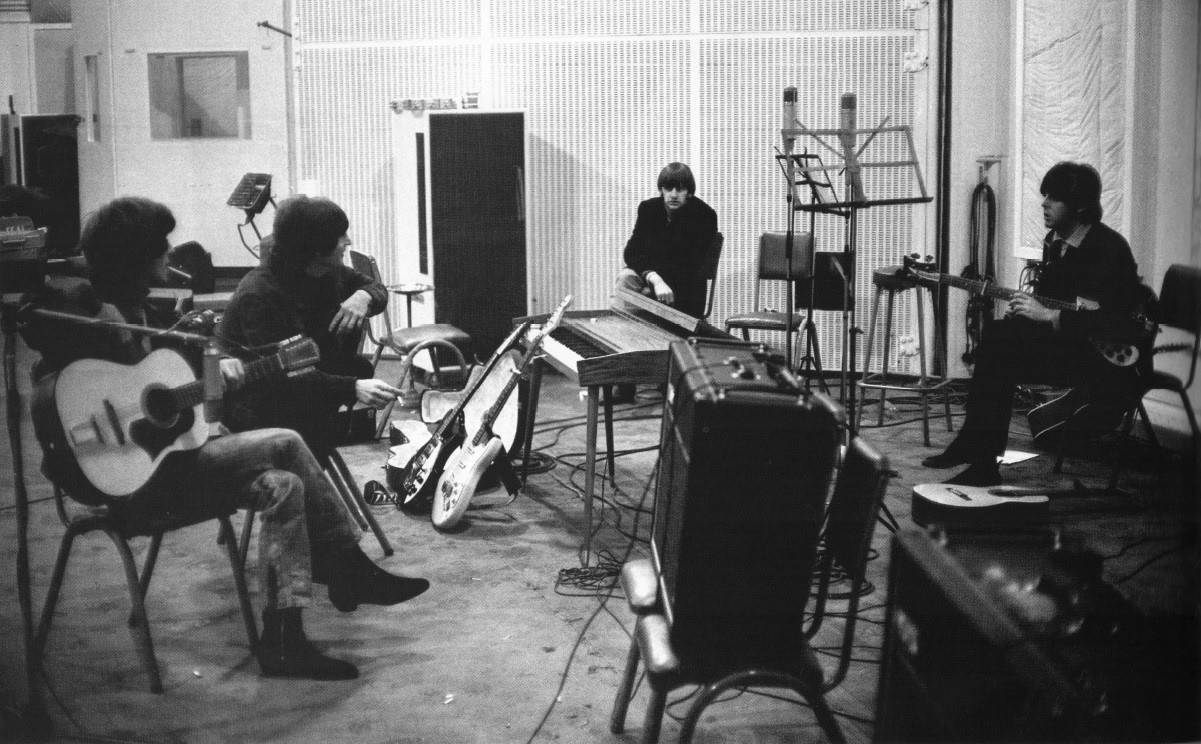 29356967_1655281667925367_5012862502476709888_o.jpg
29356967_1655281667925367_5012862502476709888_o.jpg
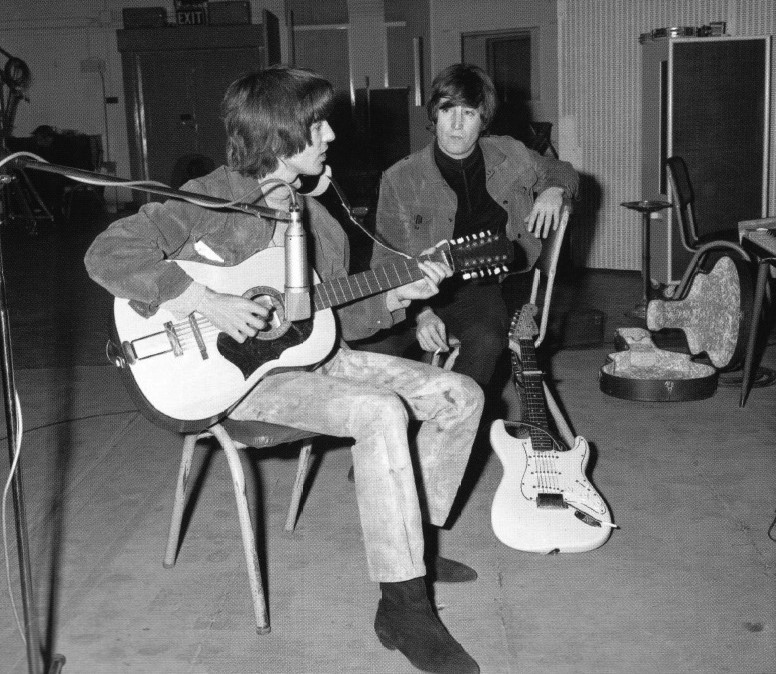 18557149_1354979337955603_5652447315860220801_n.jpg
18557149_1354979337955603_5652447315860220801_n.jpg
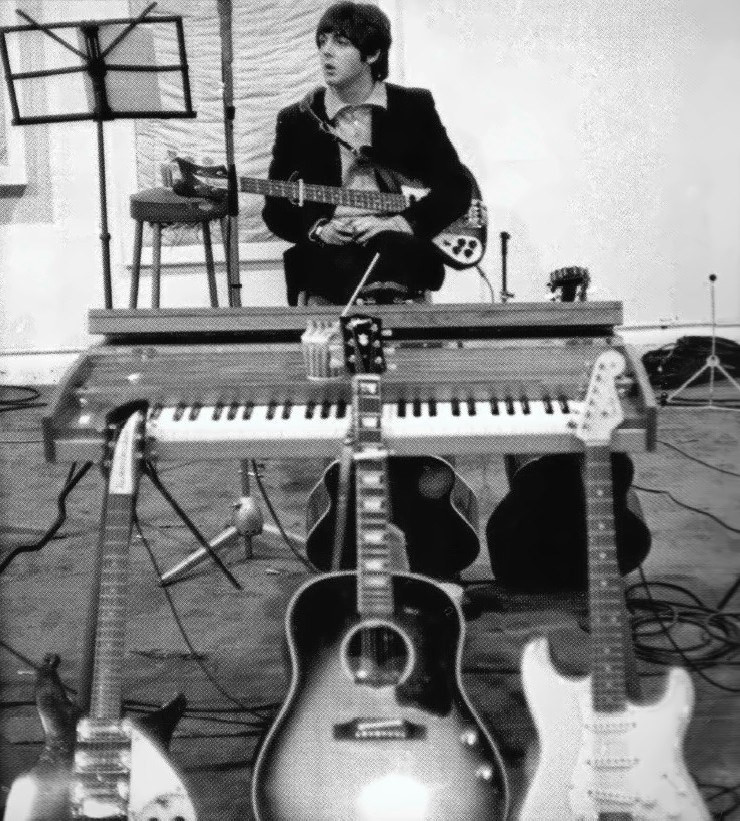 18740159_1579686825377416_6112828729968678111_n.jpg
18740159_1579686825377416_6112828729968678111_n.jpg
Fender Custom Shop has created a “Beatle Spec” 1961 Relic Stratocaster in Sonic Blue, honoring the guitars used by Lennon and Harrison.
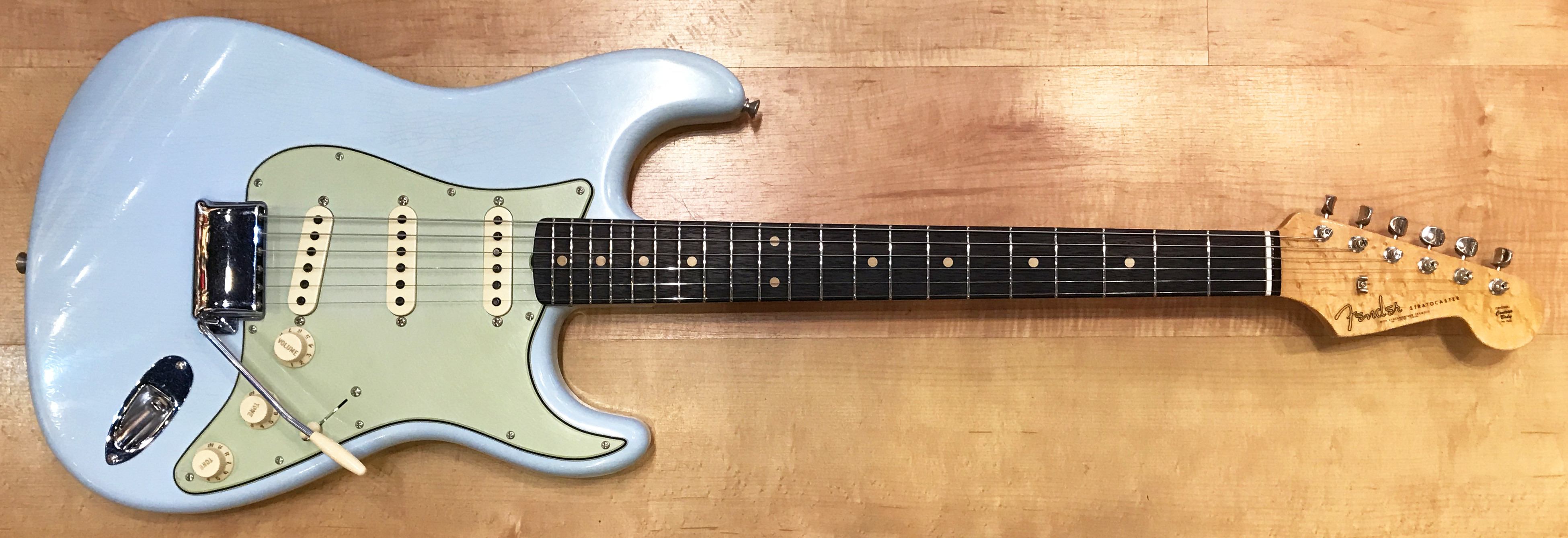 fender_custom_shop_beatle_spec_1961_relic_stratocaster_electric_guitar_sonic_blue_john_lennon_george_harrison_48543.jpg
fender_custom_shop_beatle_spec_1961_relic_stratocaster_electric_guitar_sonic_blue_john_lennon_george_harrison_48543.jpg
Vox V251 Guitar-Organ Hybrid: An Experimental Prototype
The 1966 Vox V251 Guitar-Organ Hybrid was an experimental prototype given to John Lennon by Vox in an attempt to secure an endorsement. This unique instrument combined a Phantom VI guitar with internal organ electronics.
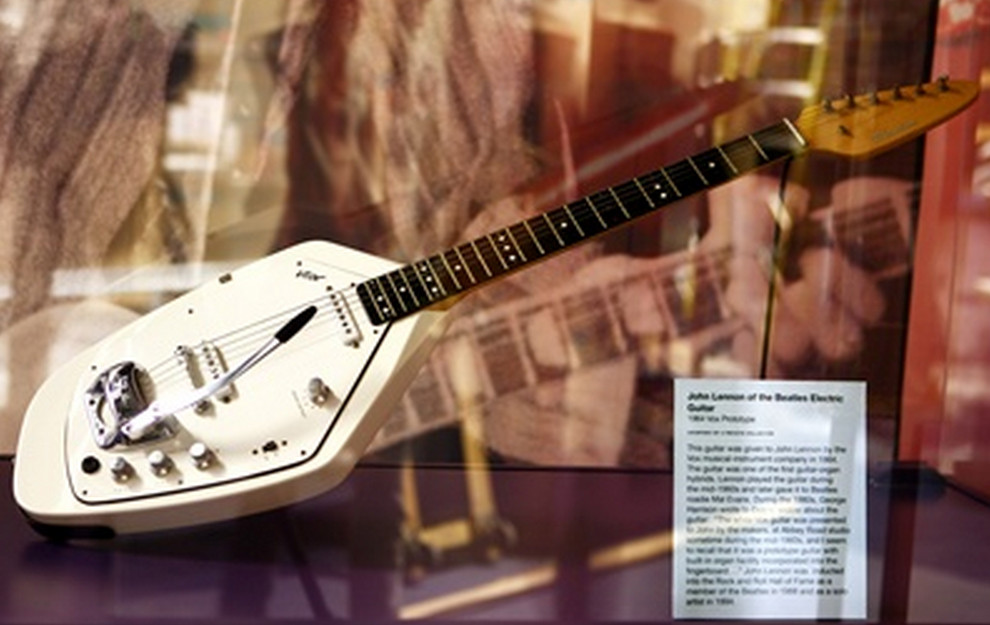 John
John
 john-lennon-j-160e-gibson-acoustic-guitar-auction-17.jpg
john-lennon-j-160e-gibson-acoustic-guitar-auction-17.jpg
Despite the endorsement not materializing, Lennon owned this rare guitar, which sold for $305,000 at a Sotheby’s auction in 2014.
Ovation 1651-7 Legend Acoustic Guitar: Recording Sessions Companion
The Ovation 1651-7 Legend Acoustic Guitar was used by John Lennon in several recording sessions.
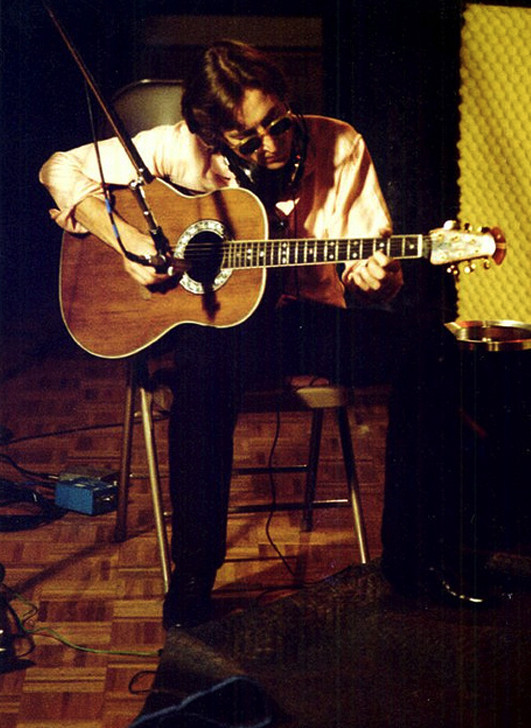 snip20161106_5.png
snip20161106_5.png
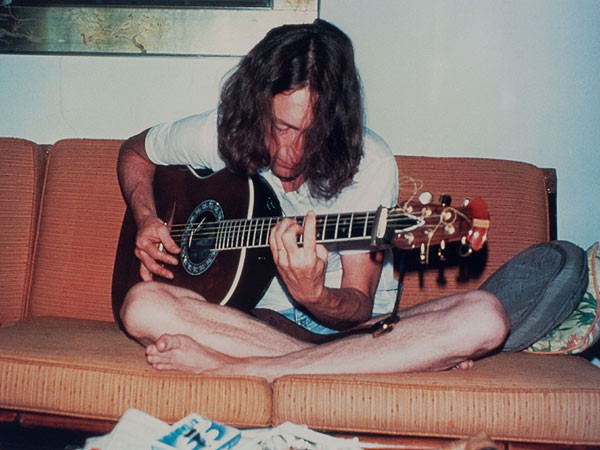 john-lennon-600×450.jpg
john-lennon-600×450.jpg
National Reso-Phonic TriCone Steel Resonator: Rallying for Freedom
A National Reso-Phonic TriCone Steel Resonator guitar was played by John Lennon onstage at the John Sinclair Freedom Rally in December 1972.
A National Reso-Phonic TriCone Steel Resonator guitar, similar to the one John Lennon played at the John Sinclair Freedom Rally.
A close-up view of a National Reso-Phonic TriCone guitar, highlighting its resonator cones and unique sound.
Hofner 5140 Hawaiian Standard Lap Steel: “For You Blue” Slide
The Hofner 5140 Hawaiian Standard lap steel guitar is associated with The Beatles’ “For You Blue.” Lennon played lap steel on this track, famously using a shotgun shell as a slide.
John Lennon playing a Hofner 5140 Hawaiian Standard lap steel guitar, likely during the “Let It Be” sessions.
 johnslide
johnslide
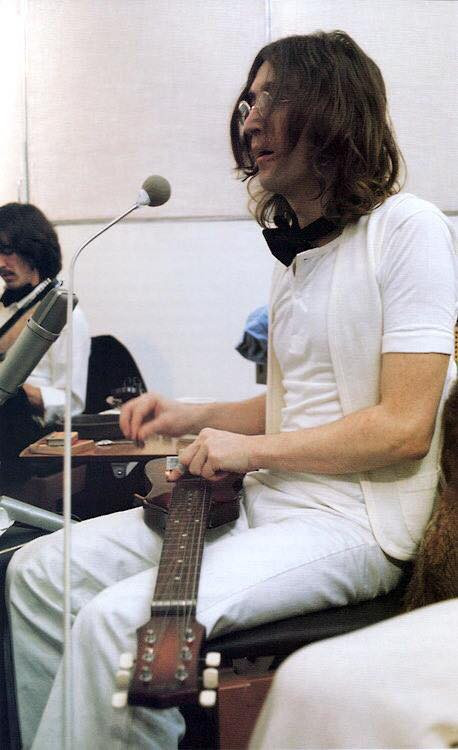 34032585_10156379797119814_3177524467526008832_n.jpg
34032585_10156379797119814_3177524467526008832_n.jpg
Black Fender Telecaster: Madison Square Garden Finale
A 1963 Black Fender Telecaster became another notable guitar in Lennon’s collection. His last public performance with this Telecaster was in November 1974 when he joined Elton John onstage at Madison Square Garden, performing “Whatever Gets You Through the Night.”
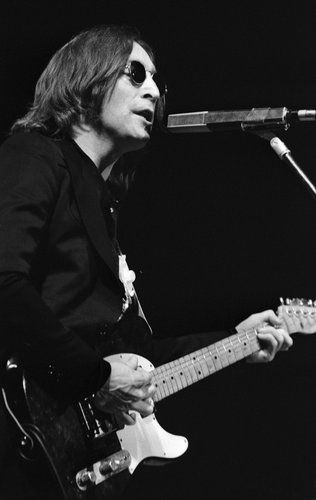 a87fe557b0003165f3e8360517dde07d.jpg
a87fe557b0003165f3e8360517dde07d.jpg
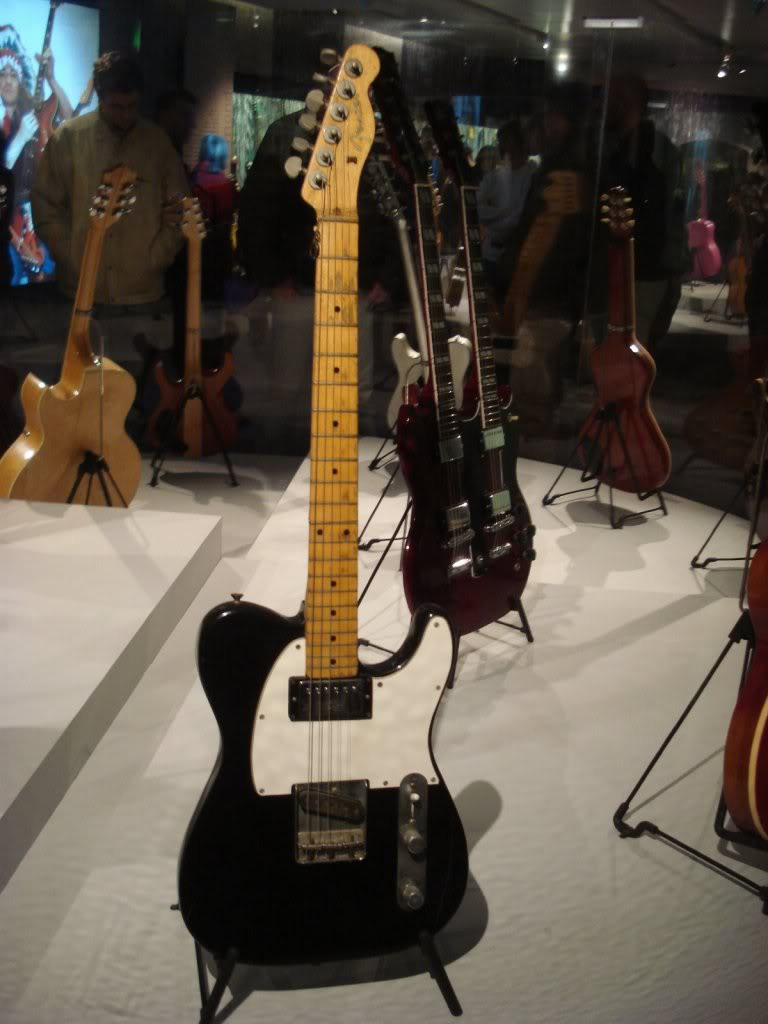 JohnLennonTelecaster
JohnLennonTelecaster
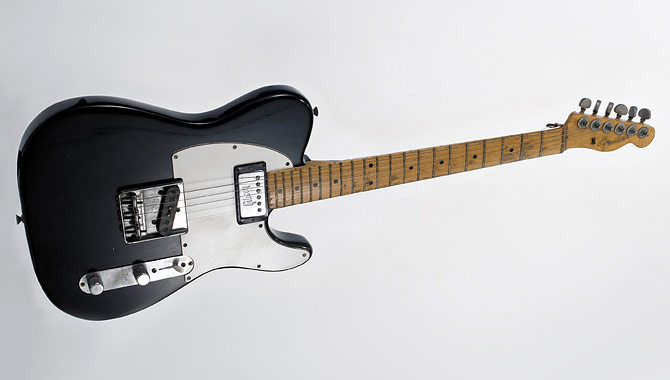 jlennon_4.jpg
jlennon_4.jpg
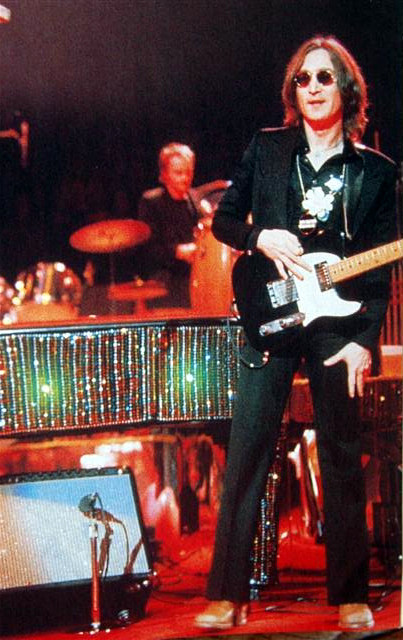 1190
1190
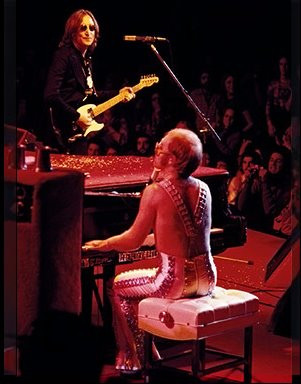 4592038819_64ca5a3799.jpg
4592038819_64ca5a3799.jpg
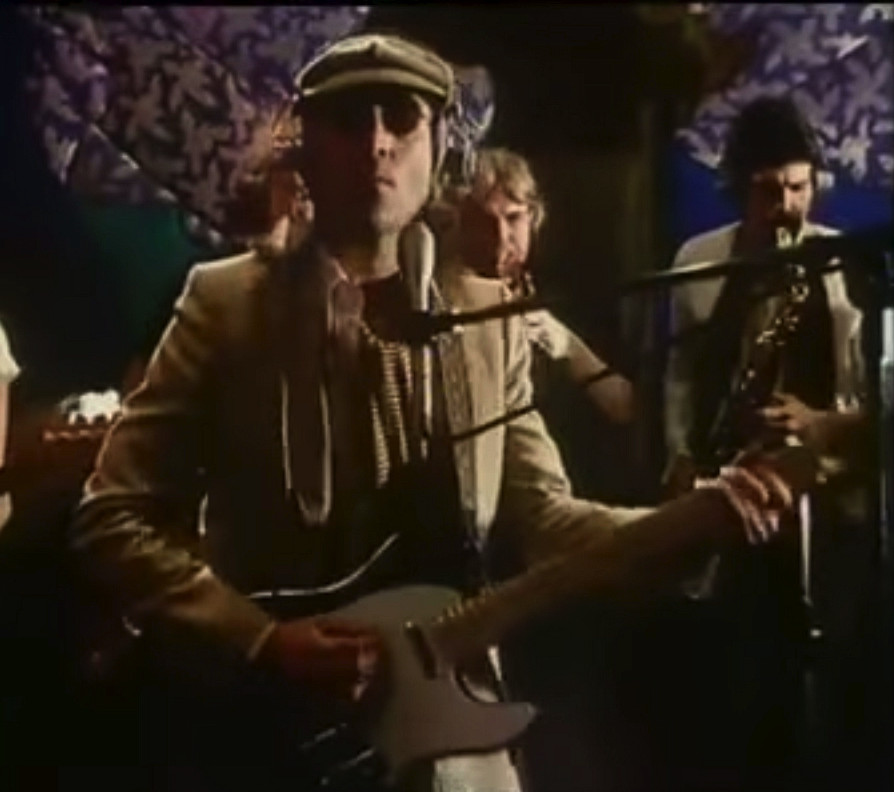 Snip20160819_1.png
Snip20160819_1.png
1956 Les Paul Junior: Stripped-Down Rock
A 1956 Les Paul Junior became another of Lennon’s favored guitars in the early 1970s. Originally tobacco sunburst, it was stripped down to a natural finish, and luthier Ron DeMarino installed a Charlie Christian pickup in the neck position. Lennon played this modified Les Paul Junior extensively in the early 70s, including at his Madison Square Garden performance in 1972.
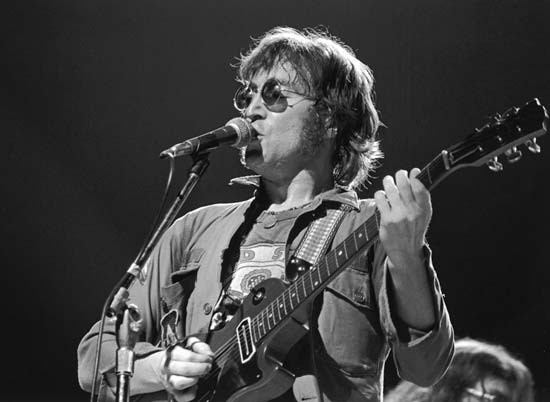 john-lennon-plays-come-together.jpg
john-lennon-plays-come-together.jpg
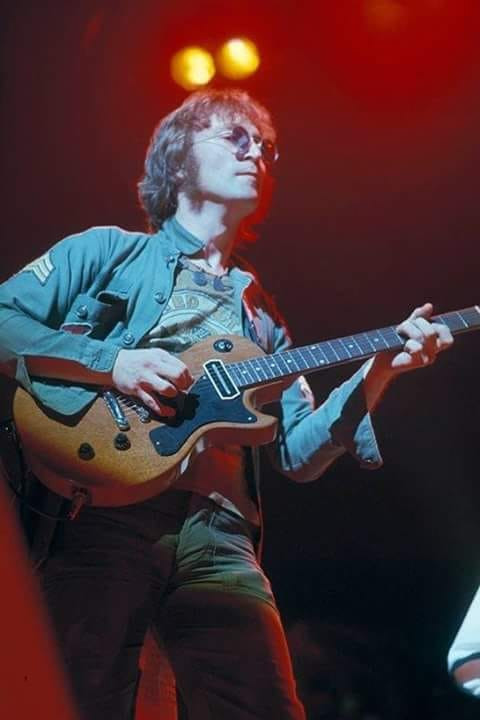 38851108_162697651290746_1571063088000532480_n.jpg
38851108_162697651290746_1571063088000532480_n.jpg
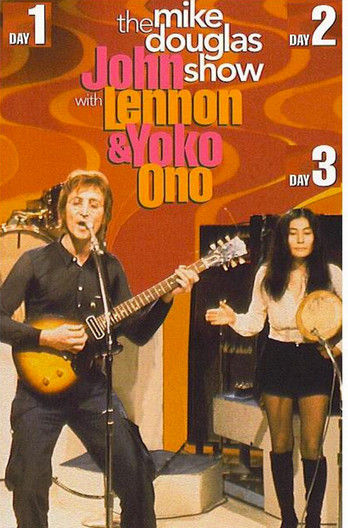 LespaulJR
LespaulJR
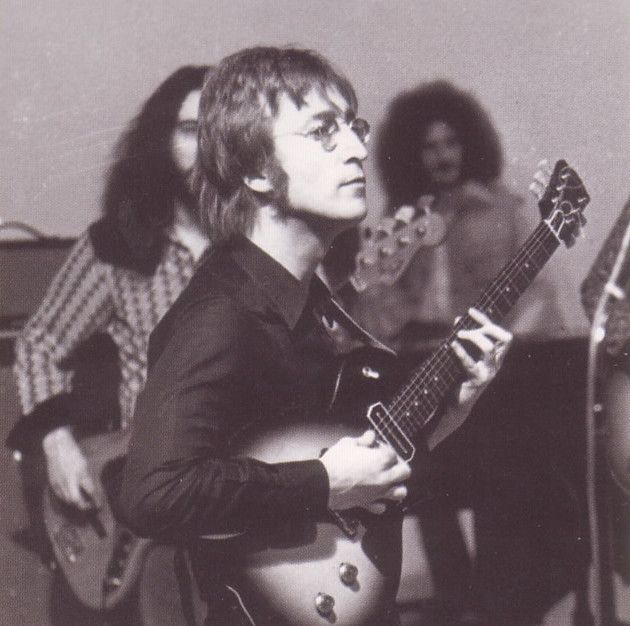 LesPaulJROriginal
LesPaulJROriginal
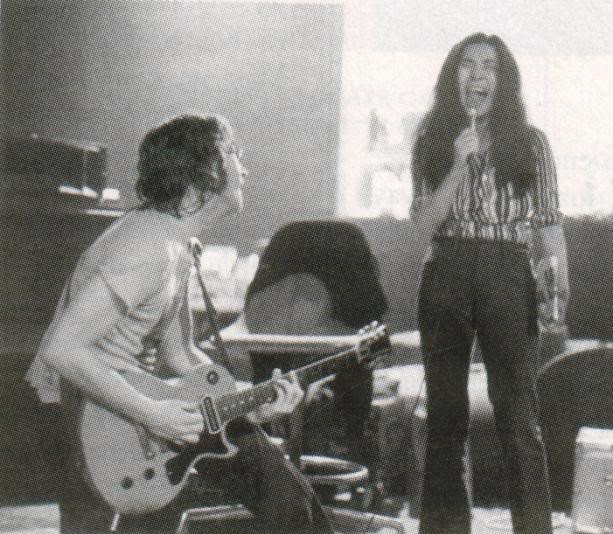 JohnLennonLesPaulJr
JohnLennonLesPaulJr
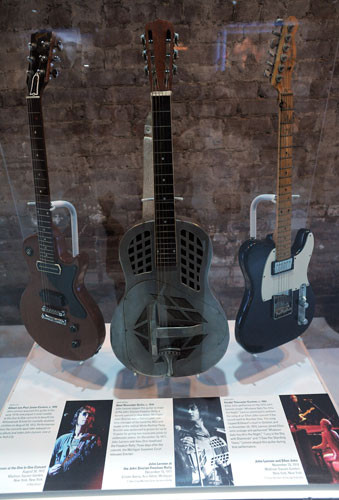 john-lennon-exhibition-jo-008.jpg
john-lennon-exhibition-jo-008.jpg
1960 Les Paul Standard: A Collaboration with Jagger
A 1960 Les Paul Standard appeared briefly in Lennon’s hands in November 1972 during a collaboration with Mick Jagger and Wayne “Tex” Gabriel at the Record Plant in New York.
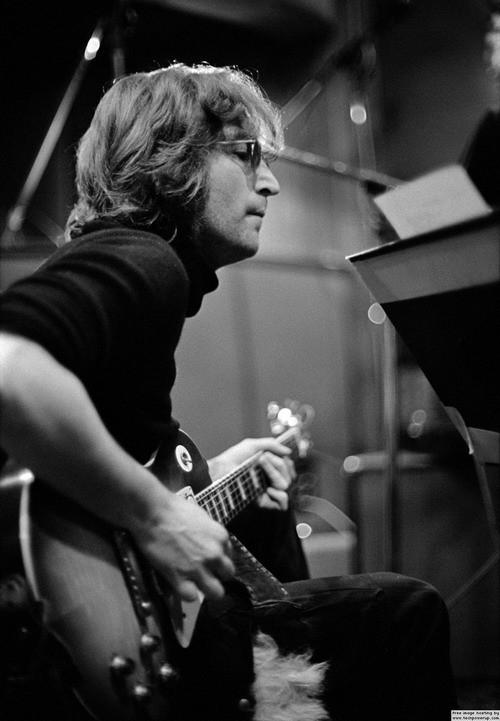 johnlennon.jpg
johnlennon.jpg
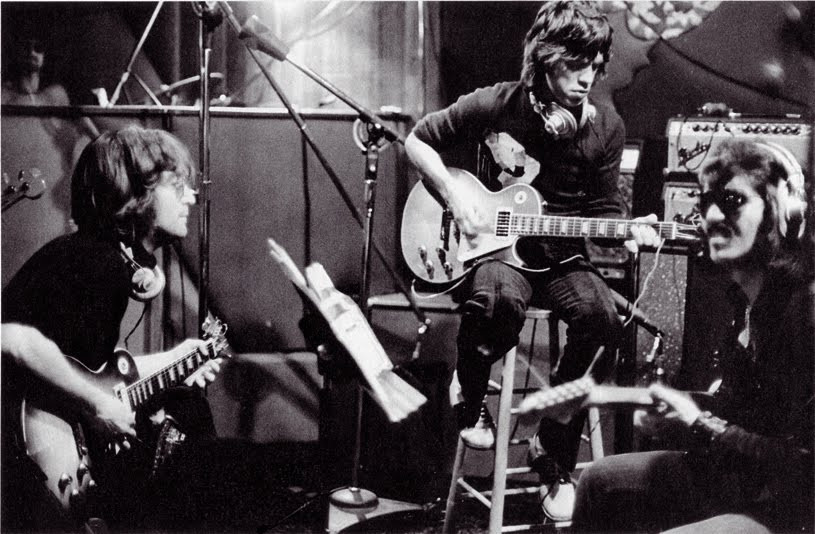 Too-many-cooks
Too-many-cooks
 snip20161106_6.png
snip20161106_6.png
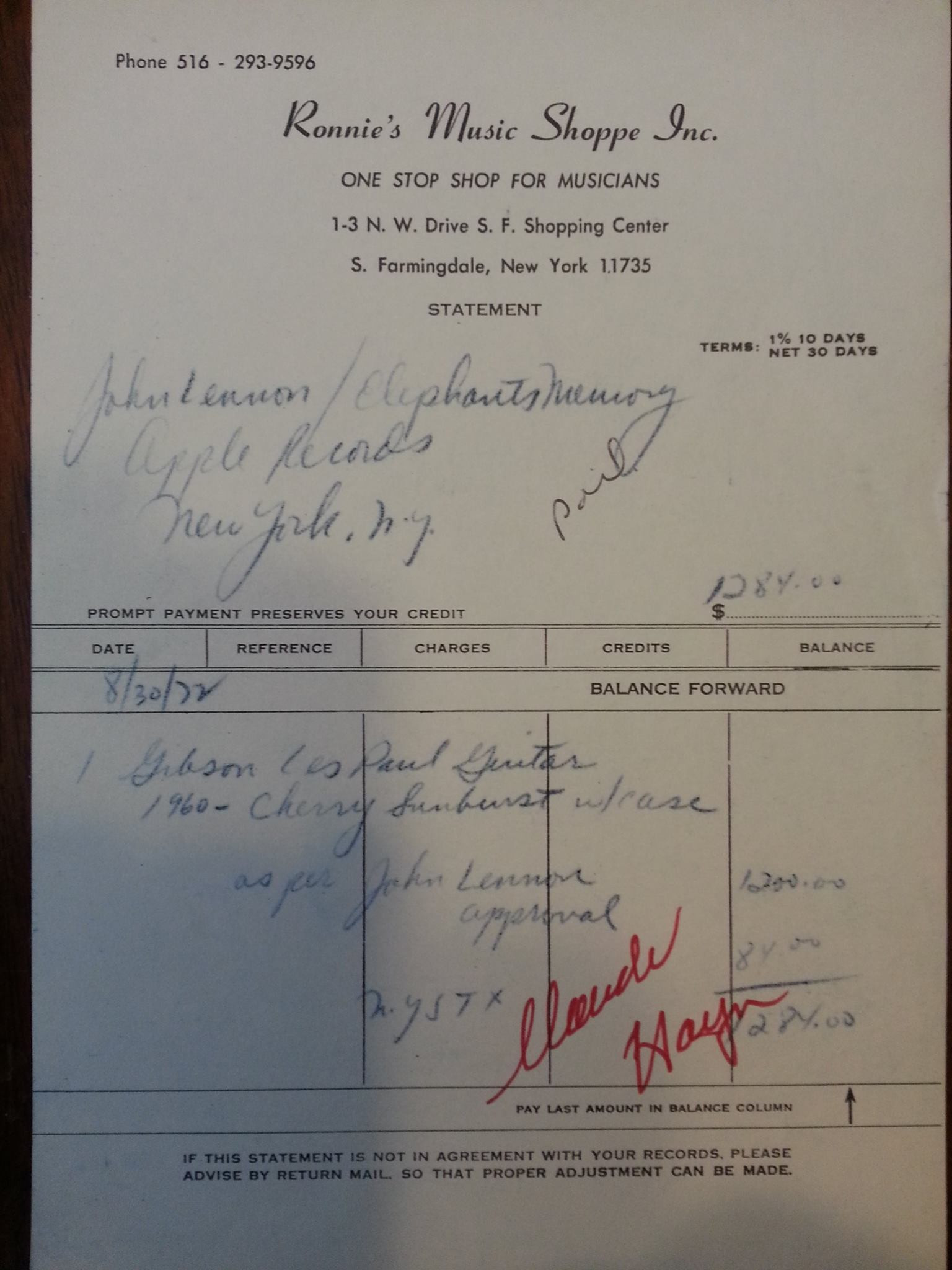 1960LesPaul
1960LesPaul
Sardonyx 800 DII Guitar: Double Fantasy Secret Weapon
The Sardonyx 800 DII Guitar, a rare model built by Ken Schaffer, became Lennon’s “secret weapon” during the “Double Fantasy” sessions. Only 15 to 20 of these guitars were ever made, making it one of the rarest guitars associated with Lennon.
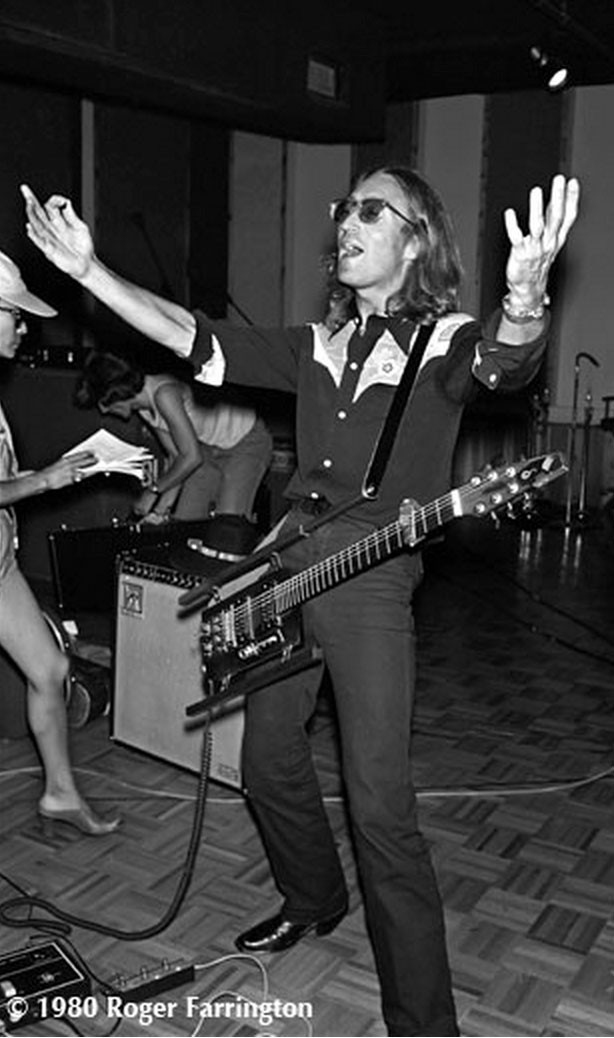 Sardonyx-guitar
Sardonyx-guitar
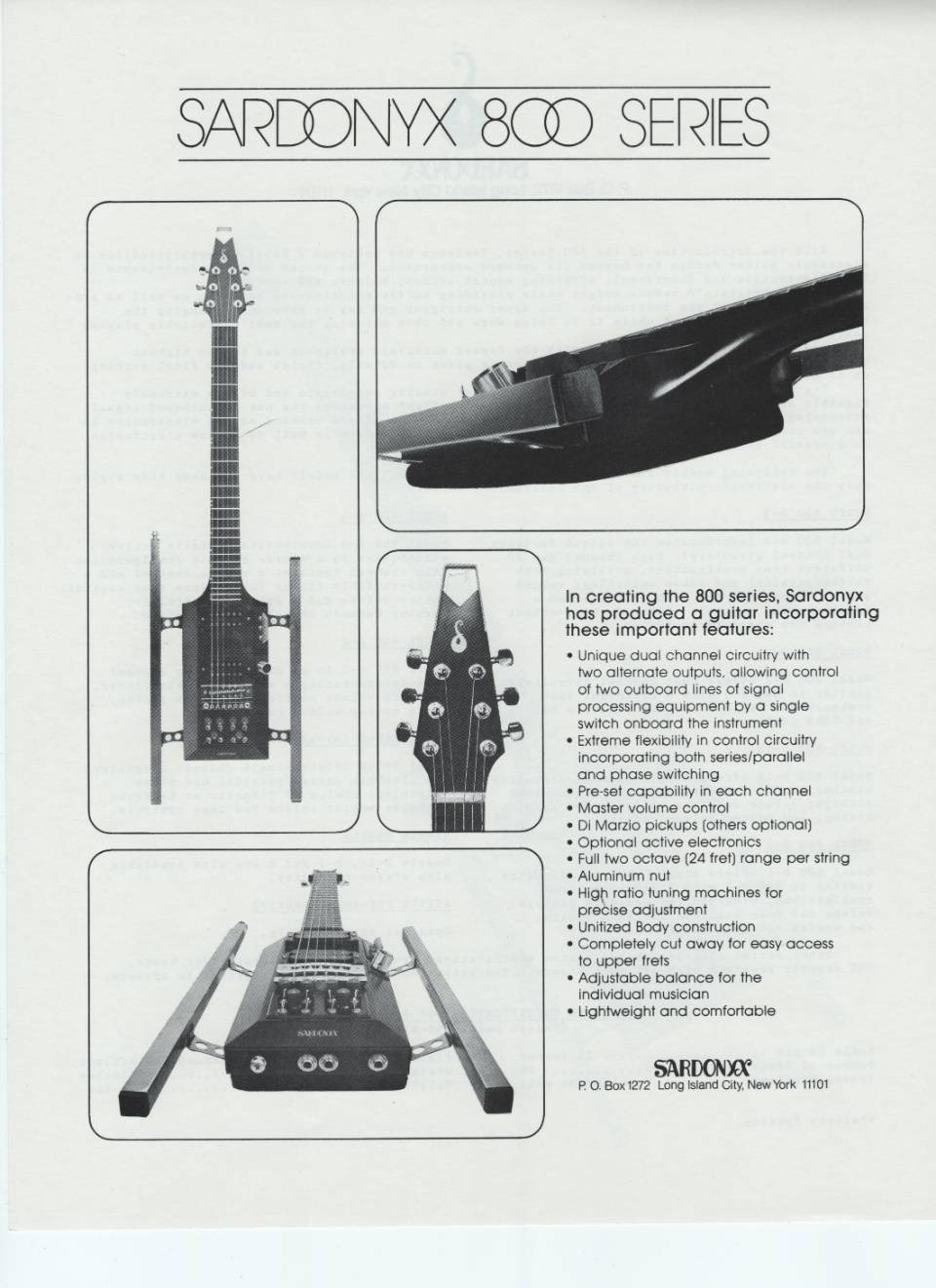 127814_5wku5zexjvrehz4n_58889.jpg
127814_5wku5zexjvrehz4n_58889.jpg
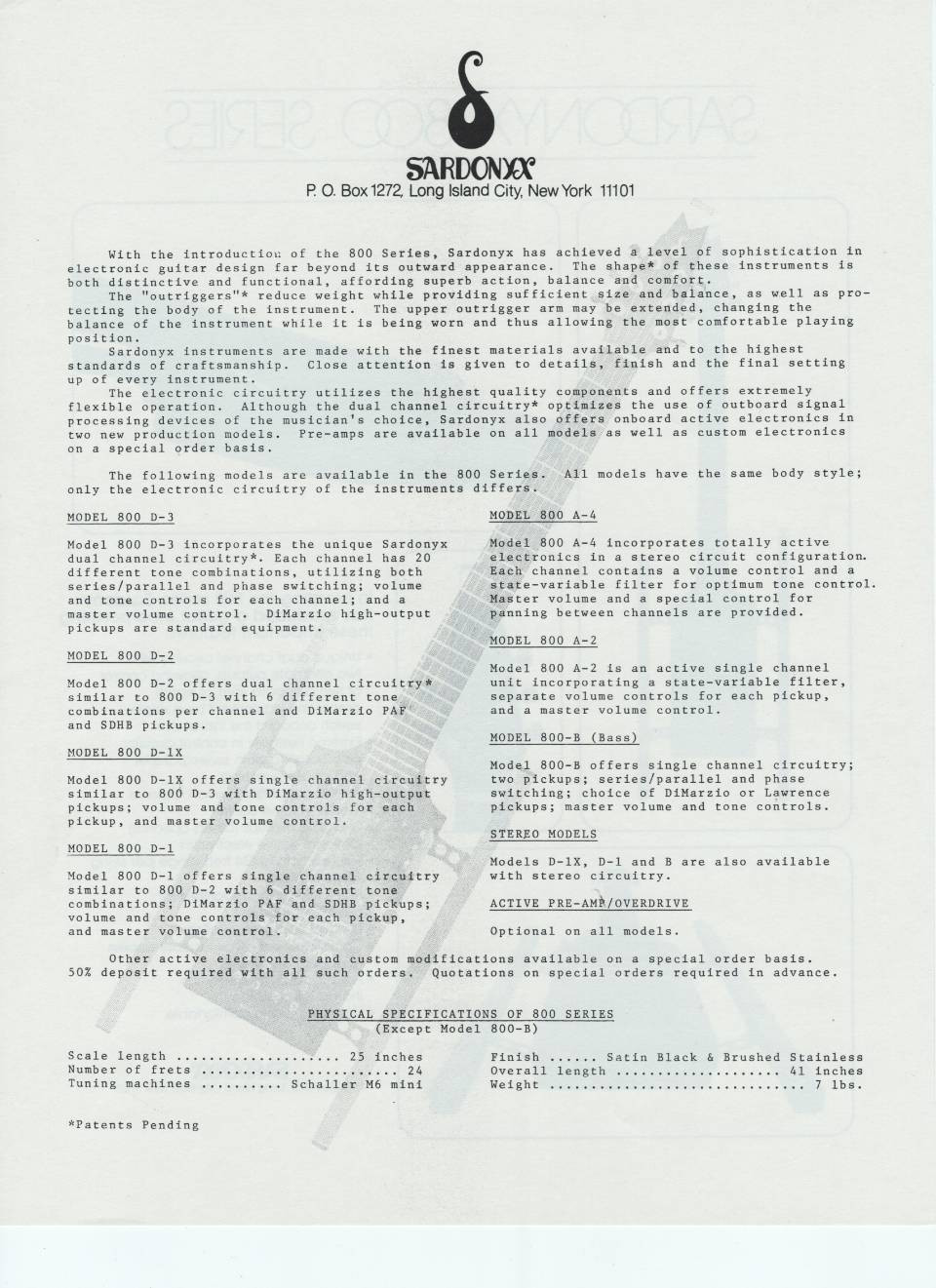 127814_5wku5zexjvrehz4n_58892.jpg
127814_5wku5zexjvrehz4n_58892.jpg
Hamer “Special”: A Gift from Rick Nielsen
A Hamer “Special” guitar, a custom white finish with a red stripe, was gifted to John Lennon by Rick Nielsen of Cheap Trick during the “Double Fantasy” sessions. It features “John Lennon” inscribed under the Hamer logo and “Rick N” on the truss rod cover.
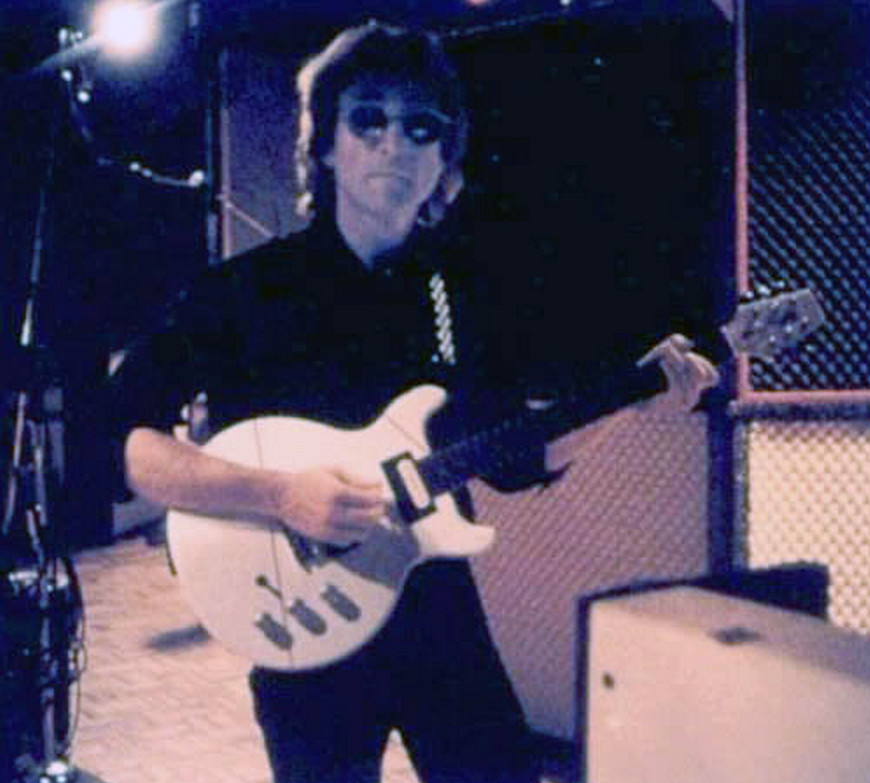 Hamer Special
Hamer Special
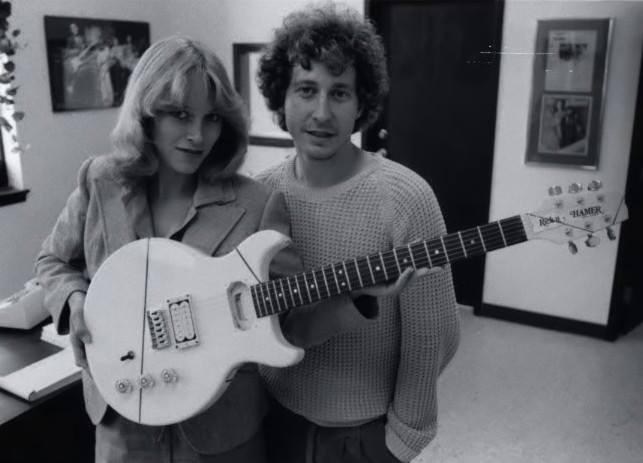 16684233_1459829537363146_4211002947521131016_n.jpg
16684233_1459829537363146_4211002947521131016_n.jpg
This Hamer “Special” is currently displayed at the Rock and Roll Hall of Fame.
Red Fender Stratocaster: The Last Photo
In 1980, Lennon acquired a candy apple red Fender Stratocaster with 22-carat gold electroplated brass hardware. Annie Leibovitz famously photographed him playing this guitar in bed on his last day. This photo became iconic, used for promo and the inner sleeve of “The John Lennon Collection” album.
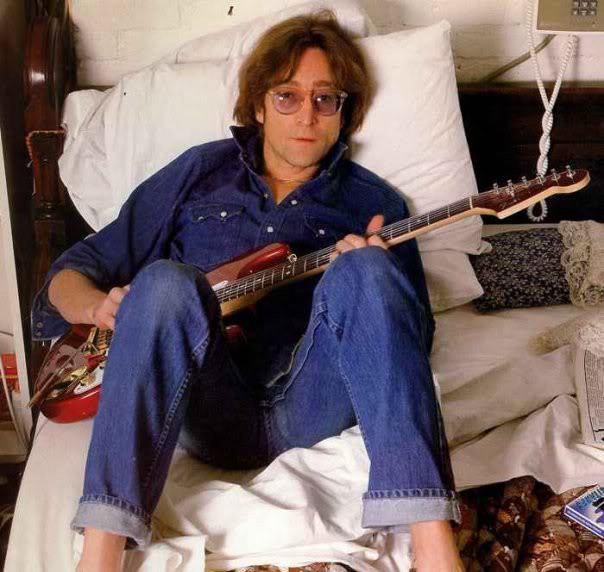 Lennon with red strat 1974
Lennon with red strat 1974
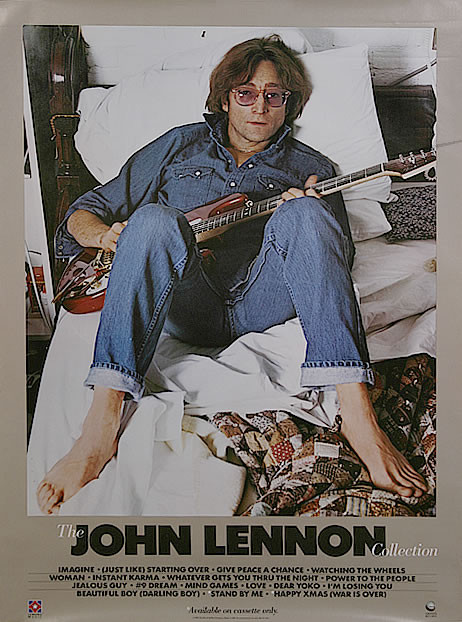 John-Lennon-The-John-Lennon-C-456109
John-Lennon-The-John-Lennon-C-456109
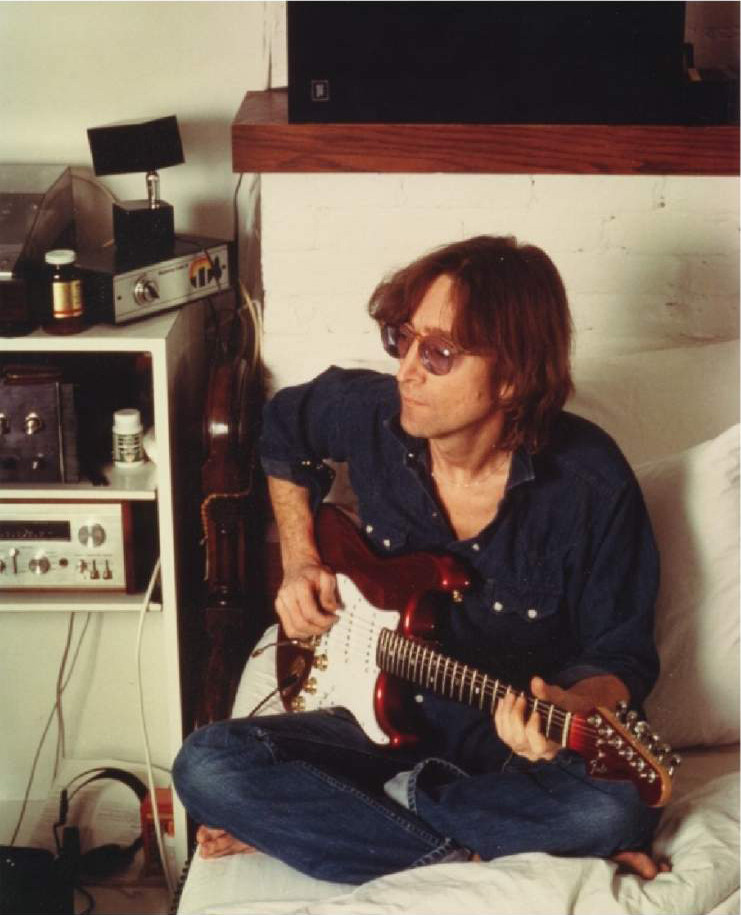 RedStratLastDay
RedStratLastDay
Cream Fender Telecaster with Bigsby: Imagine Sessions
A Cream Fender Telecaster with a Bigsby tailpiece is seen in photos from the “Imagine” recording sessions. While it’s unclear if Lennon owned it, it’s prominently featured in session photos.
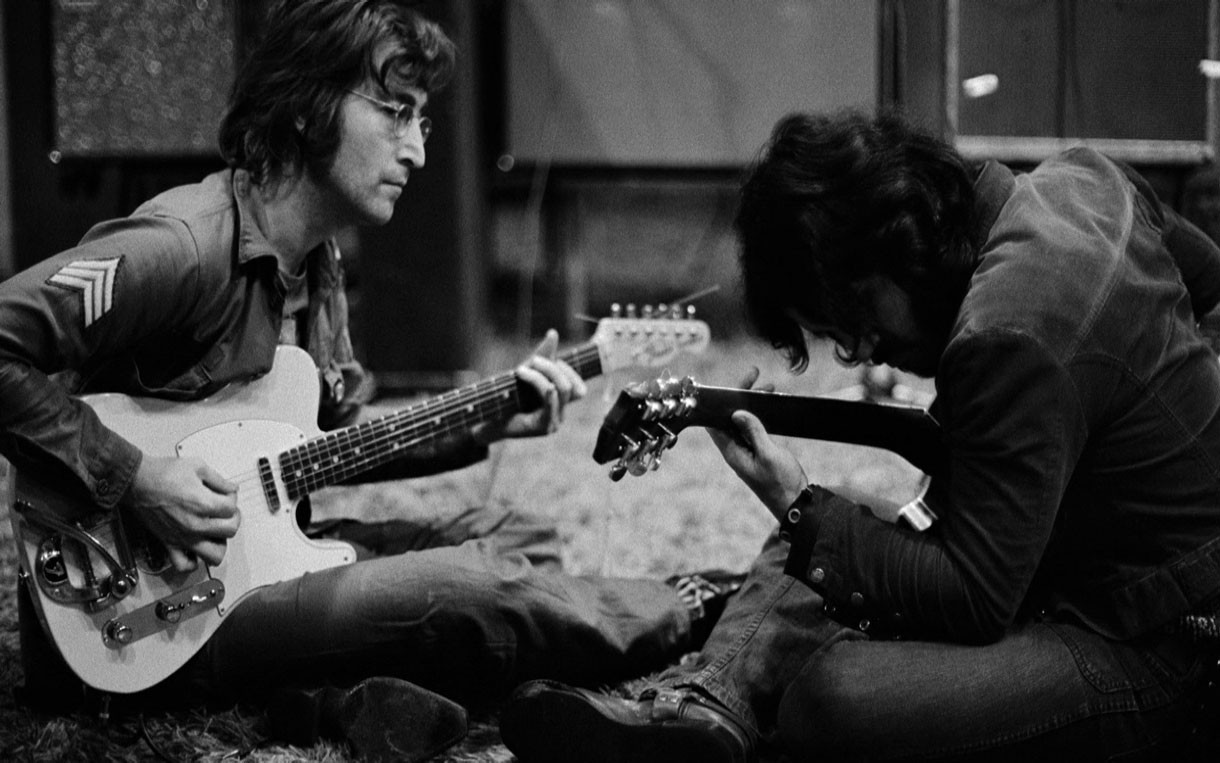 1465355A
1465355A
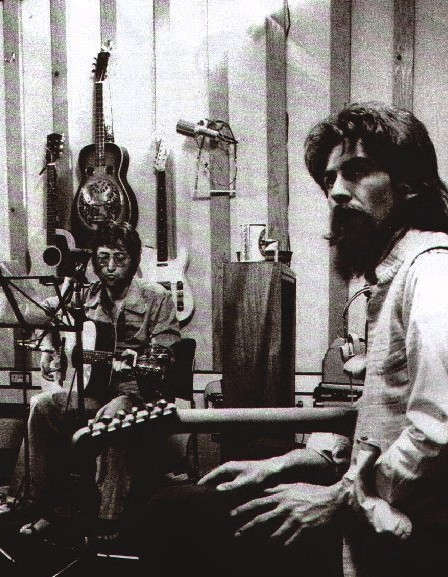 White Tele
White Tele
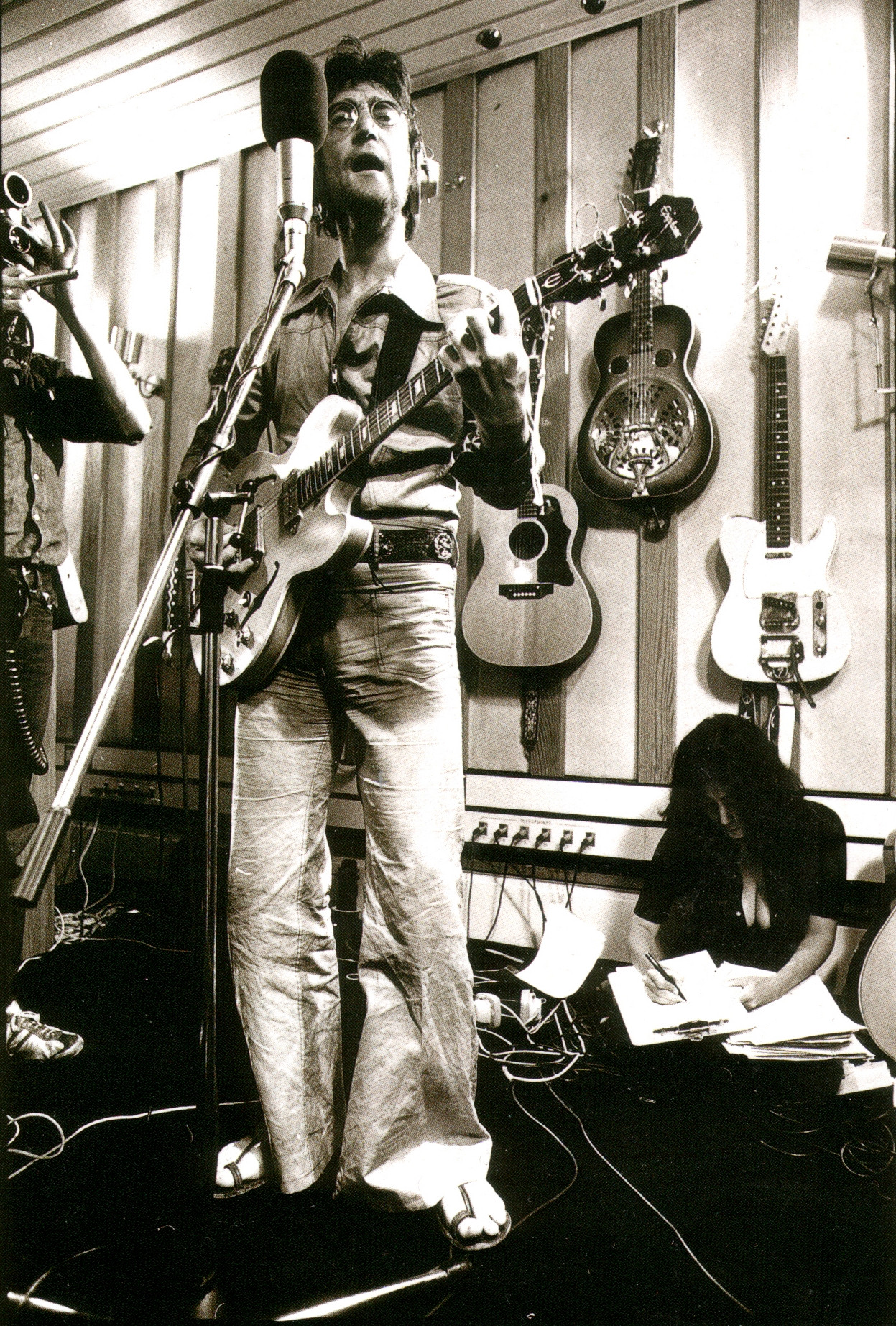 John Lennon Imagine sessions with Casino and Tele bigsby on the wall
John Lennon Imagine sessions with Casino and Tele bigsby on the wall
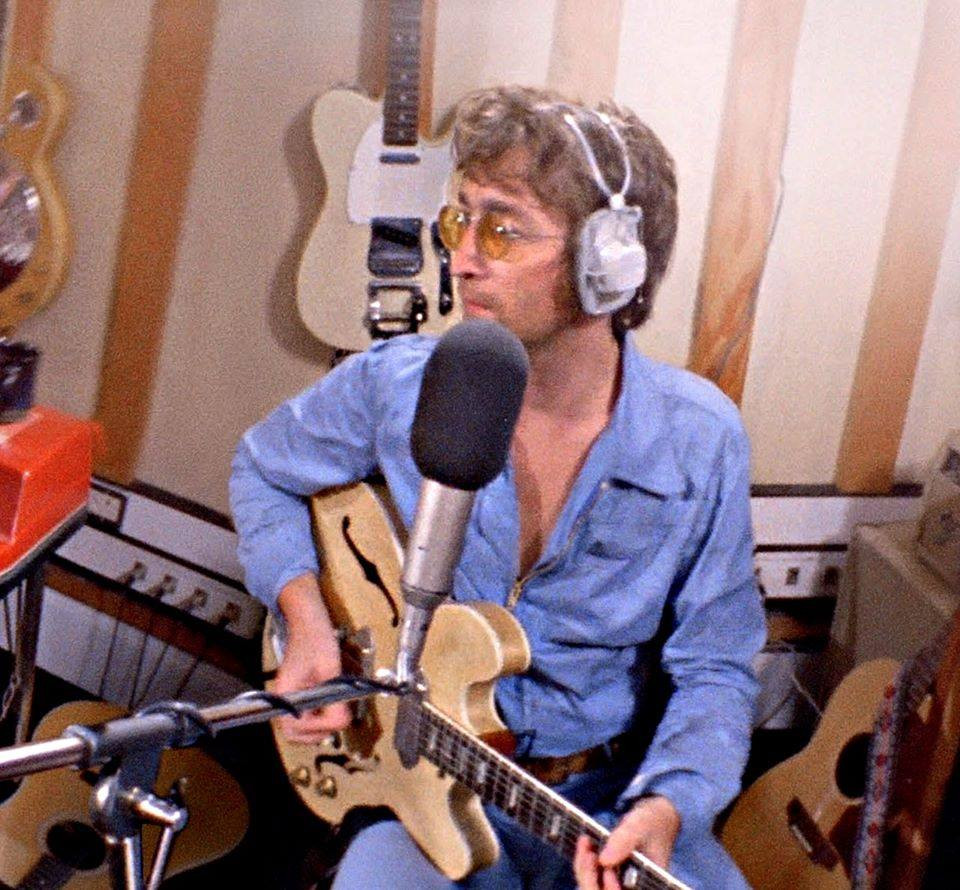 54515049_806115626413212_2853108996200464384_n.jpg
54515049_806115626413212_2853108996200464384_n.jpg
Yamaha CJ-52 Dragon Acoustic: A Custom Masterpiece
The Yamaha CJ-52 Dragon Acoustic Guitar is a custom masterpiece created for John Lennon. Inspired by Paul Simon’s Yamaha acoustic, Lennon commissioned Yamaha in 1977 to build him a CJ-52 model with a Dragon motif using traditional Japanese Maki-e art.
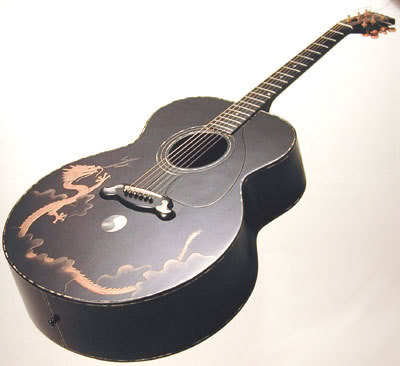 G9bYamahaDragon
G9bYamahaDragon
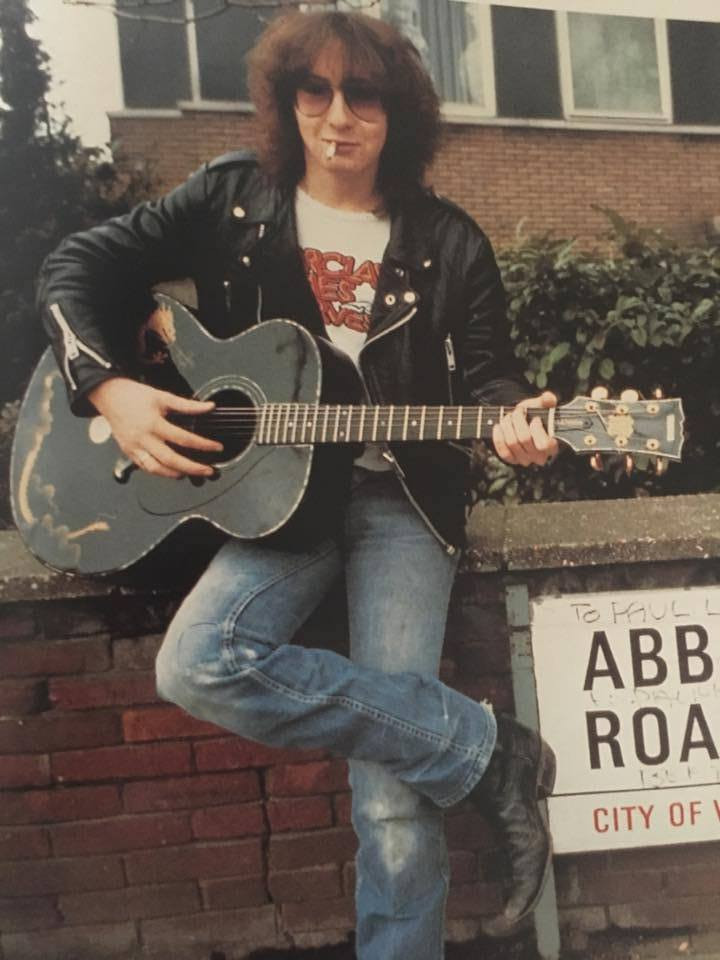 19398134_10155405991919814_1456526667_n.jpg
19398134_10155405991919814_1456526667_n.jpg
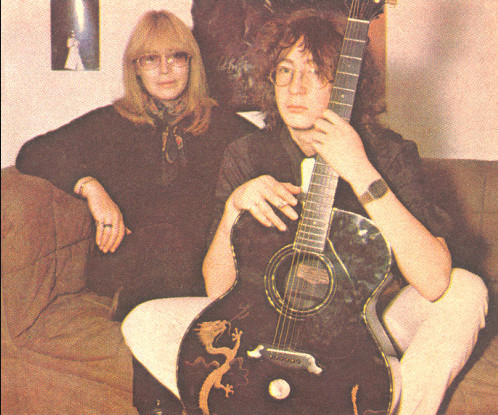 snip20161106_3.png
snip20161106_3.png
Julian Lennon reportedly considered this guitar his favorite from his father’s collection.
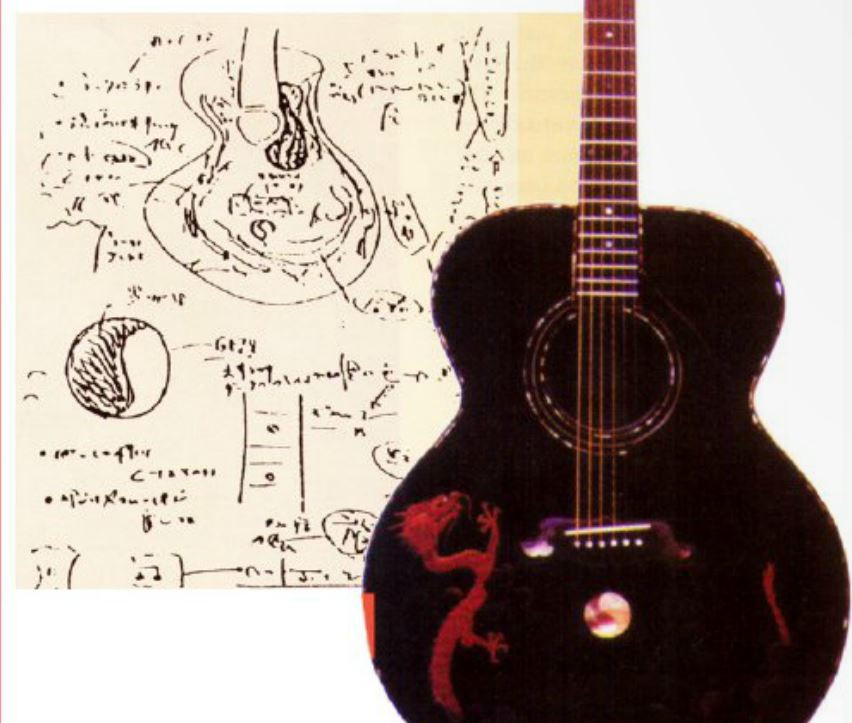 JLSketch
JLSketch
Yamaha CJ-52: Template for Signature Models
The Yamaha CJ-52 model, without the dragon inlay, was used by John Lennon, Jimmy Page, and Paul Simon and served as the template for their signature Yamaha guitars.
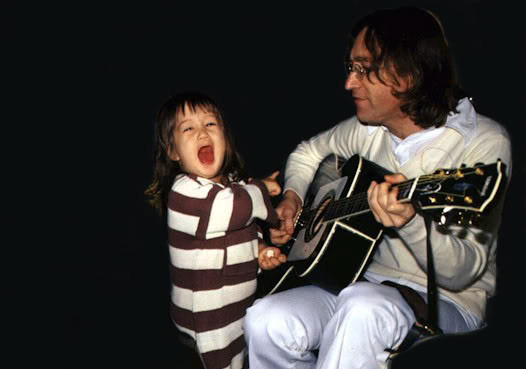 JohnSeanguitar
JohnSeanguitar
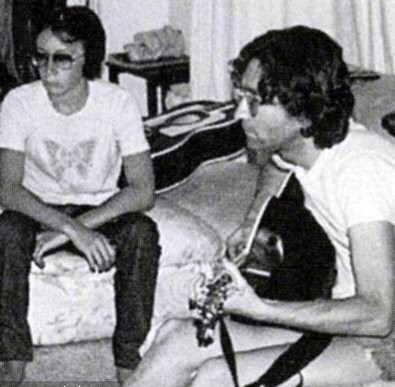 julian_lennon_john_last_photo
julian_lennon_john_last_photo
 1450241_10151833347706056_307874162_n.jpg
1450241_10151833347706056_307874162_n.jpg
Additional Guitars and Instruments
Beyond these main instruments, photos and records reveal Lennon with various other guitars, including Fender Telecasters, a Fender VI 6-string bass, and a Hofner President guitar gifted to roadie Tappy Wright.
 133
133
 john-66.jpg
john-66.jpg
 700104.jpg
700104.jpg
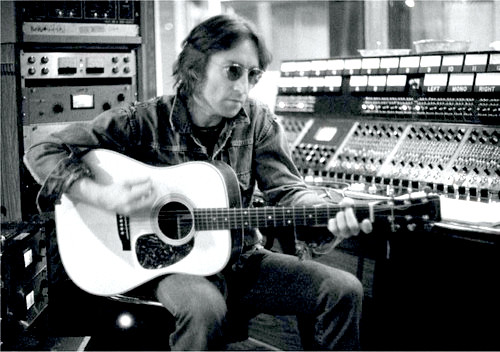 185
185
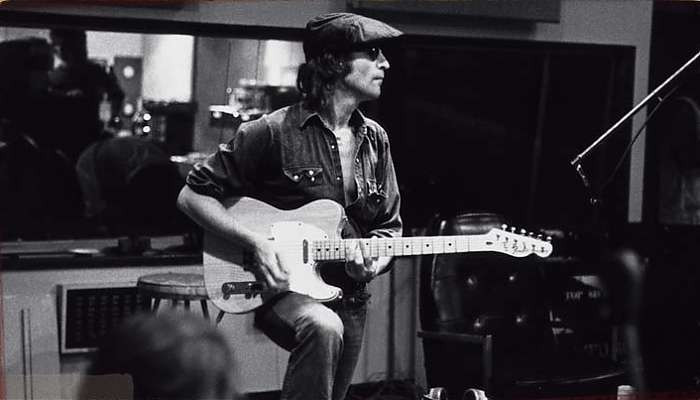 John Lennon Tele
John Lennon Tele
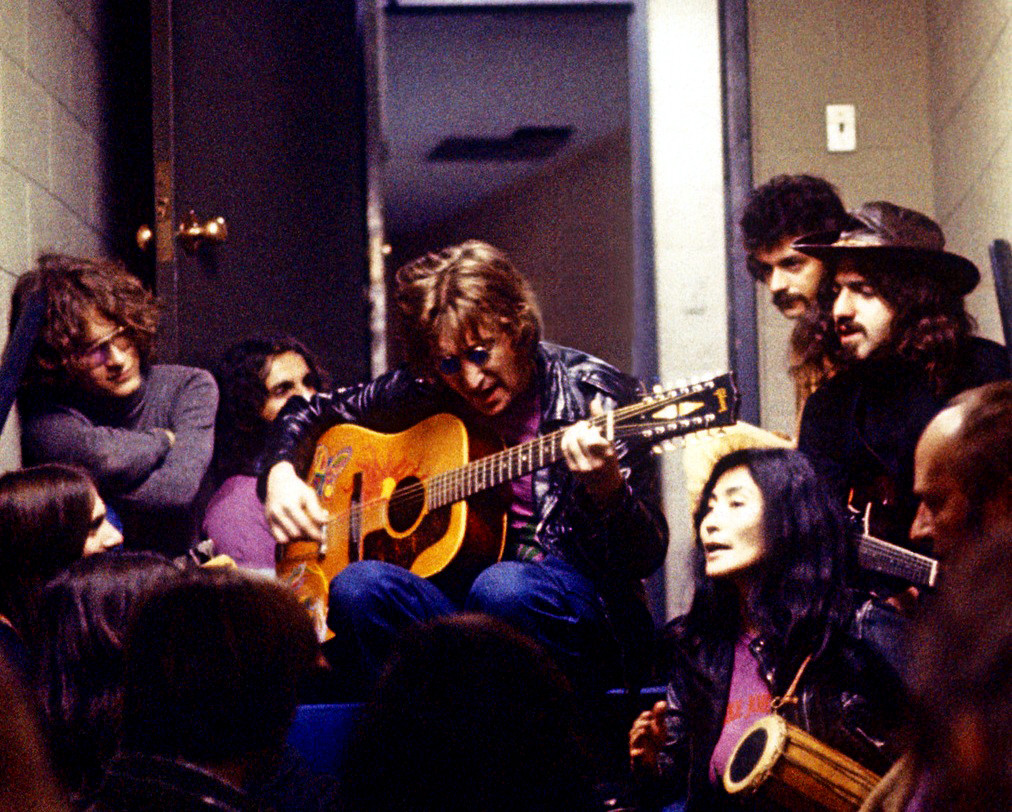 John Lennon and Yoko Ono File Photos – 1971
John Lennon and Yoko Ono File Photos – 1971
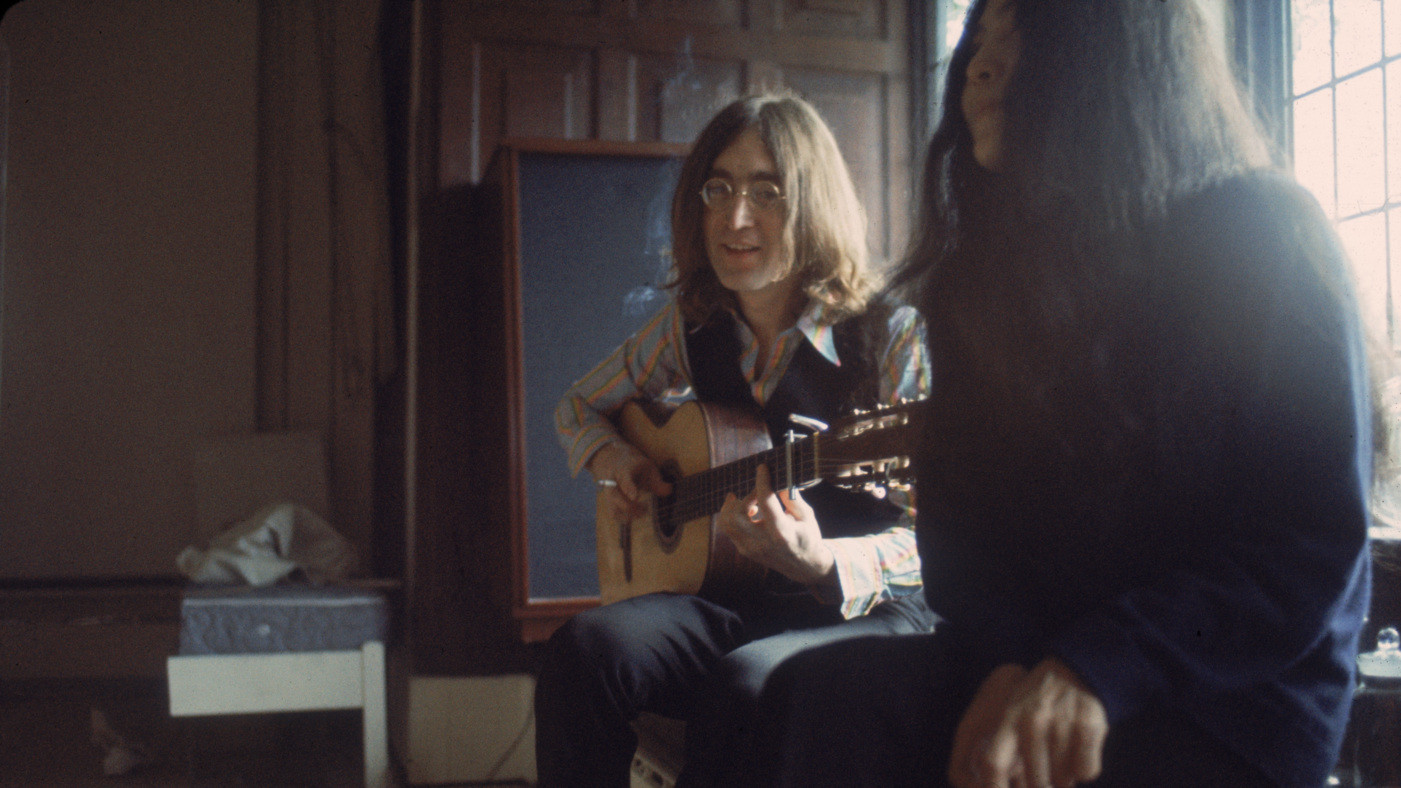 1401×788-73683720.jpg
1401×788-73683720.jpg
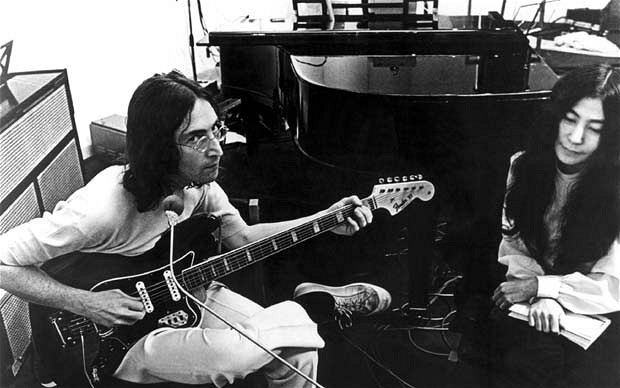 johnlennon_2043699i
johnlennon_2043699i
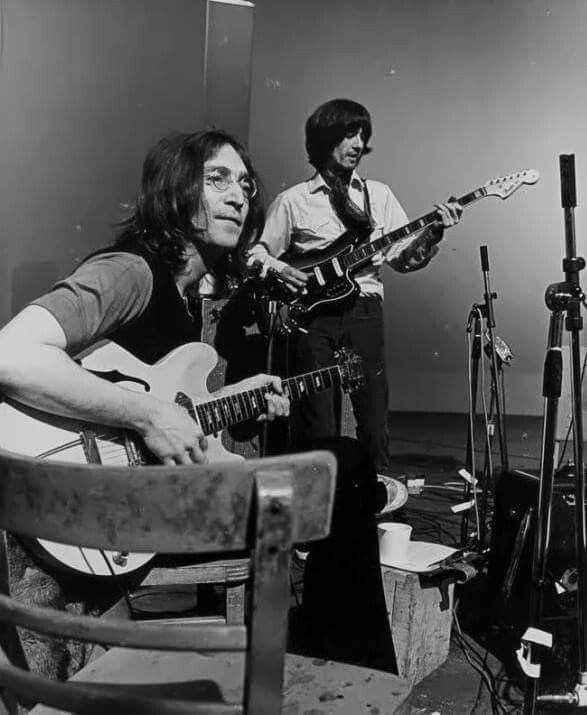 v12.jpg
v12.jpg
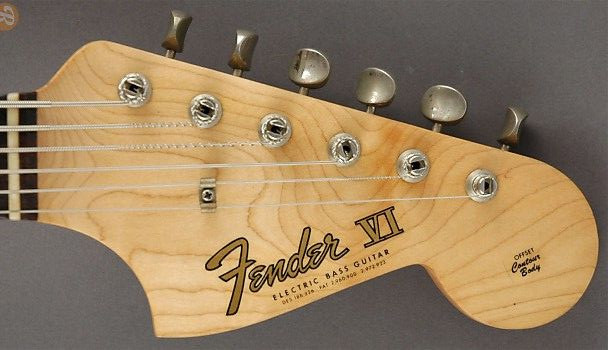 v1-1.jpg
v1-1.jpg
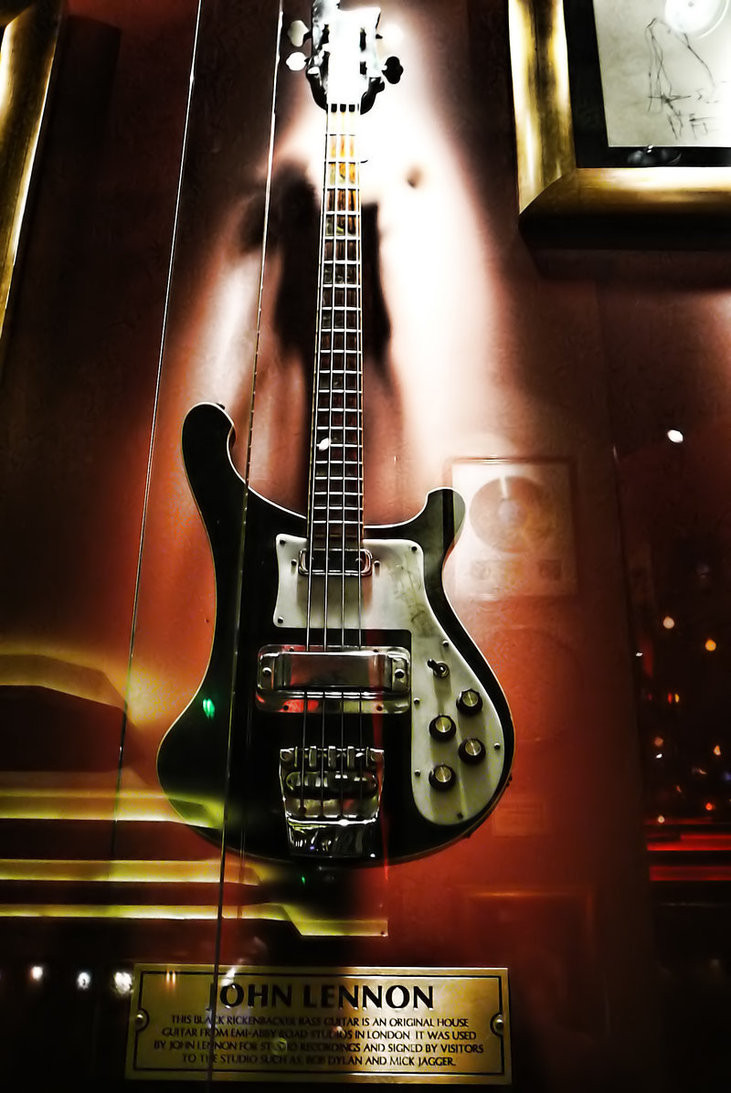 John_Lennon__s_Guitar_by_minm01
John_Lennon__s_Guitar_by_minm01
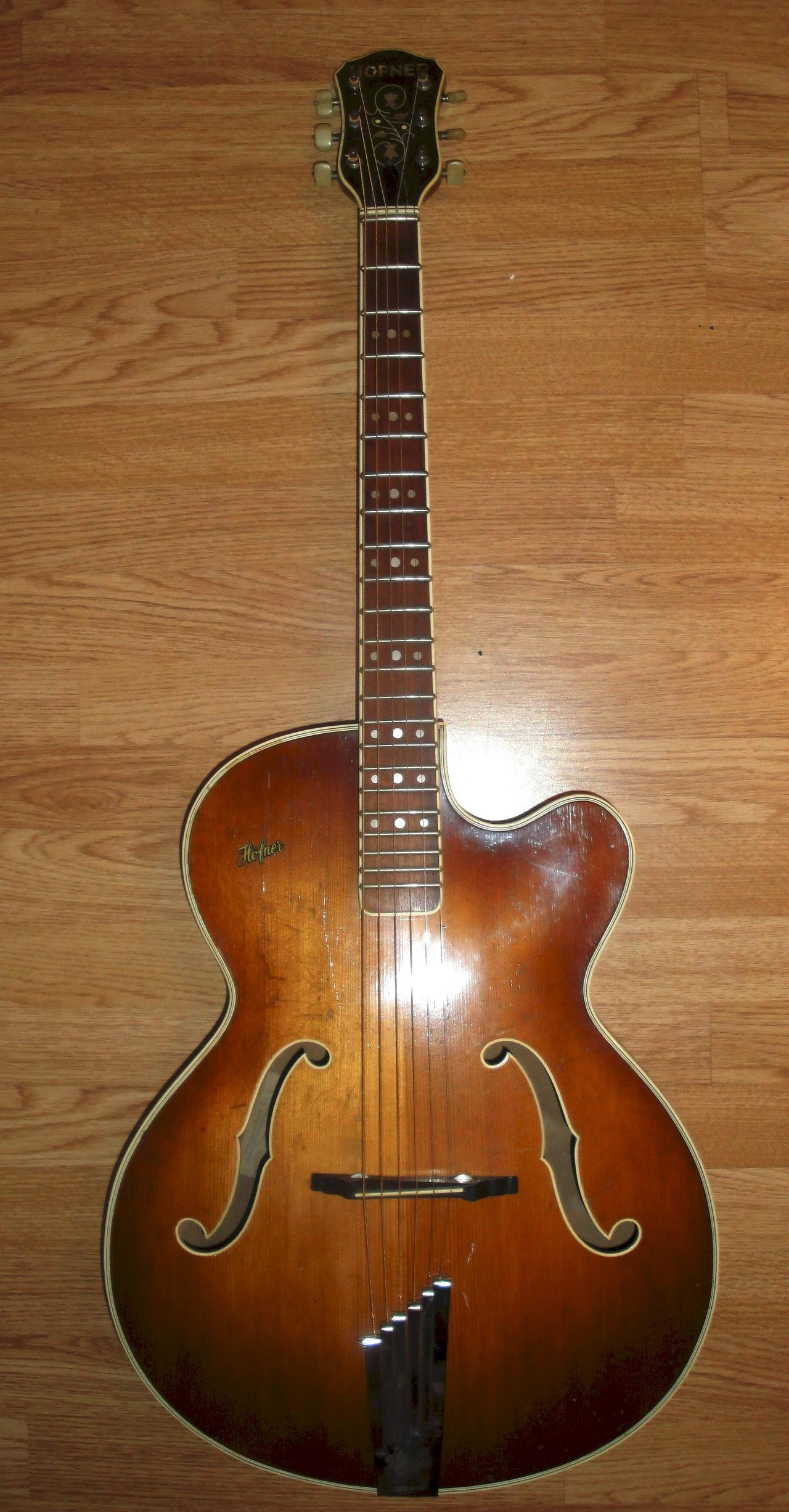 HofnerPresident
HofnerPresident
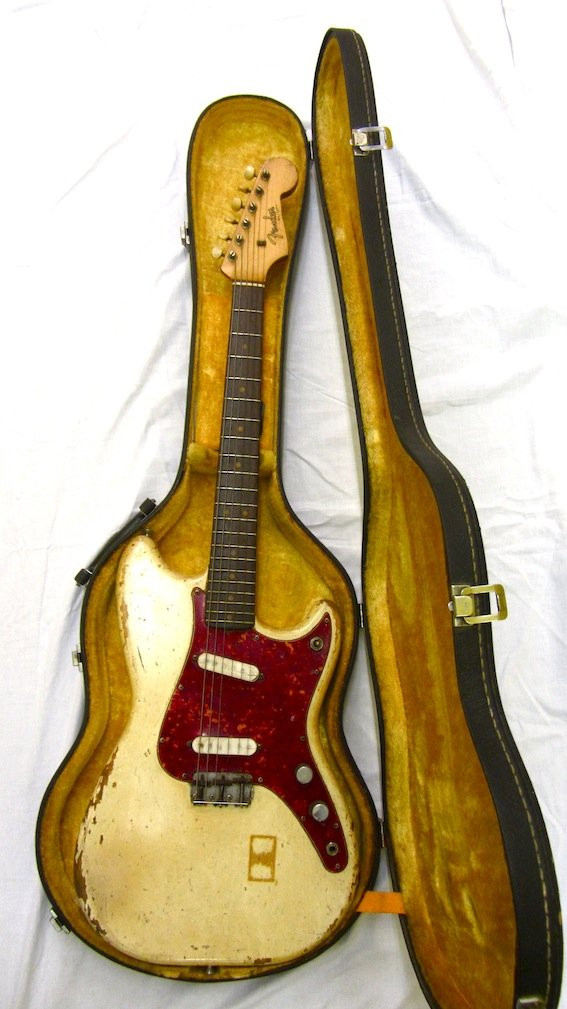 4598896107.jpg
4598896107.jpg
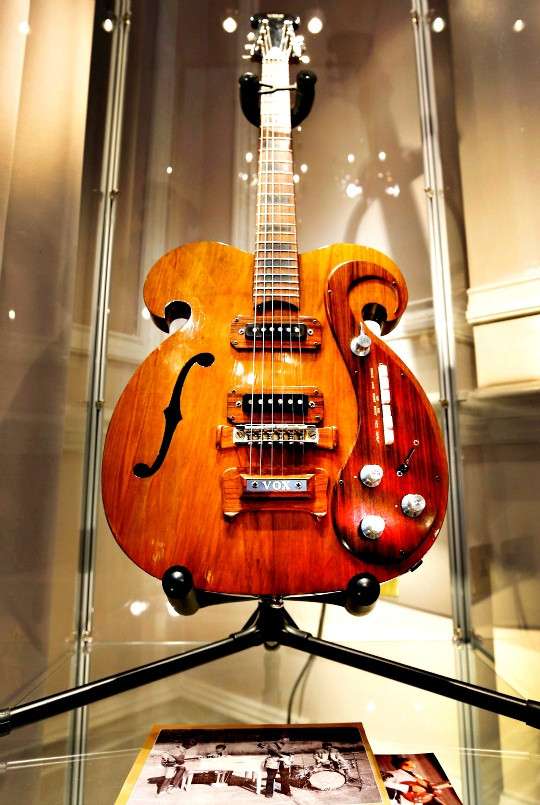 b_1368966111_540x540.jpg
b_1368966111_540x540.jpg
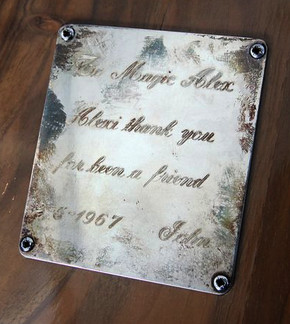 Snip20150222_2.png
Snip20150222_2.png
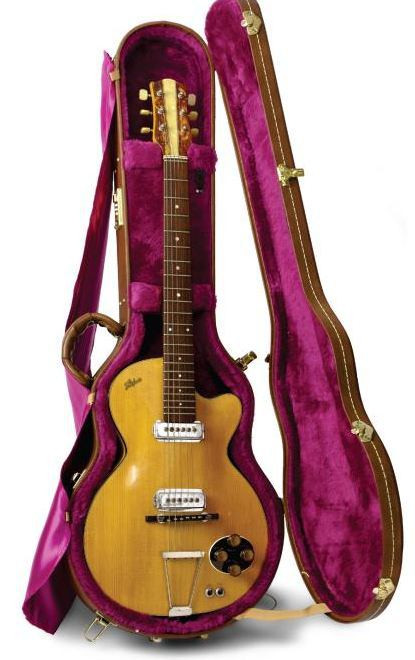 beatles-memorabilia5.jpg
beatles-memorabilia5.jpg
Conclusion: The Enduring Legacy of Lennon’s Sound
John Lennon’s guitars were more than just instruments; they were extensions of his creative spirit, each one playing a role in crafting the soundtrack of a generation. From the budget-friendly Gallotone Champion to the iconic Rickenbacker 325 and the versatile Epiphone Casino, Lennon’s guitar choices reflected his evolving musical styles and his relentless pursuit of sonic innovation. These guitars, now museum pieces and auction treasures, stand as tangible links to a musical genius whose impact continues to resonate today, inspiring countless guitarists and songwriters worldwide. Exploring John Lennon guitars is not just about cataloging instruments; it’s about understanding the tools that shaped a legend and the music that changed the world.
